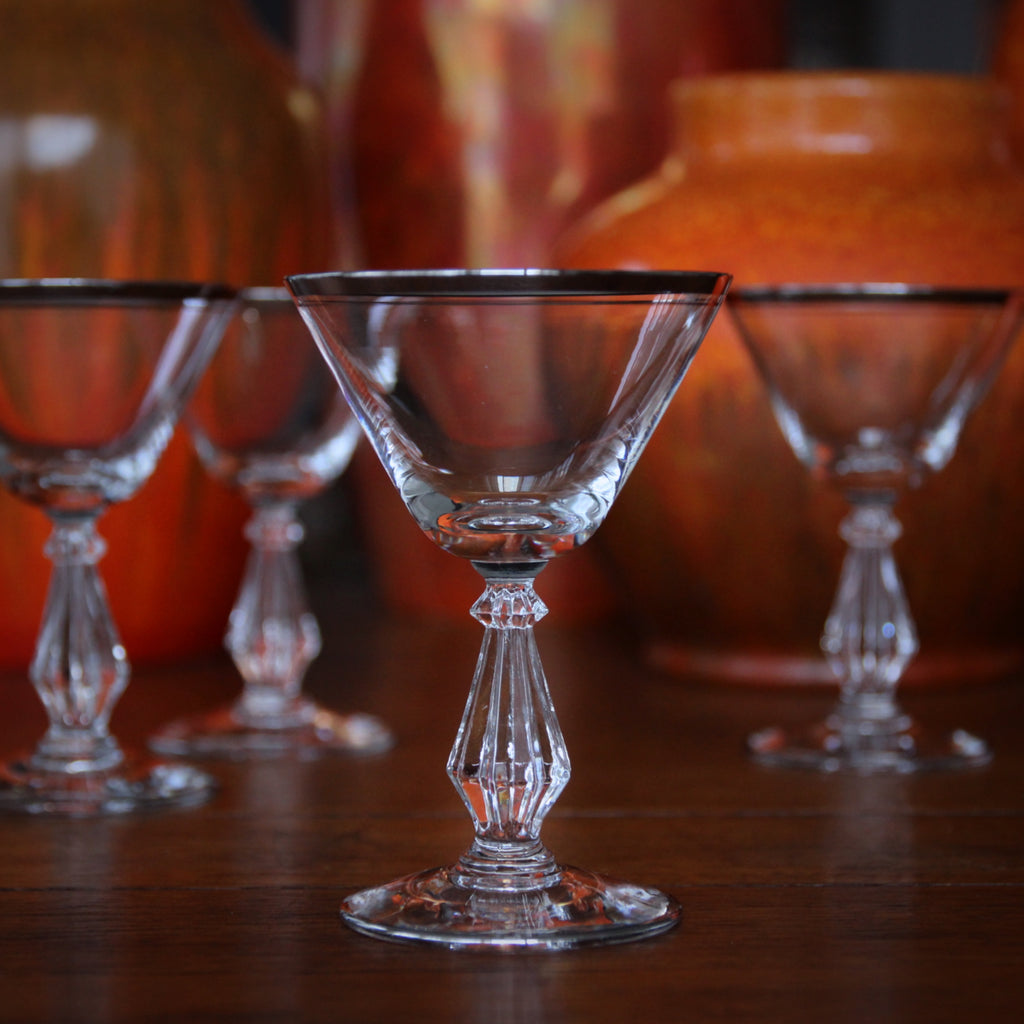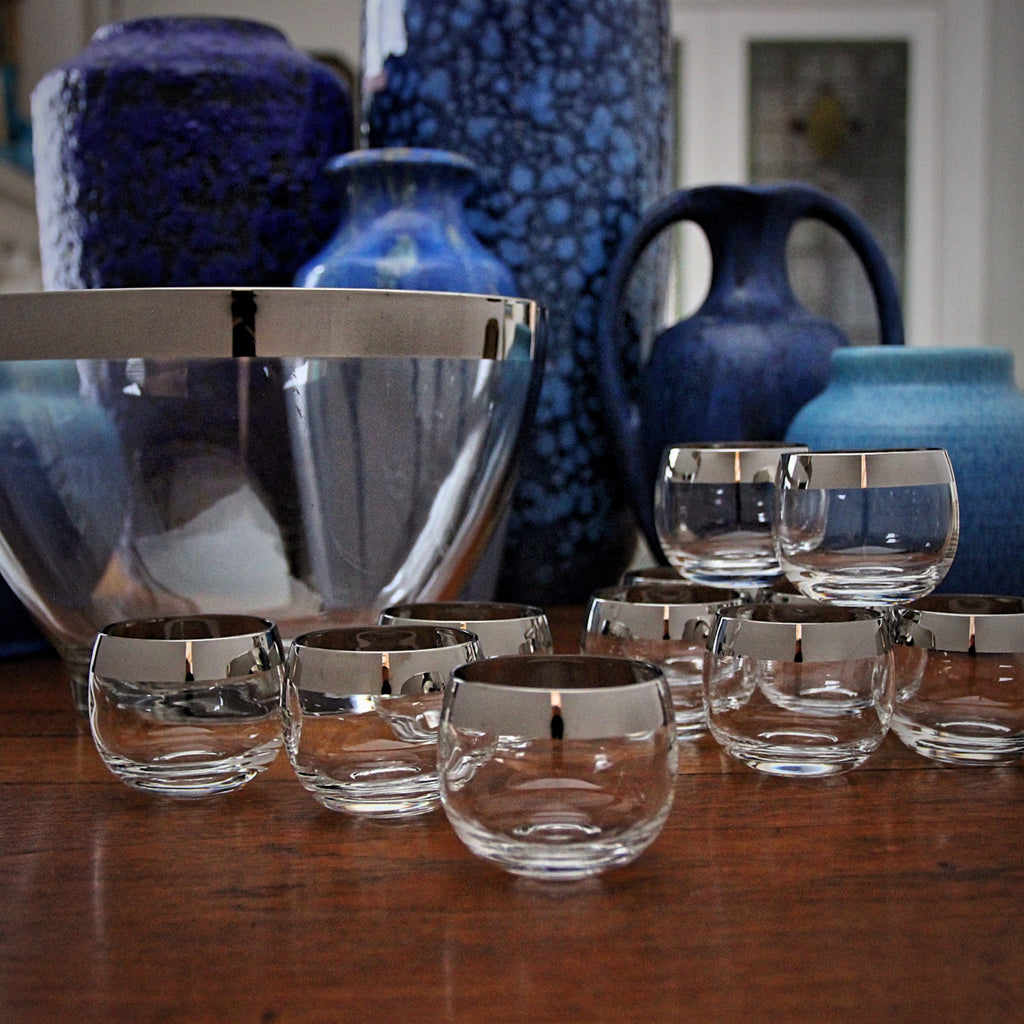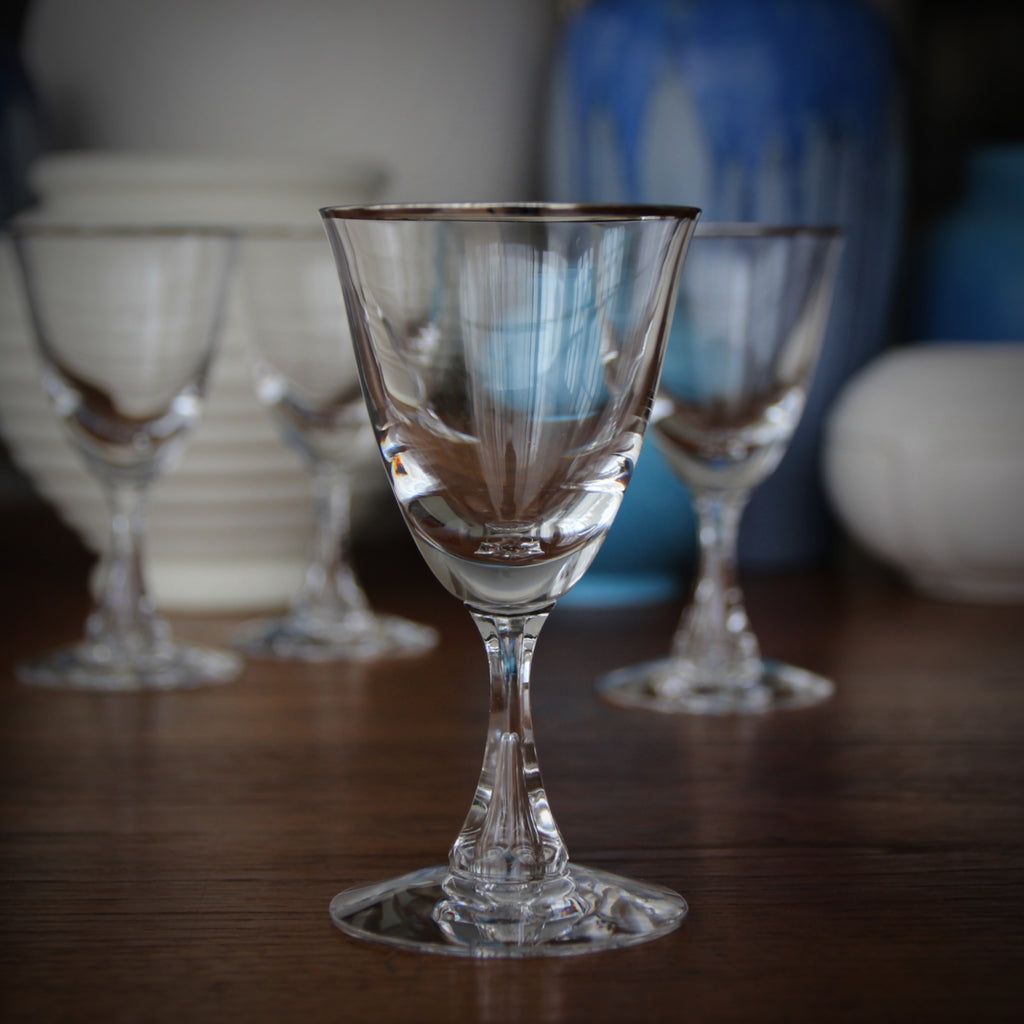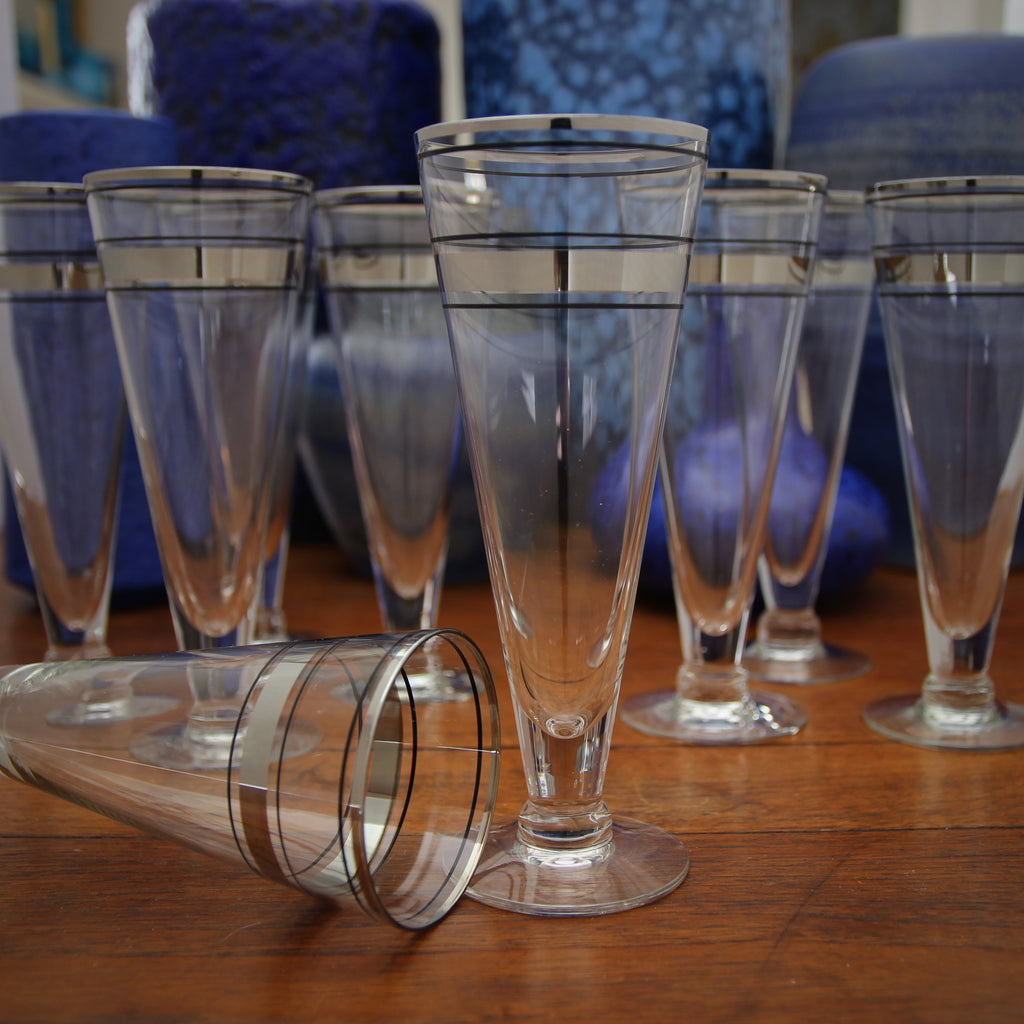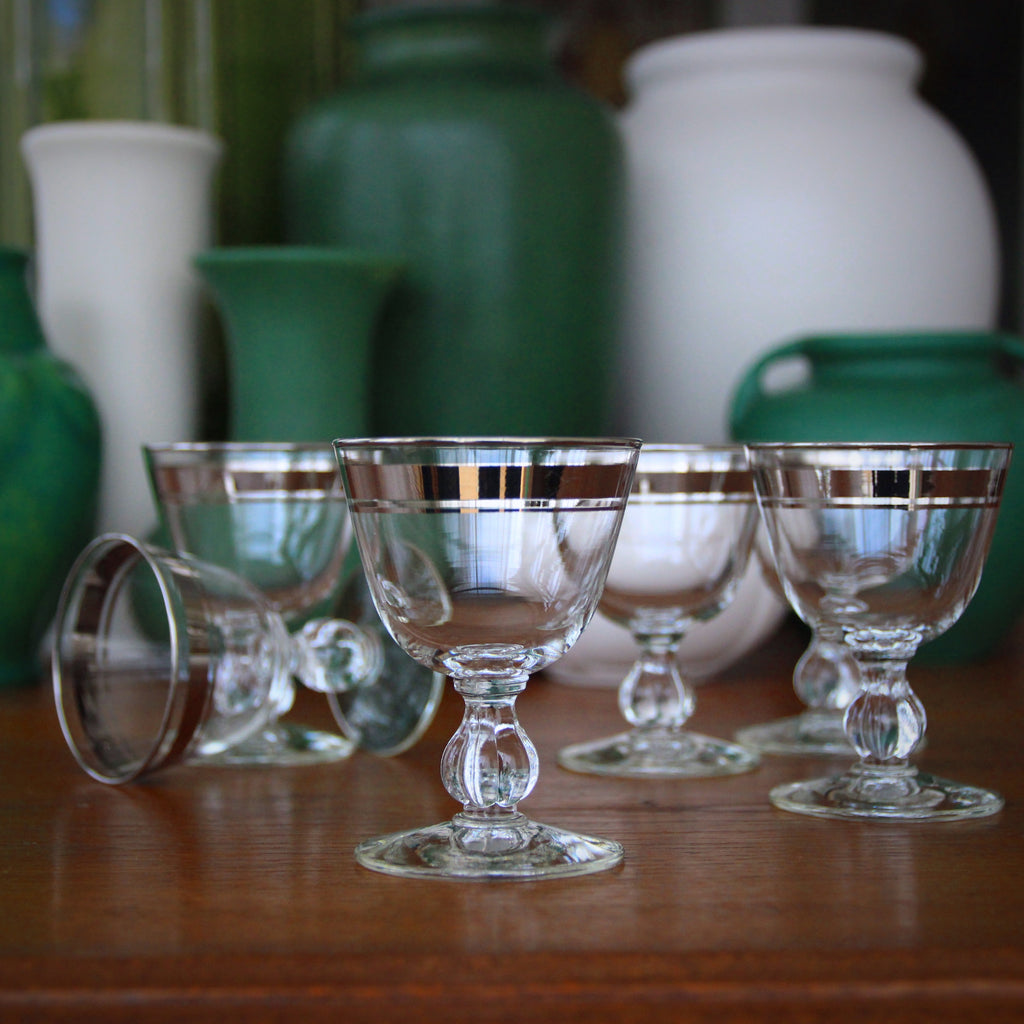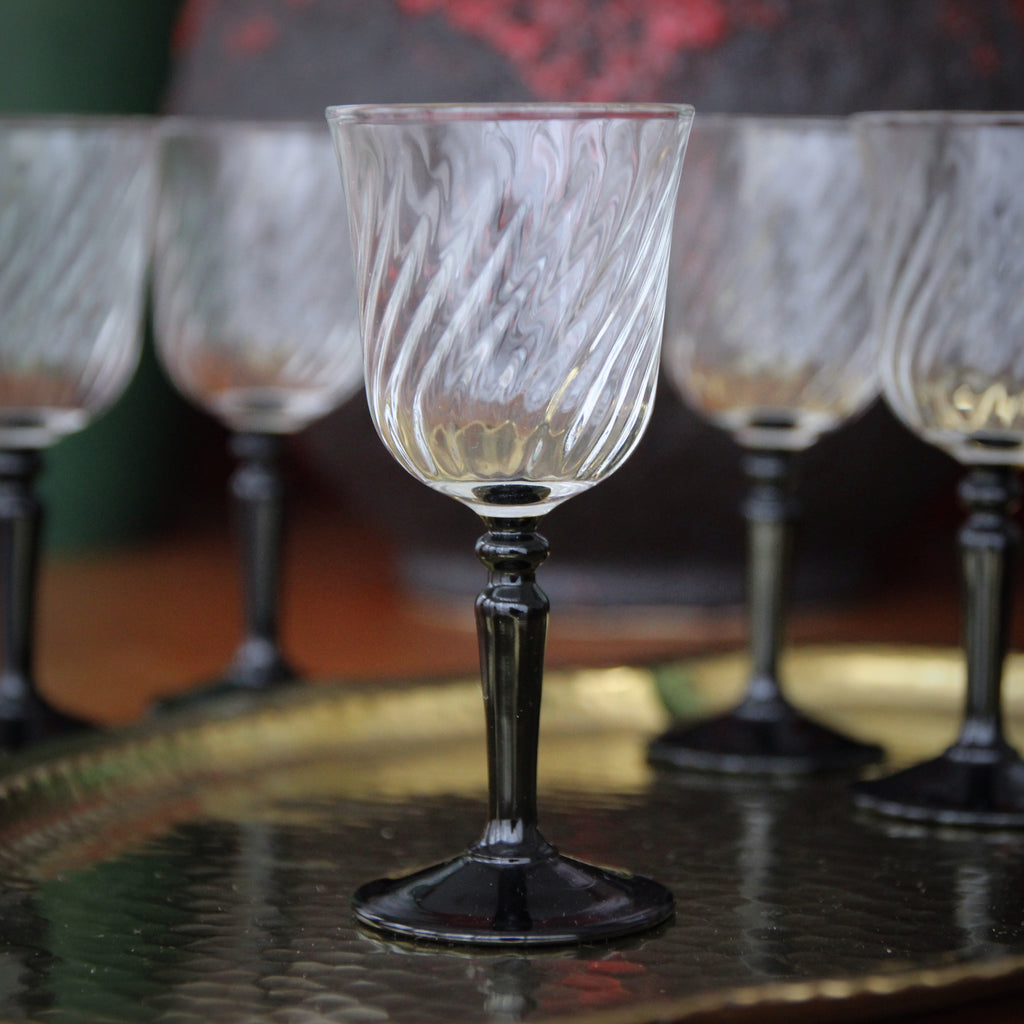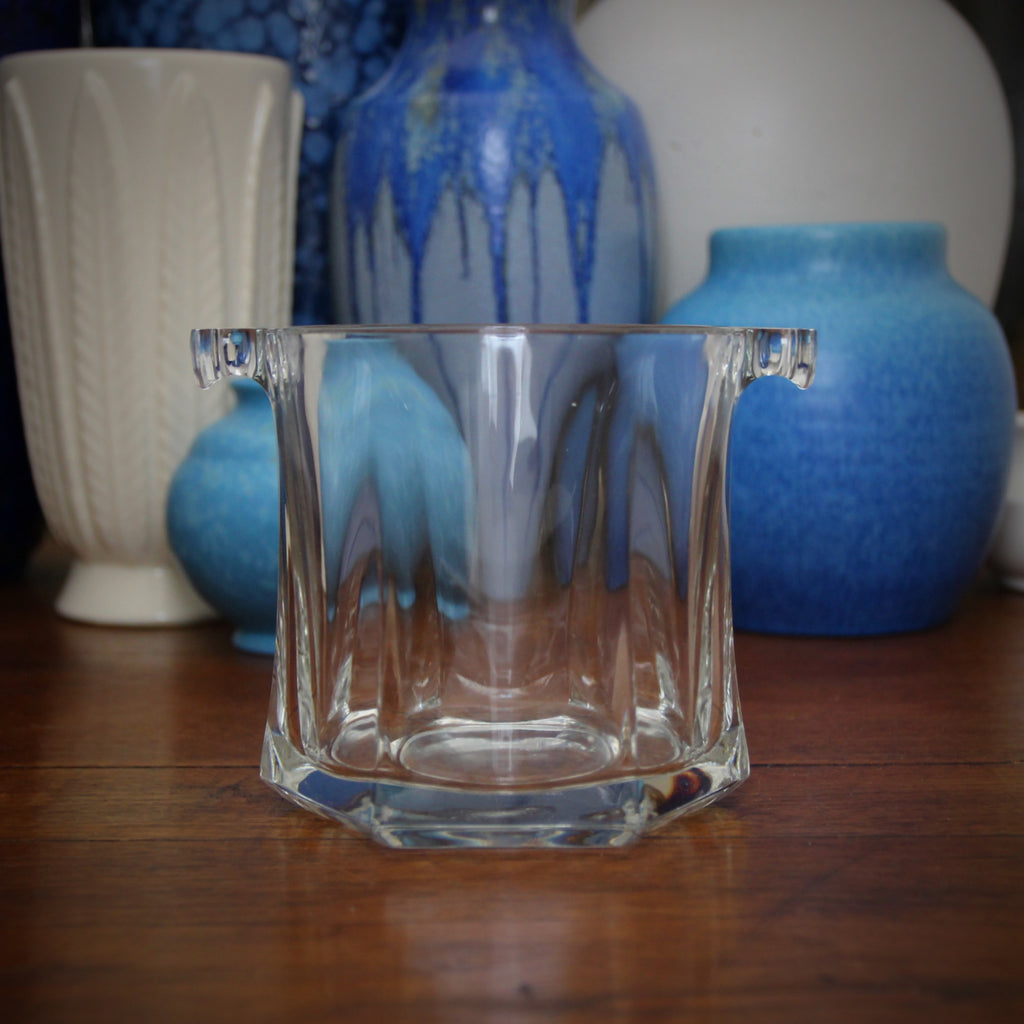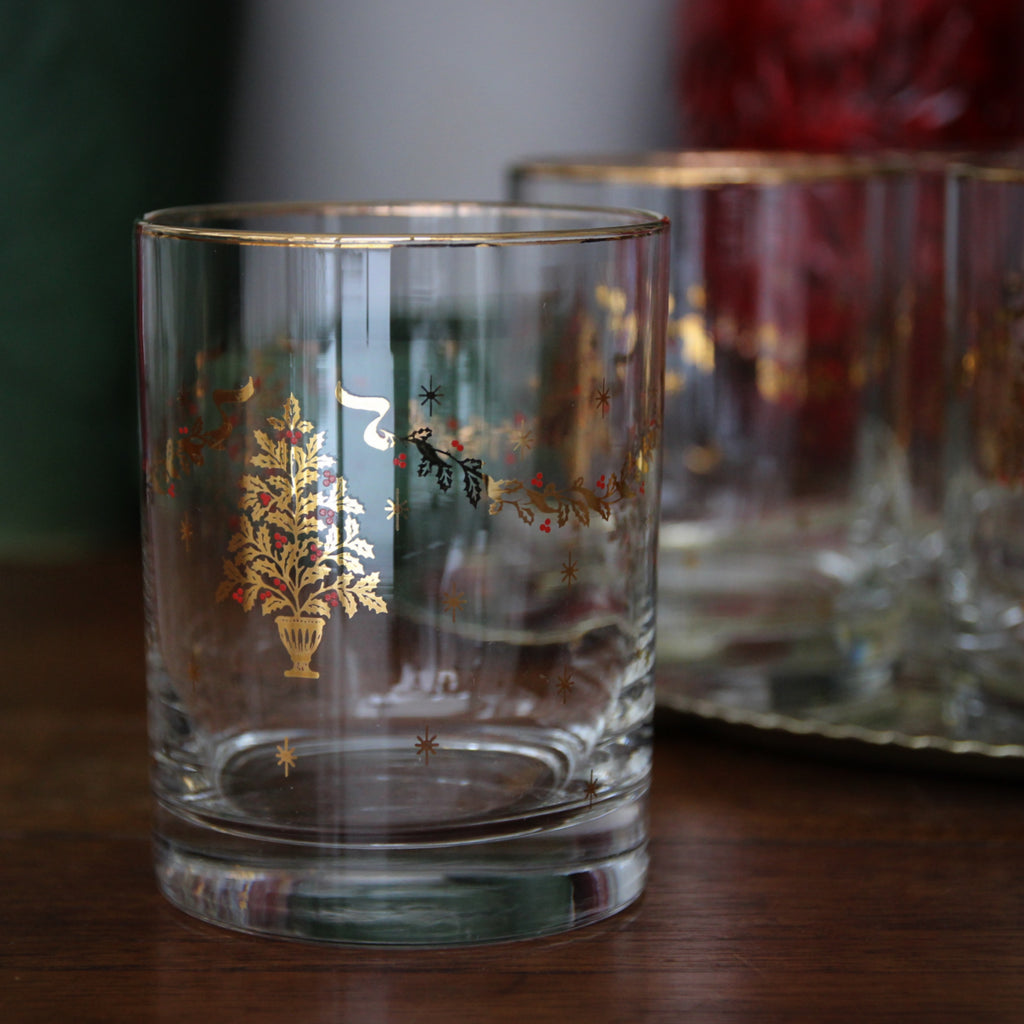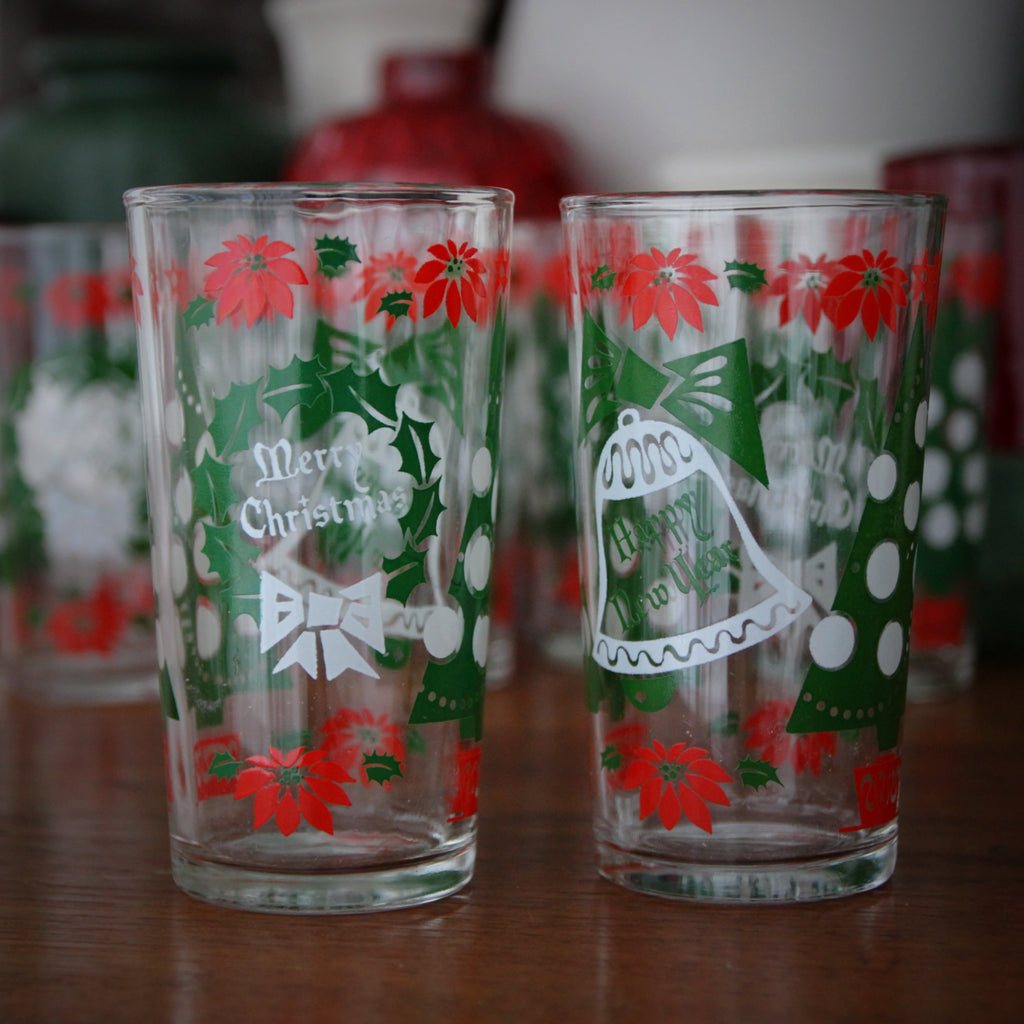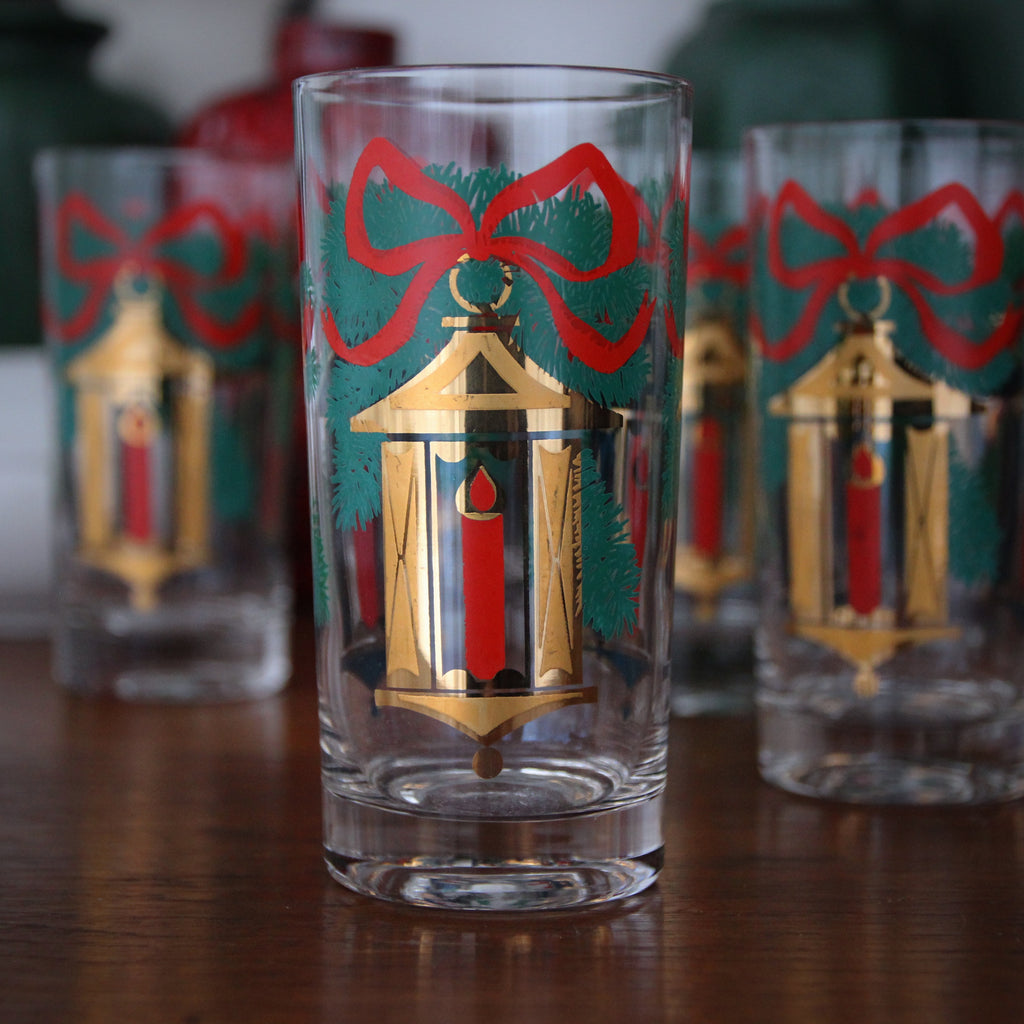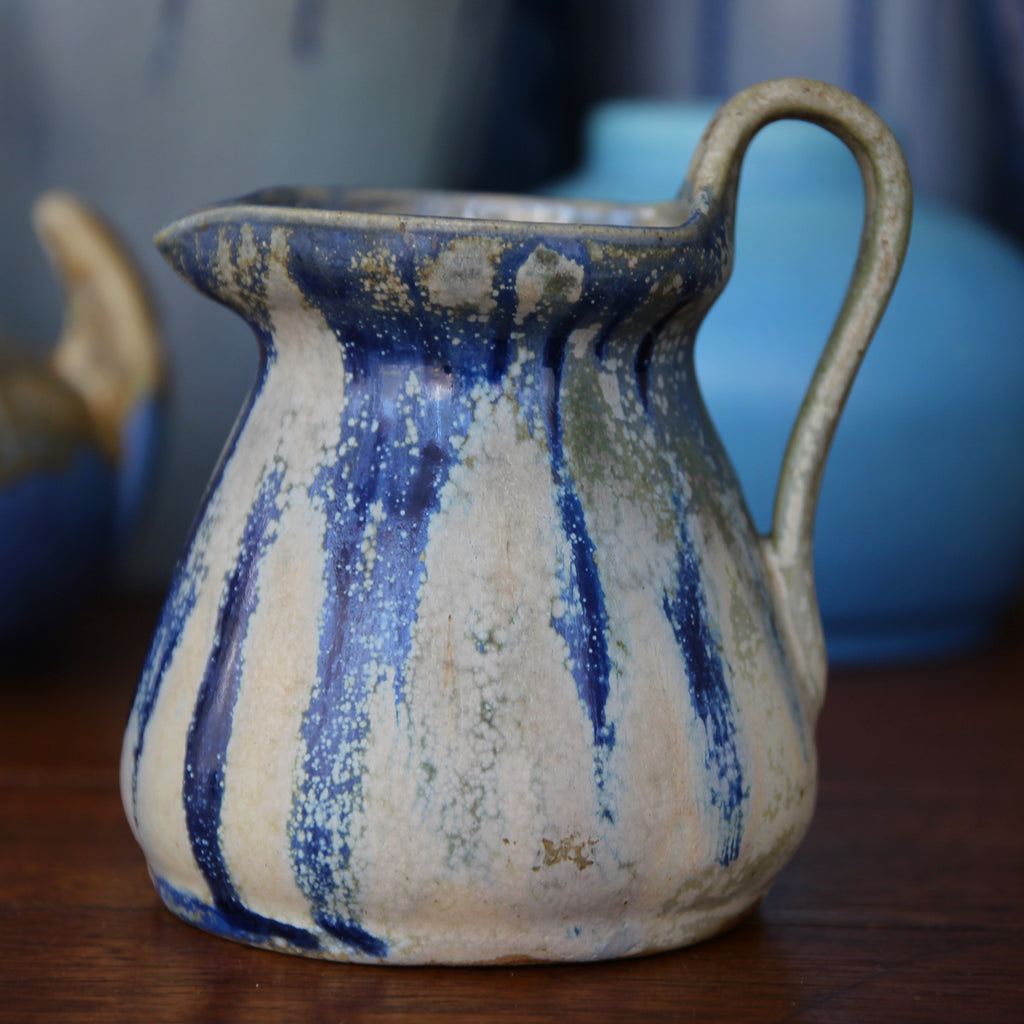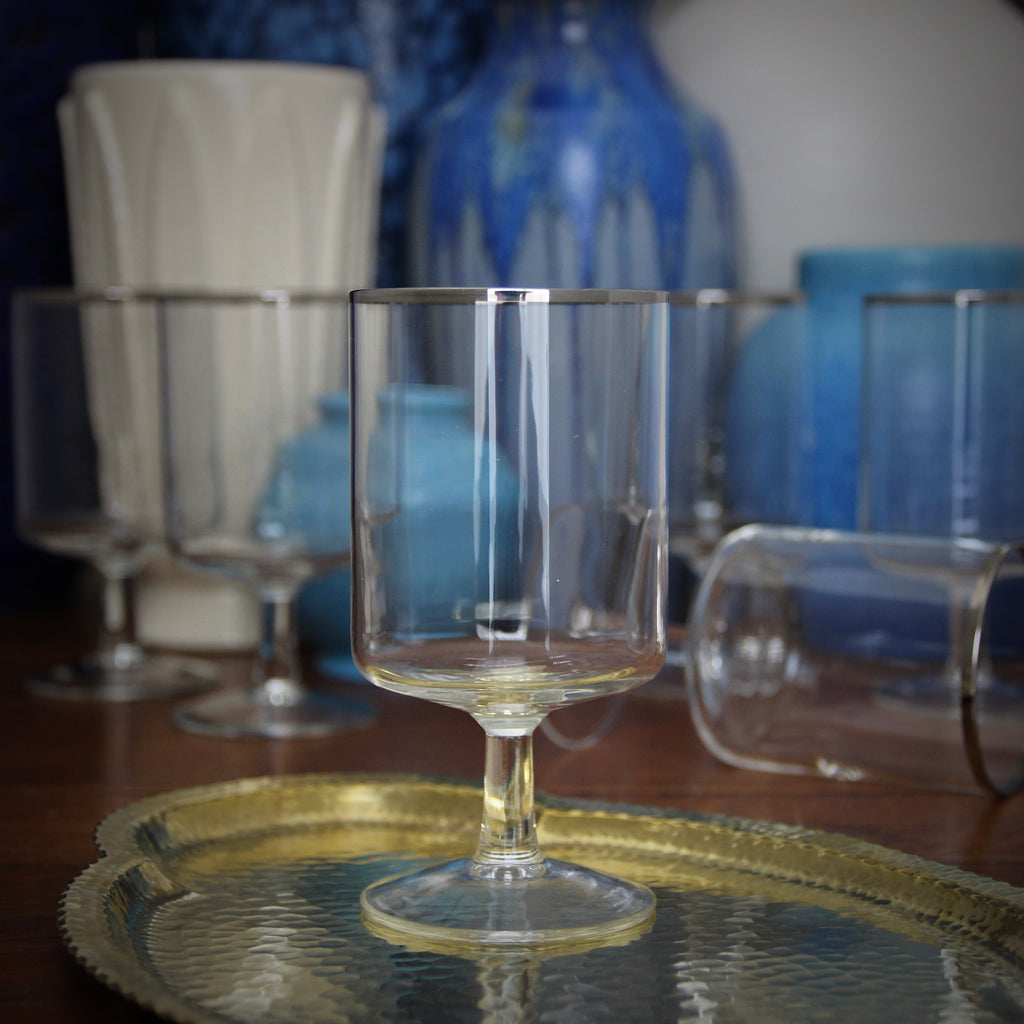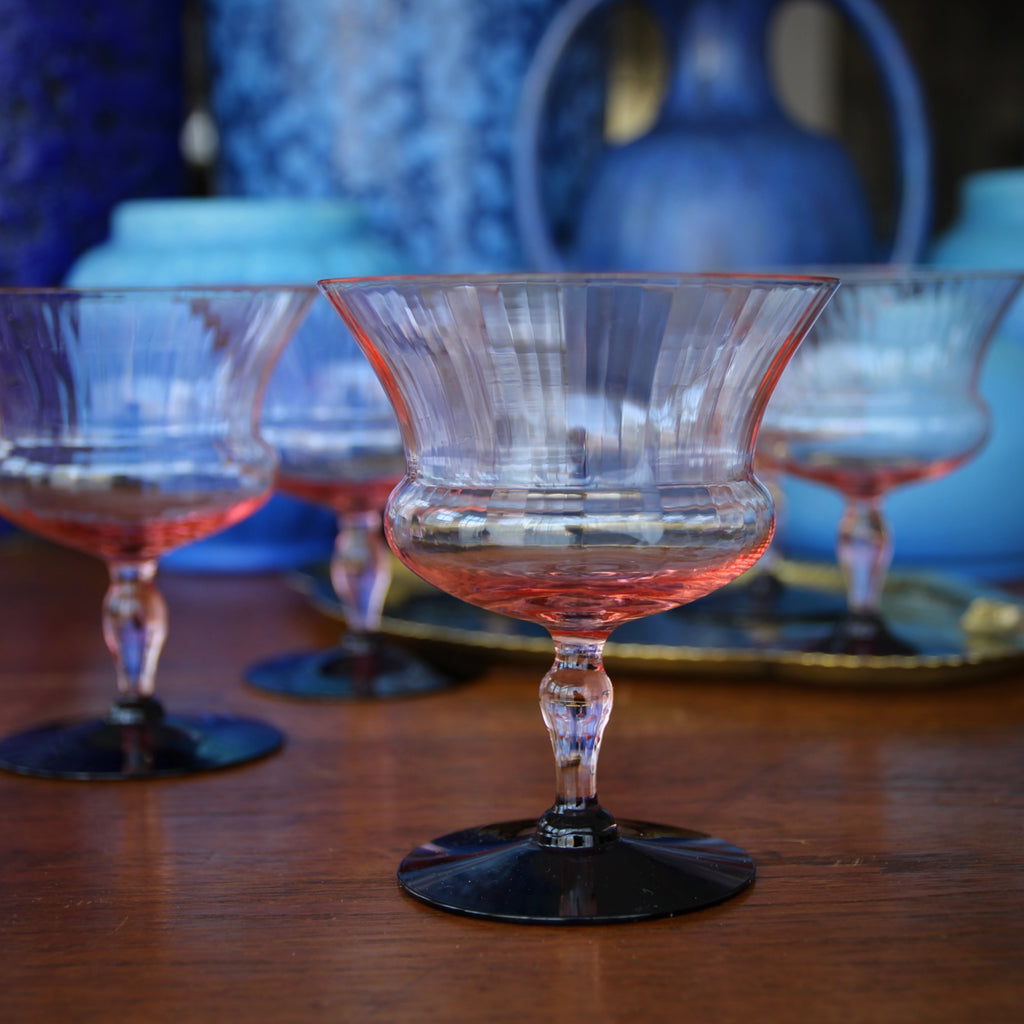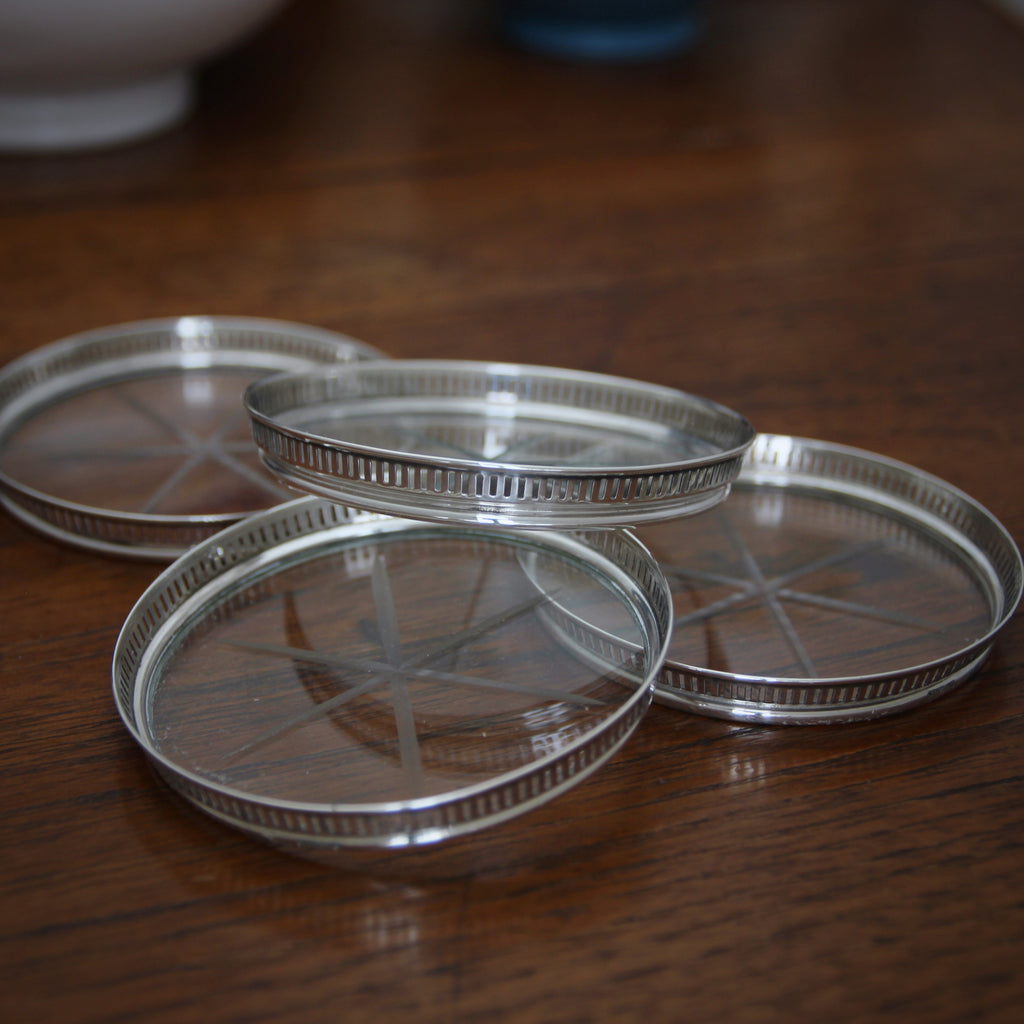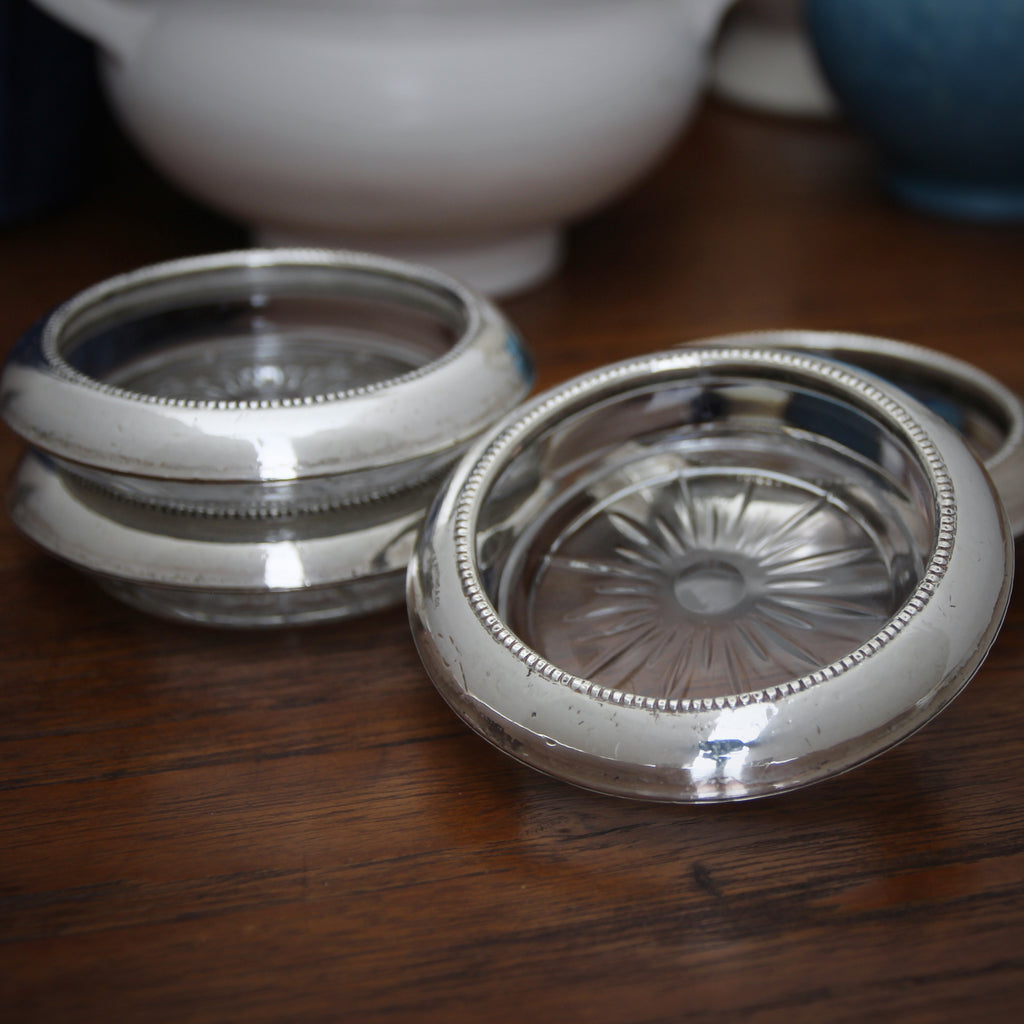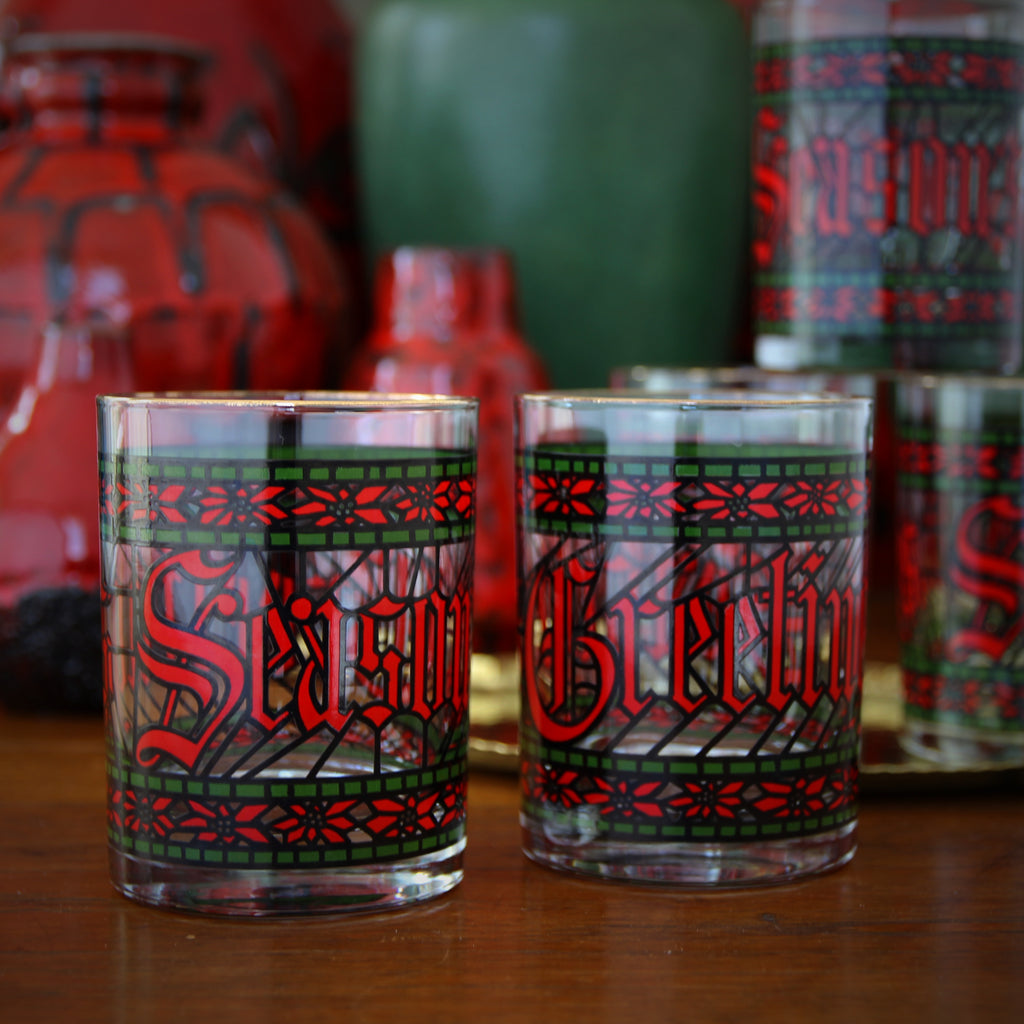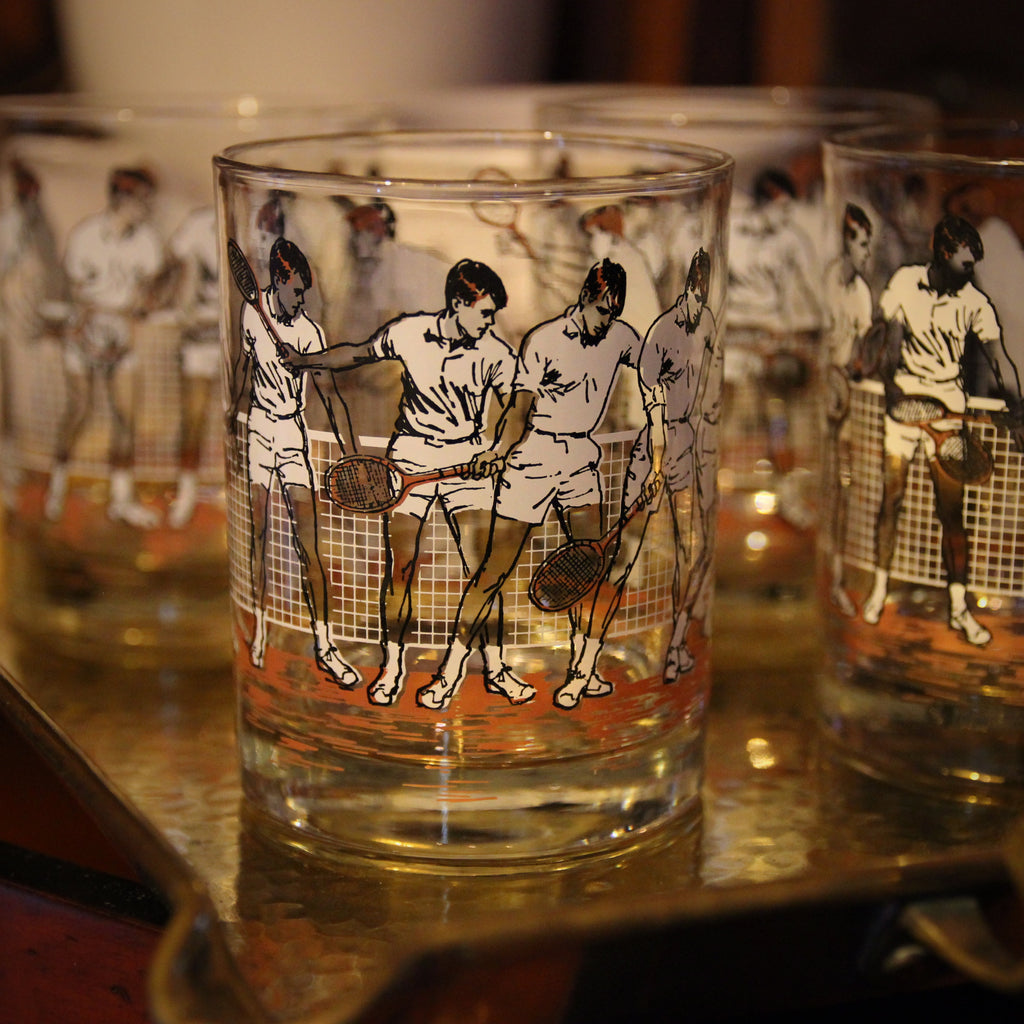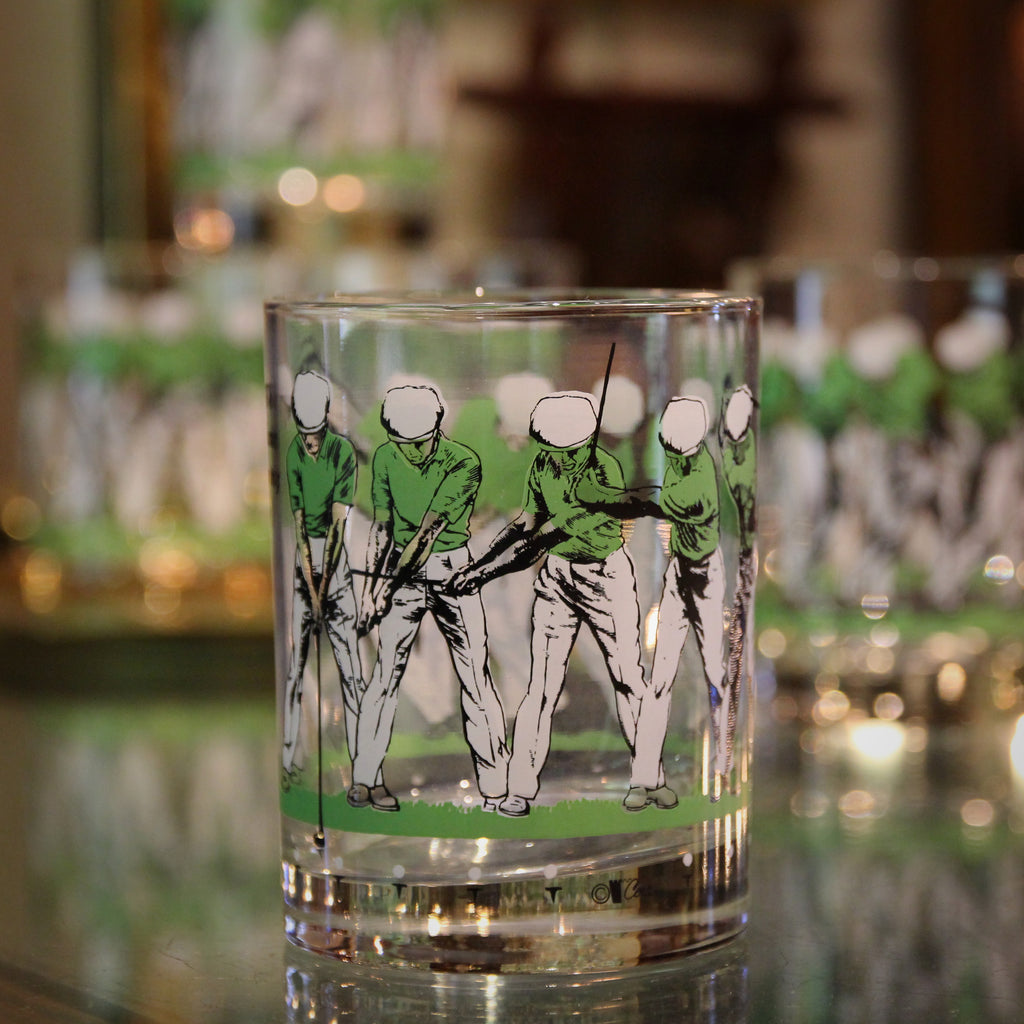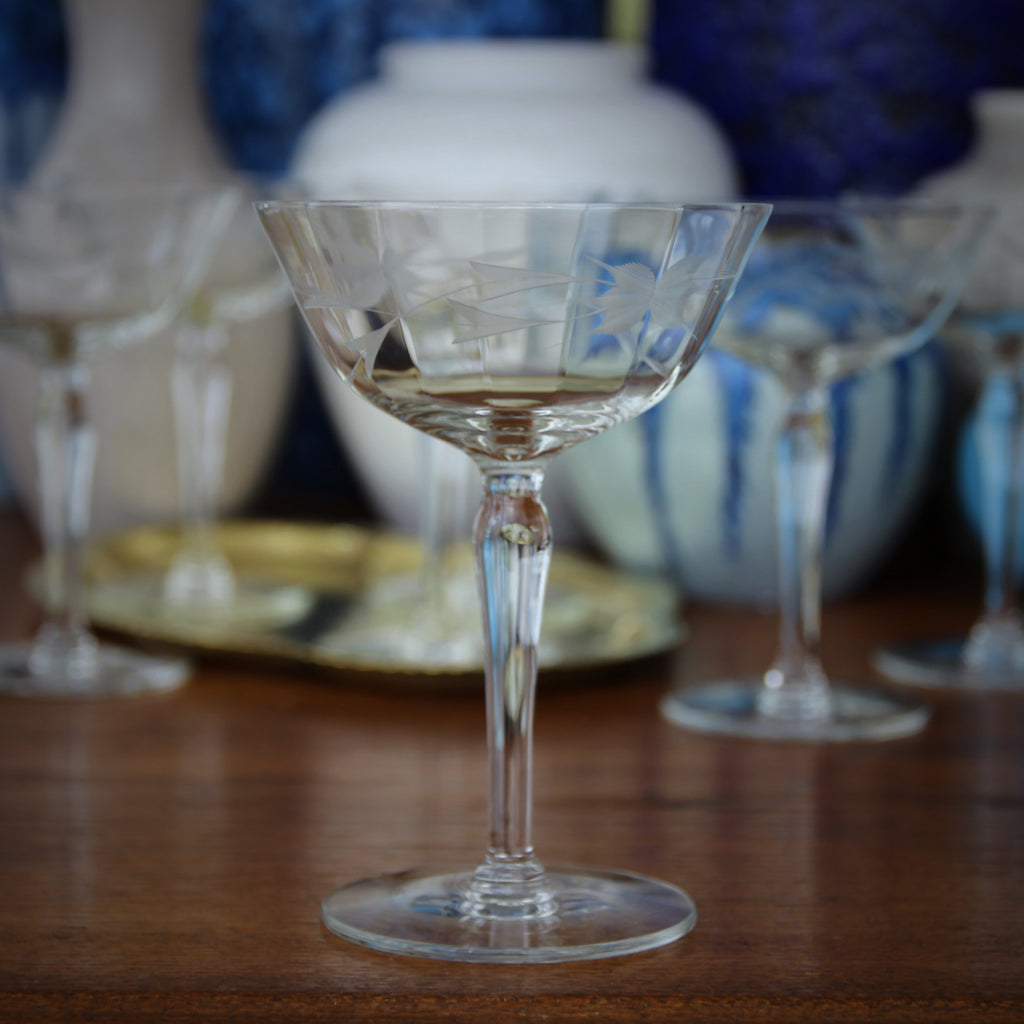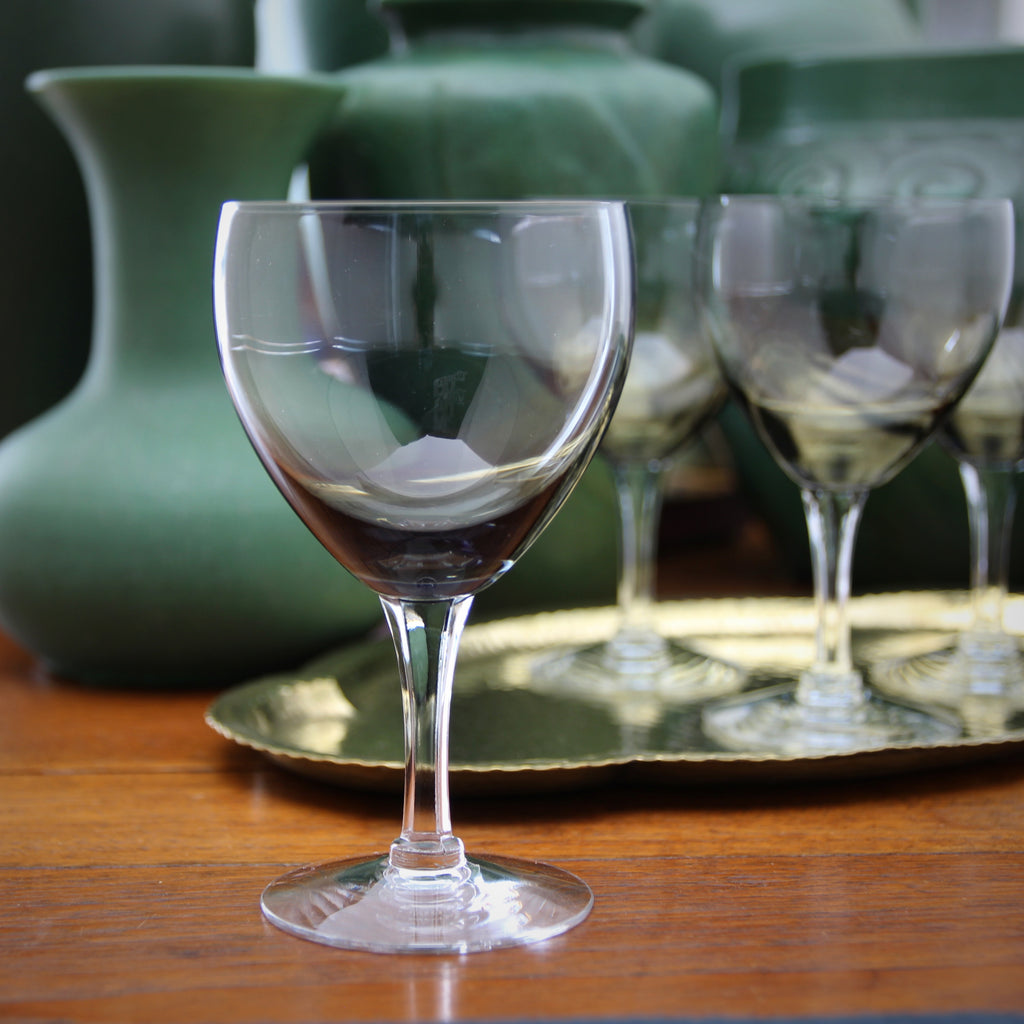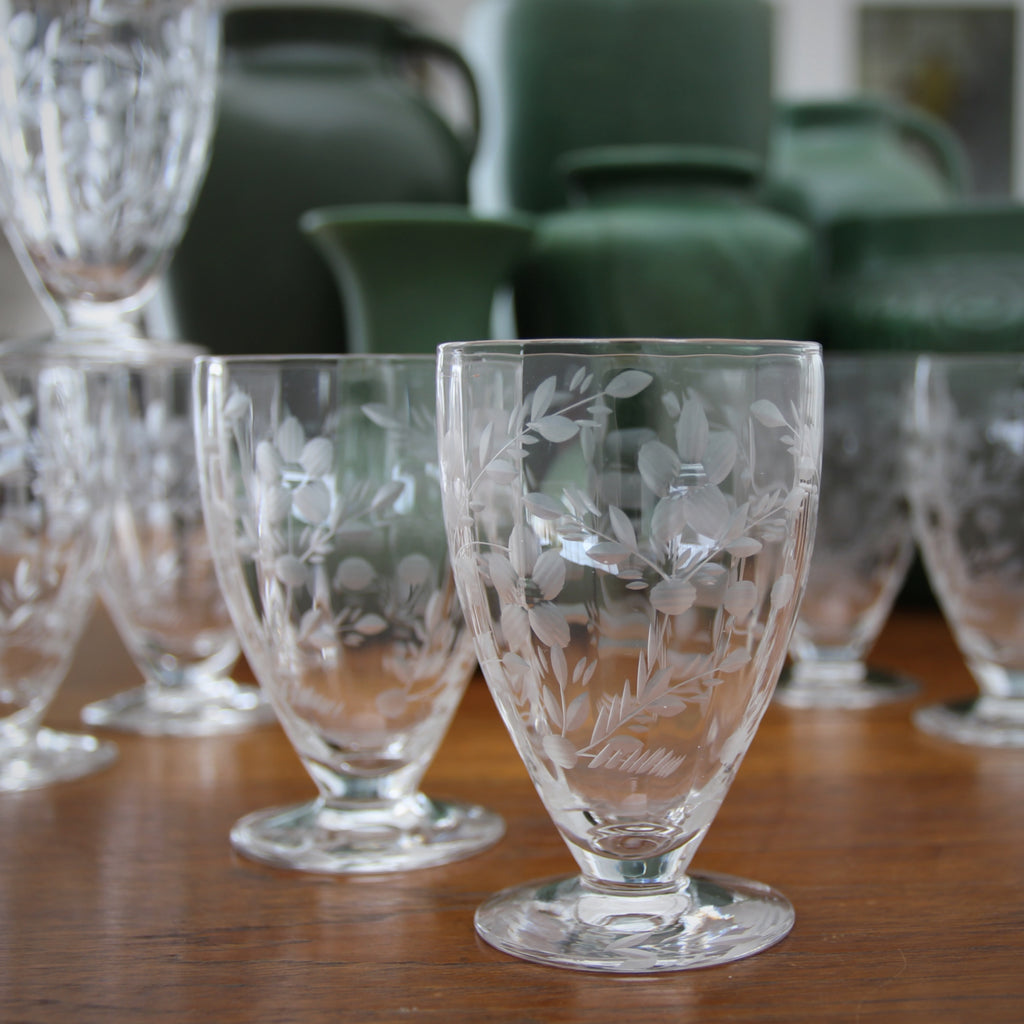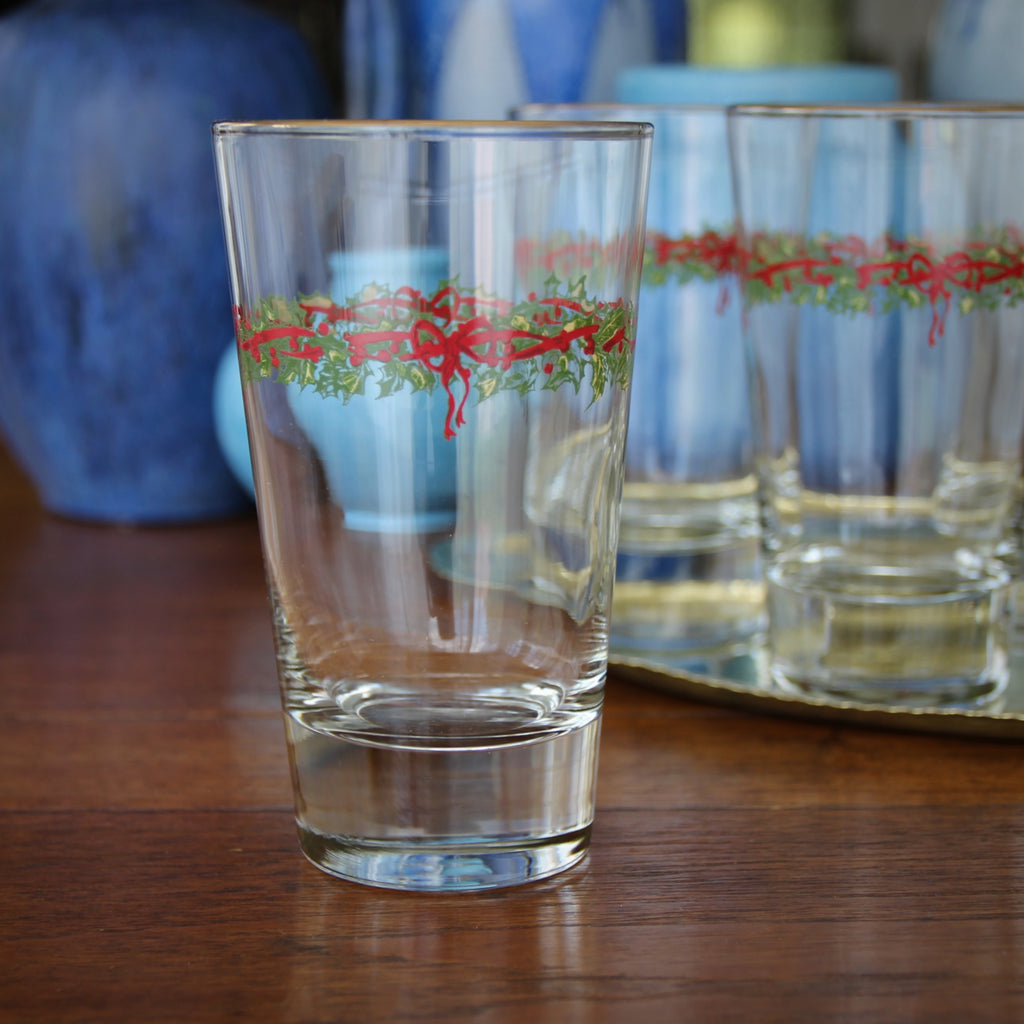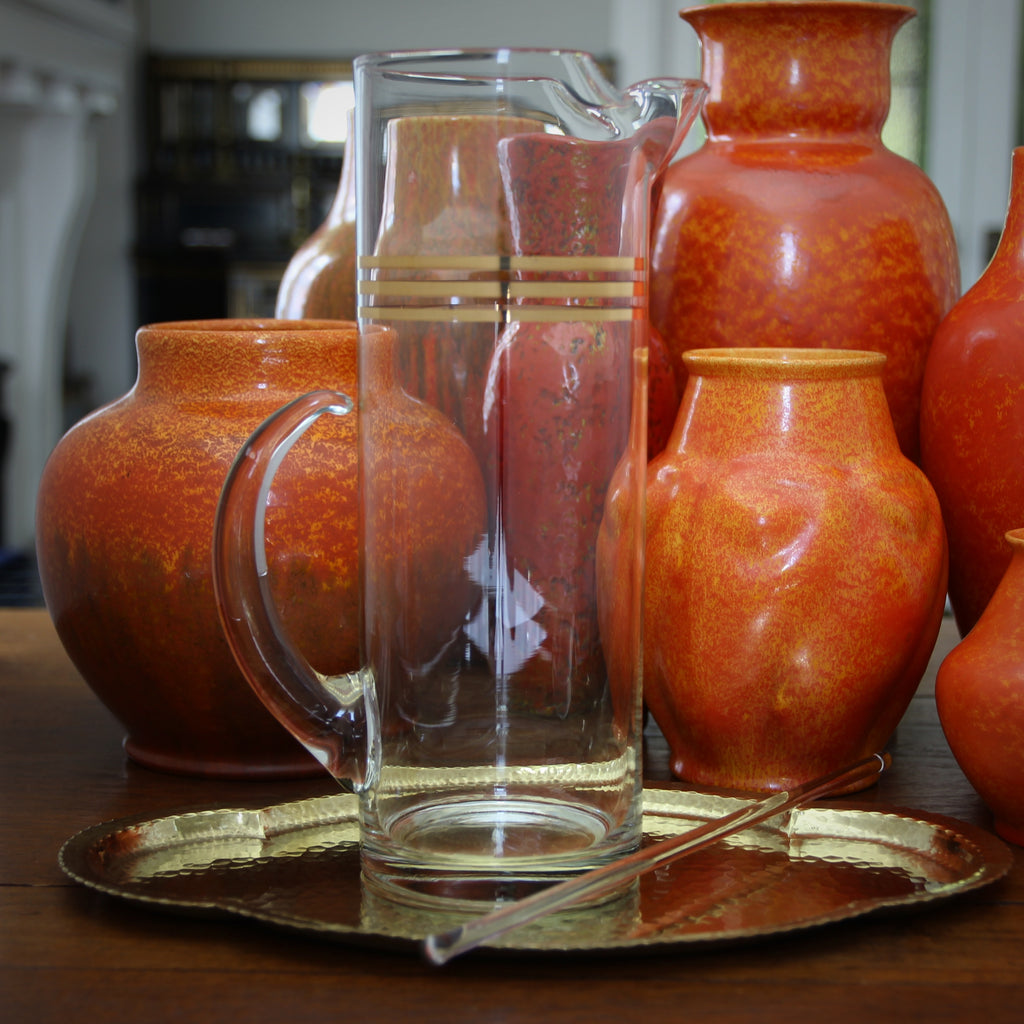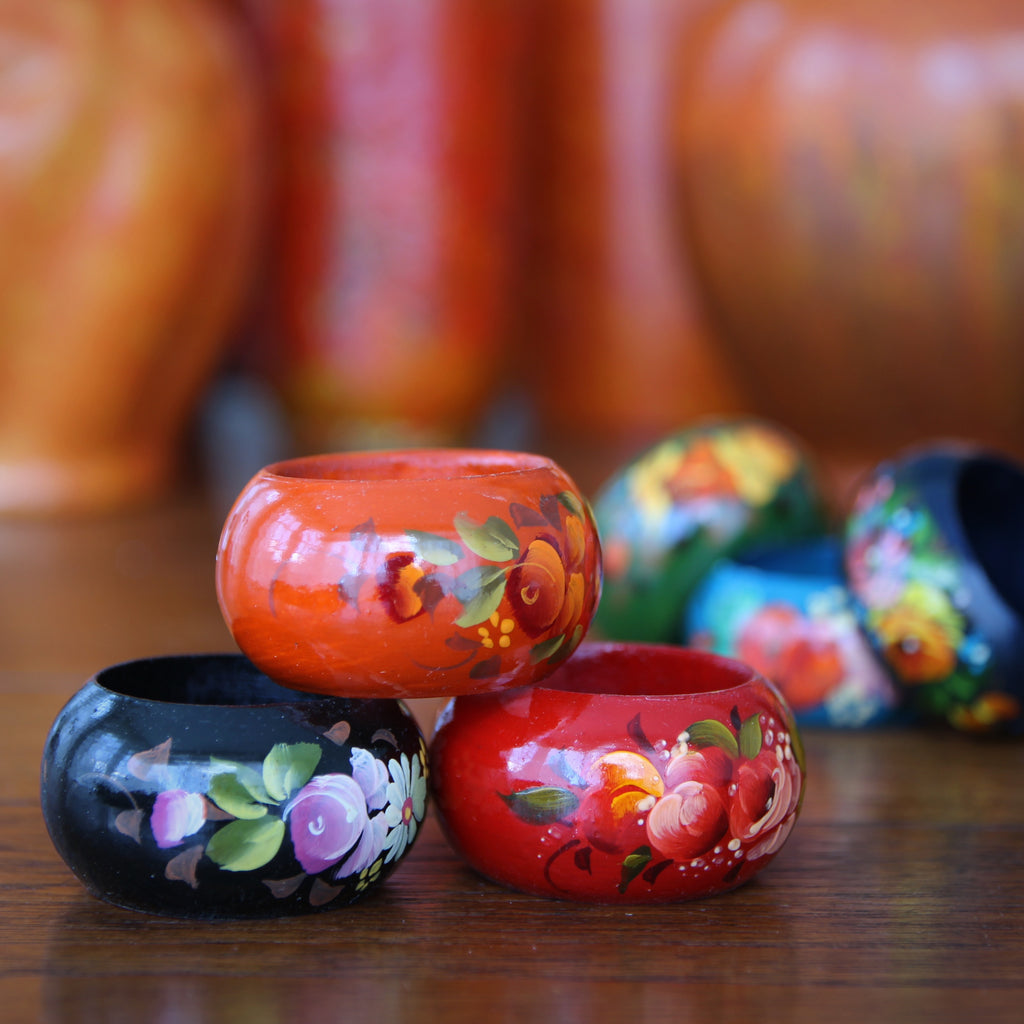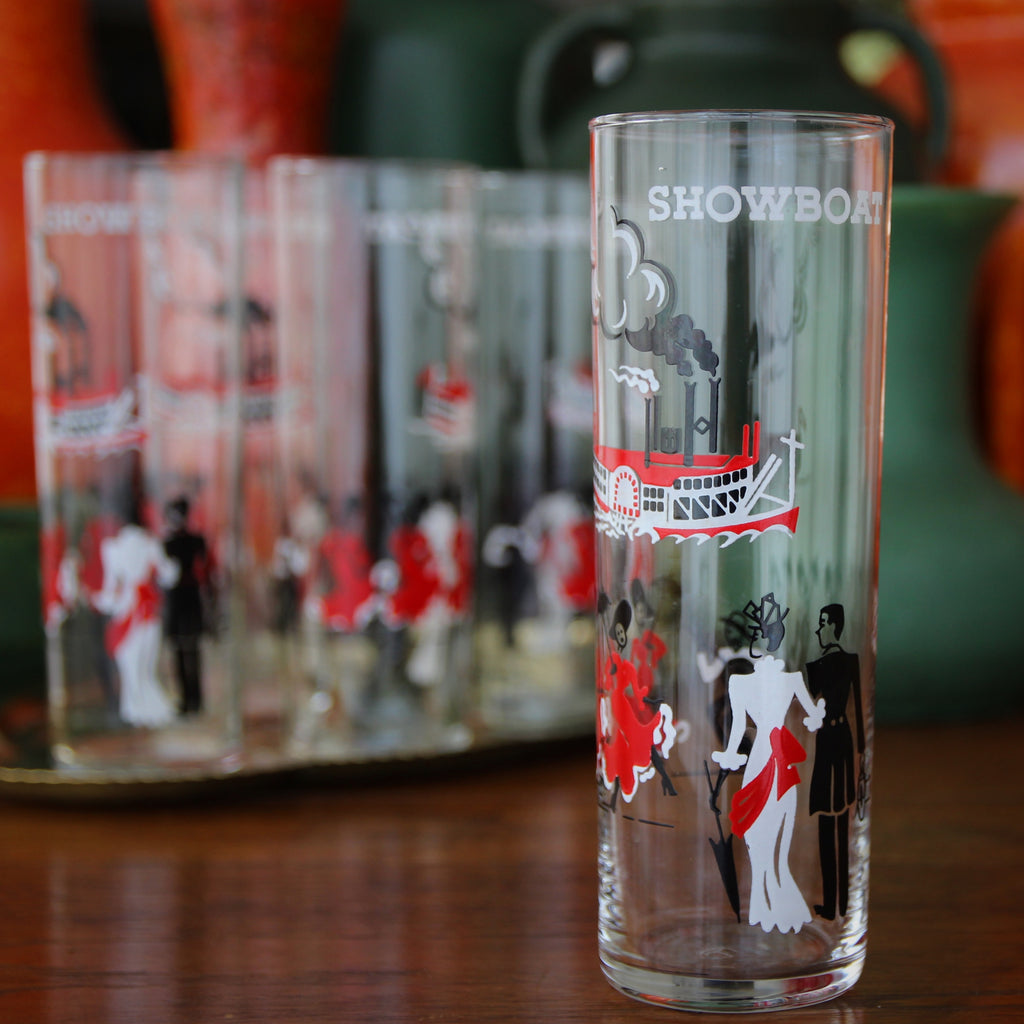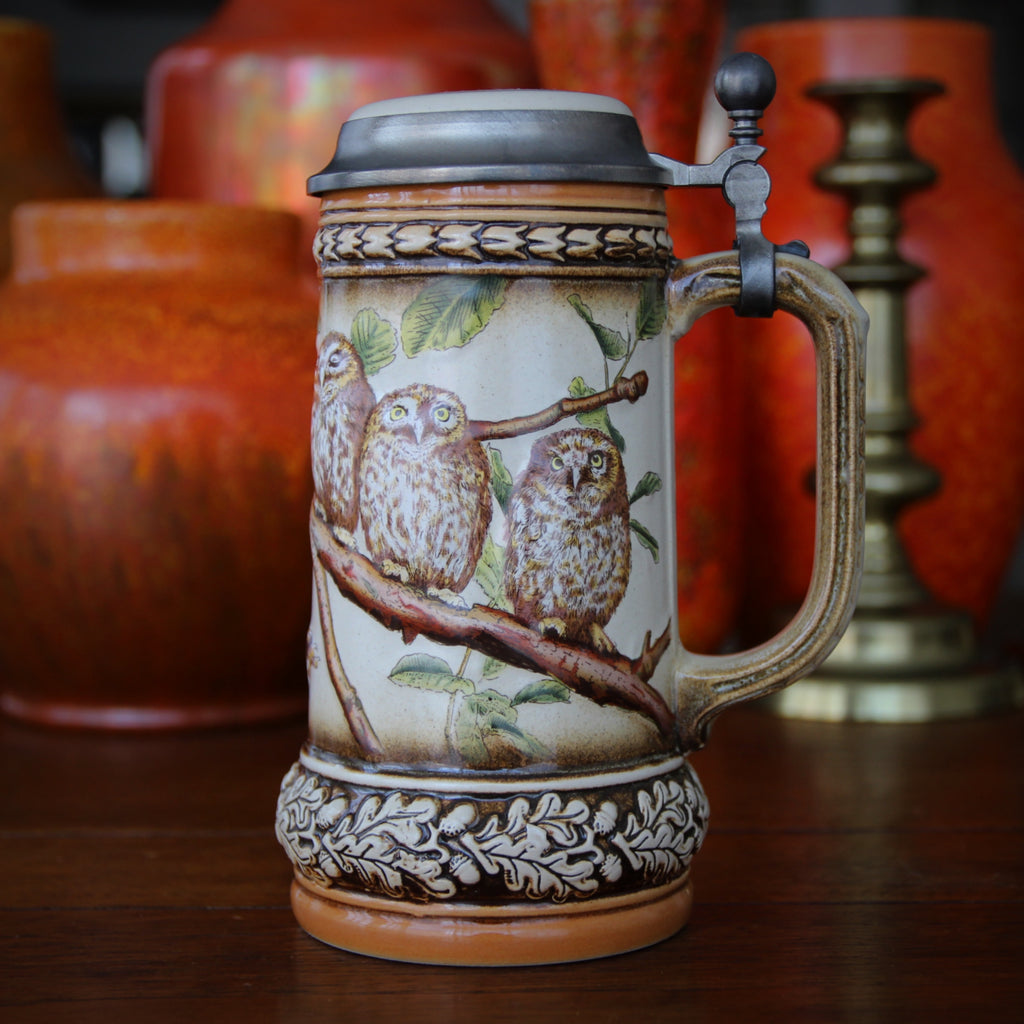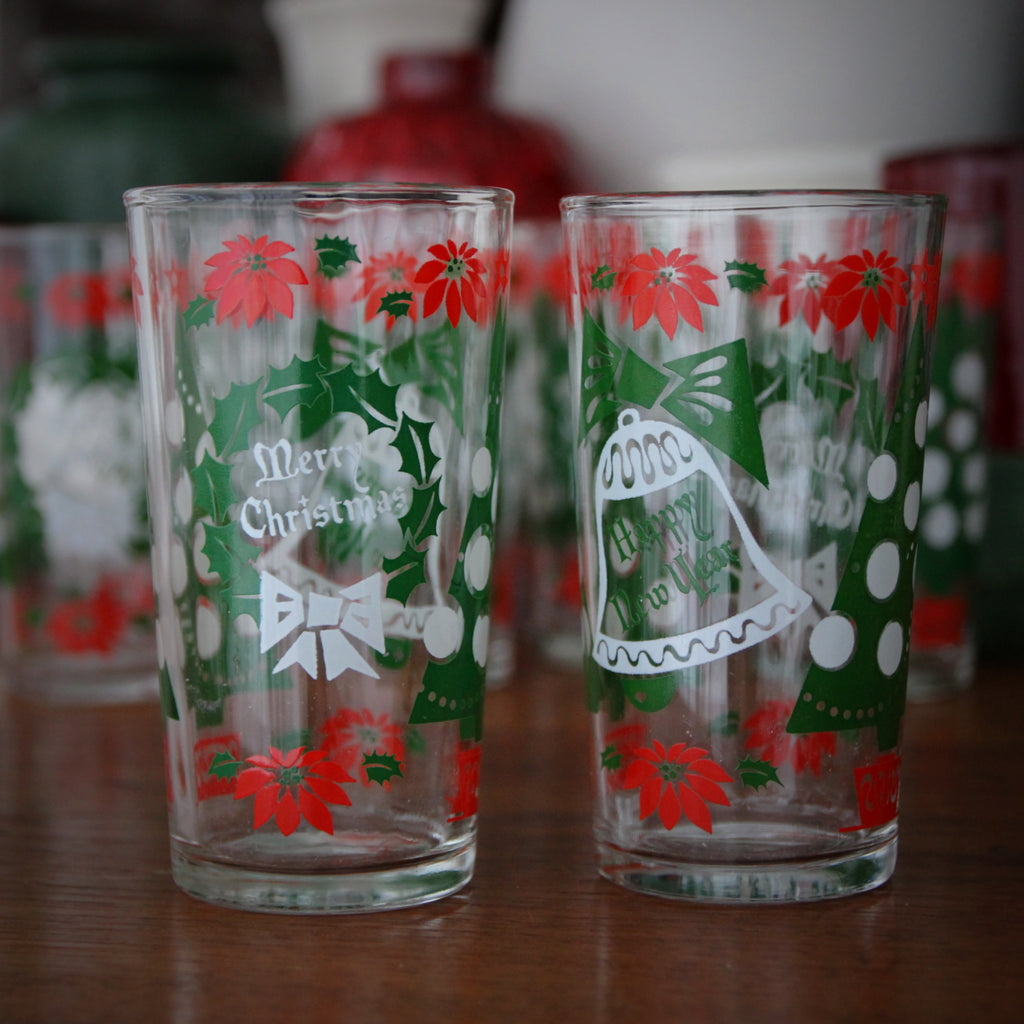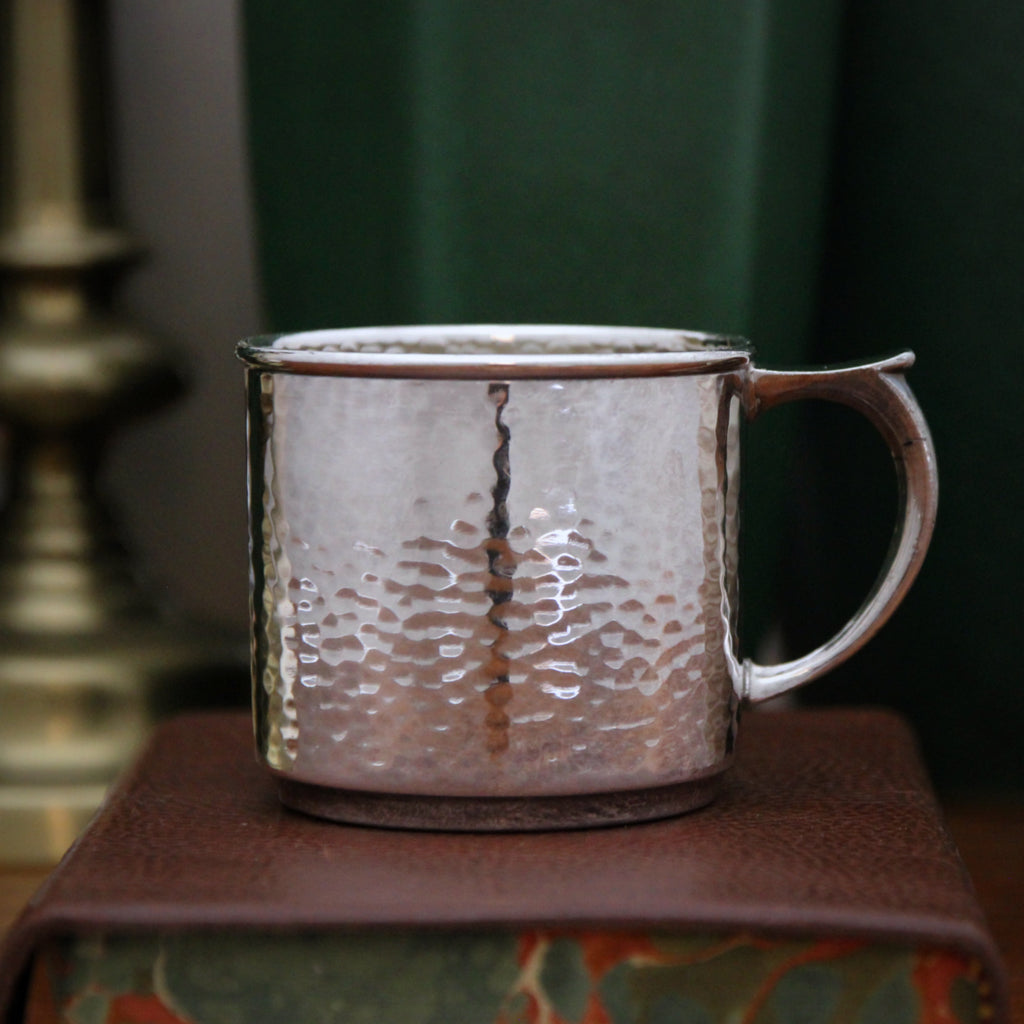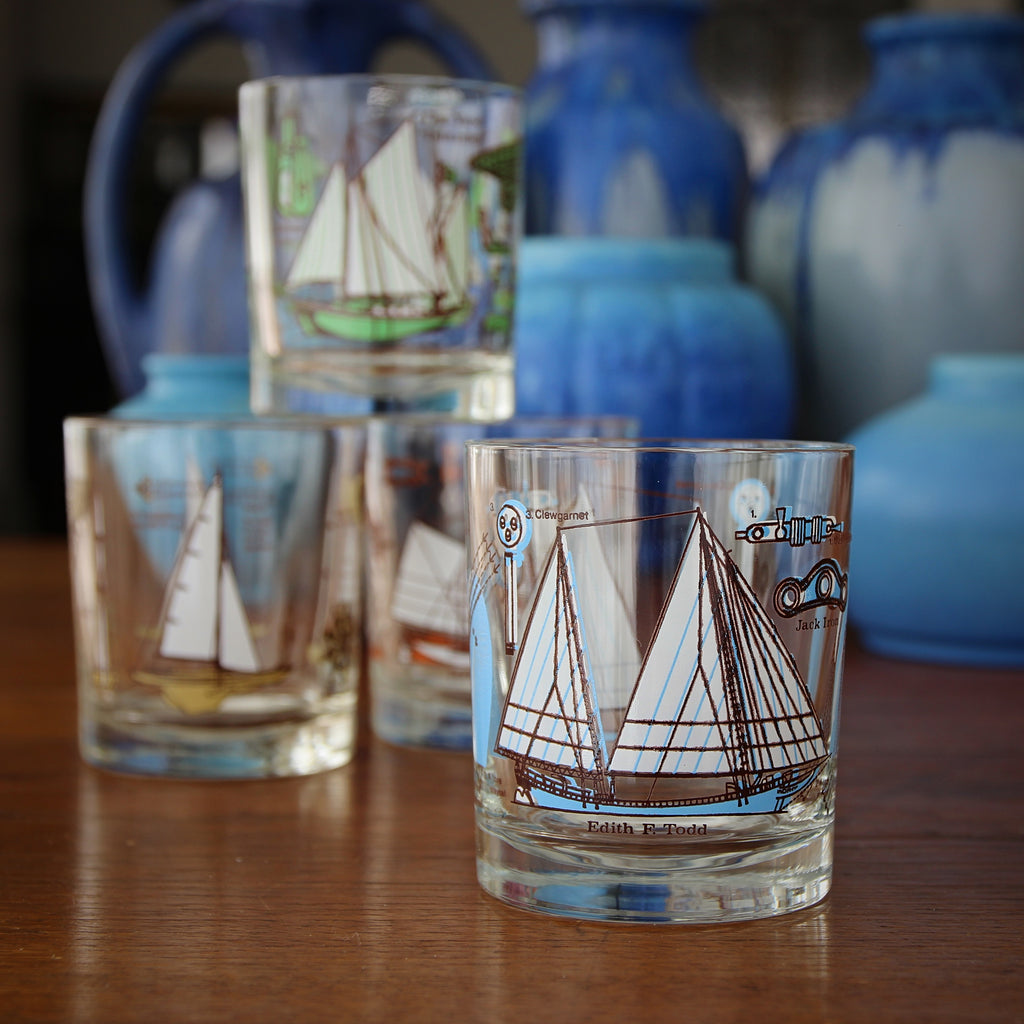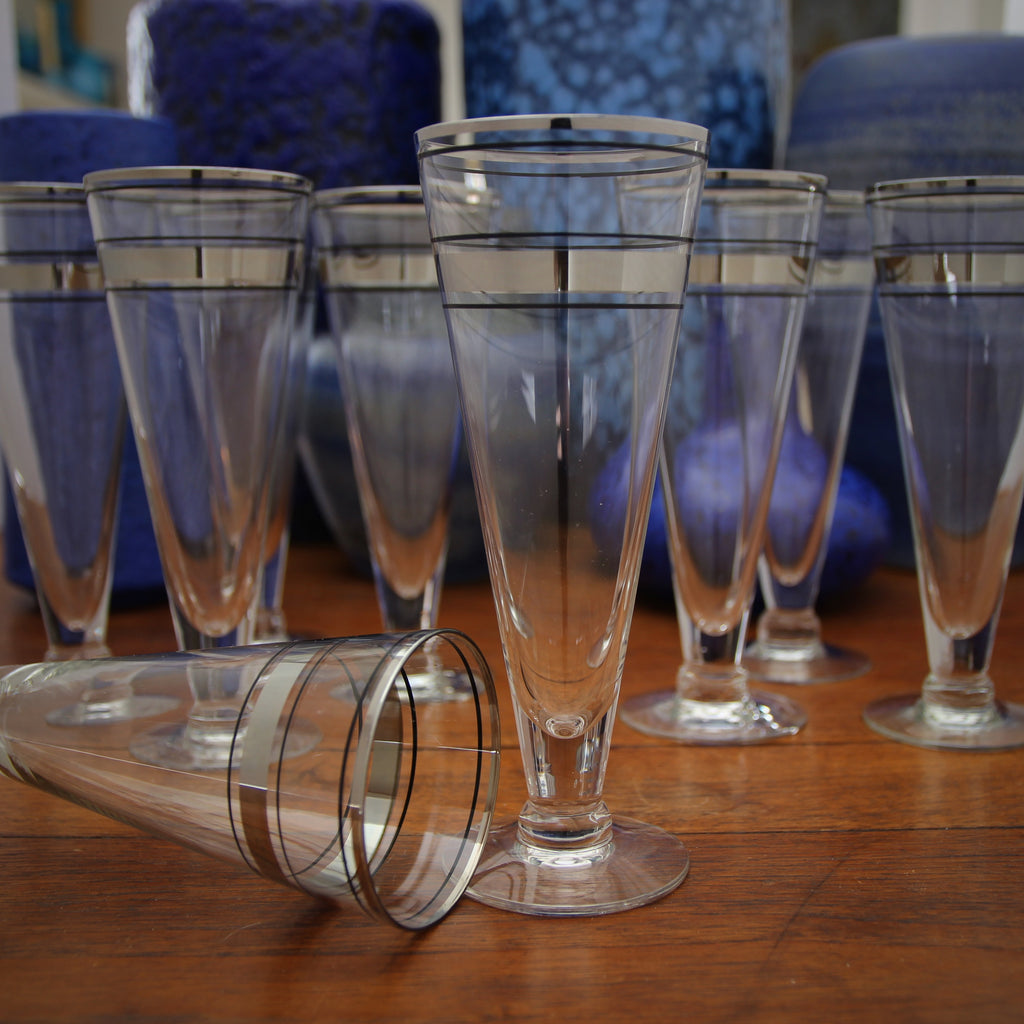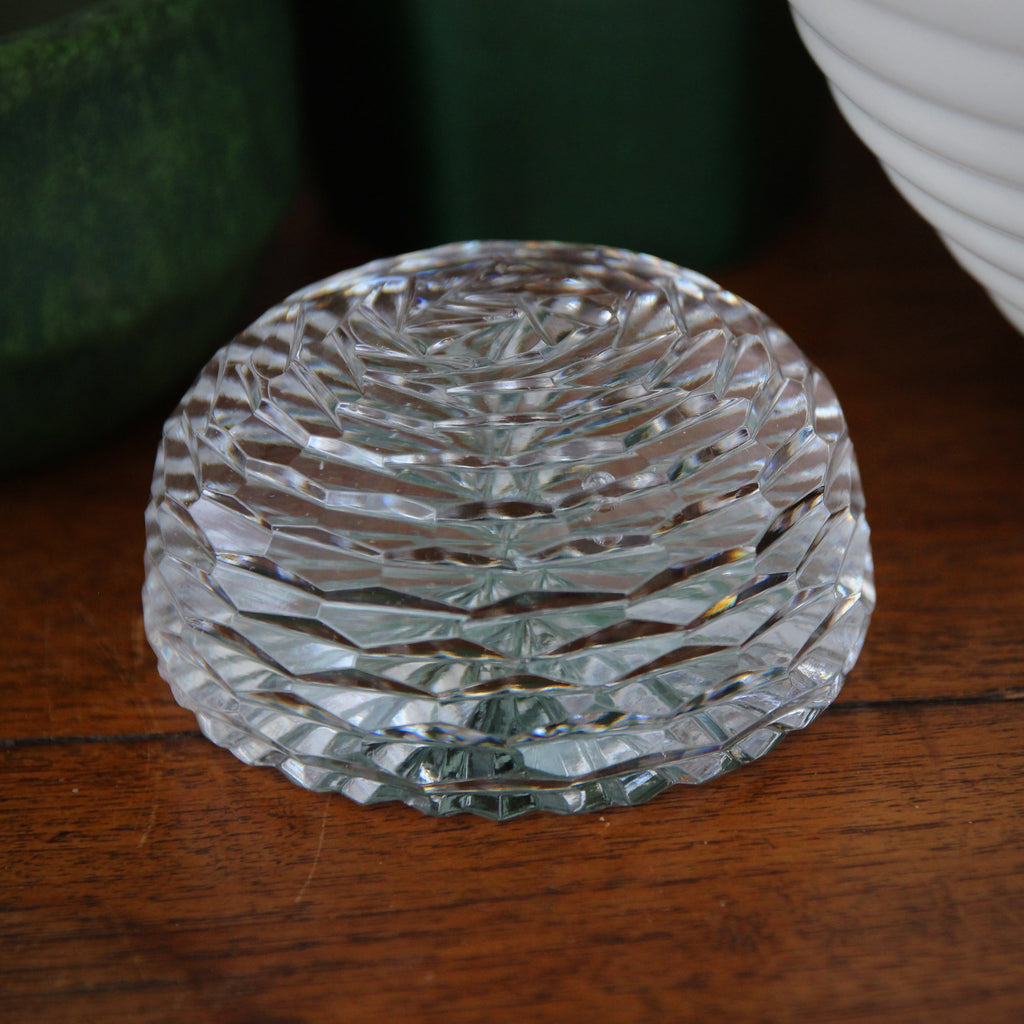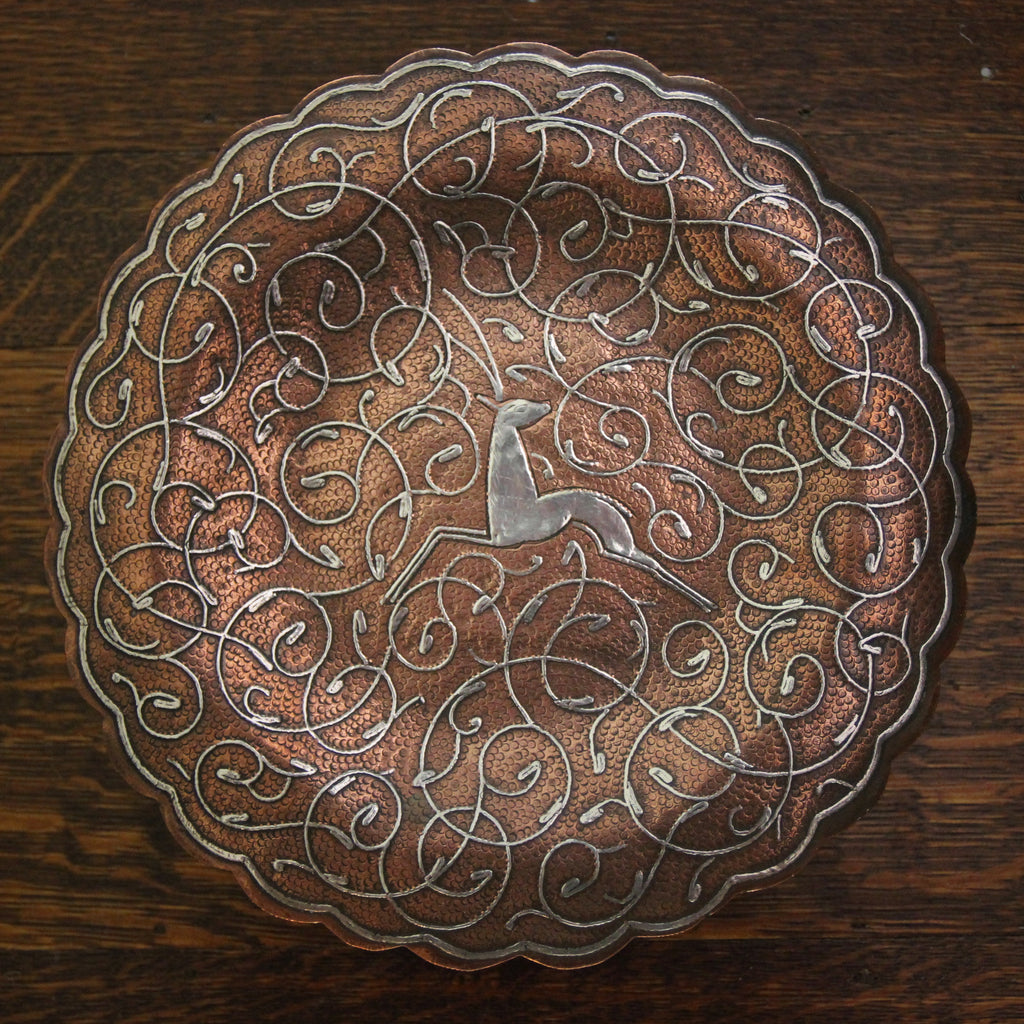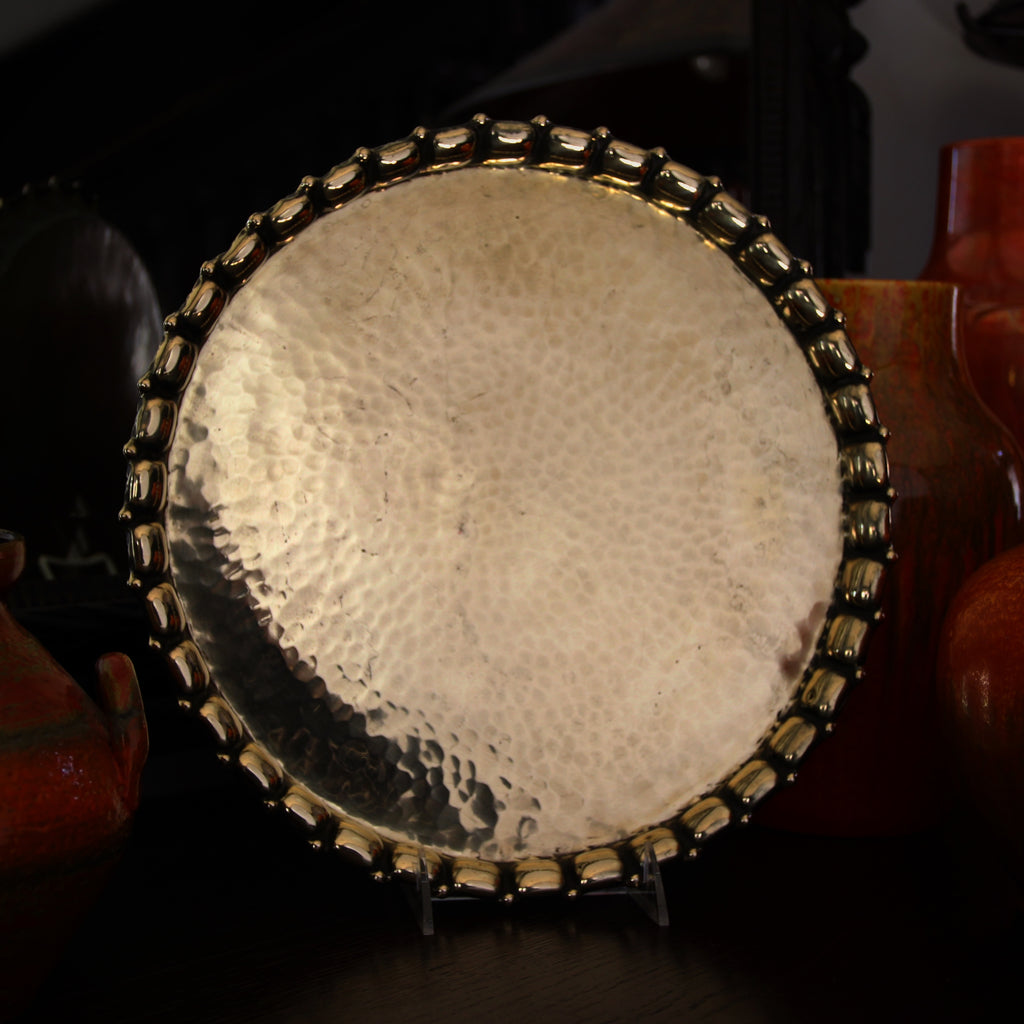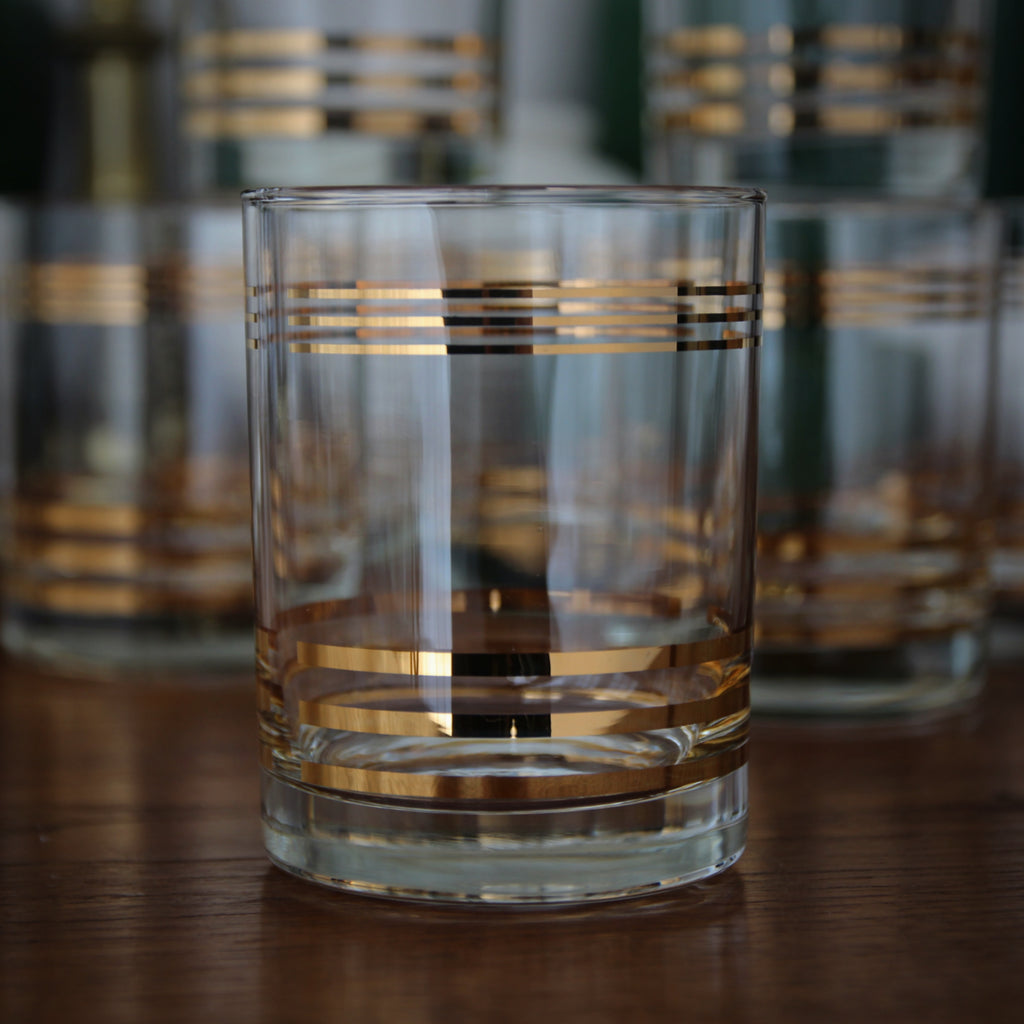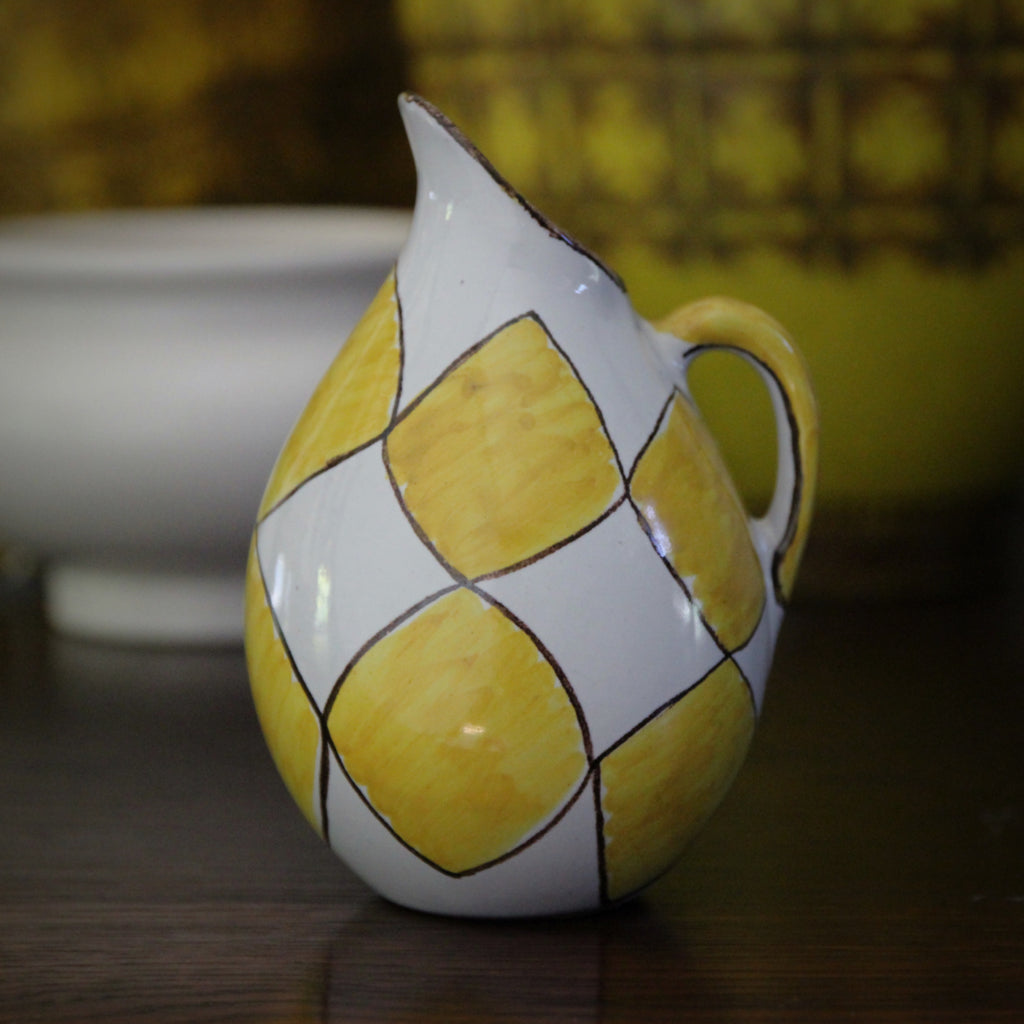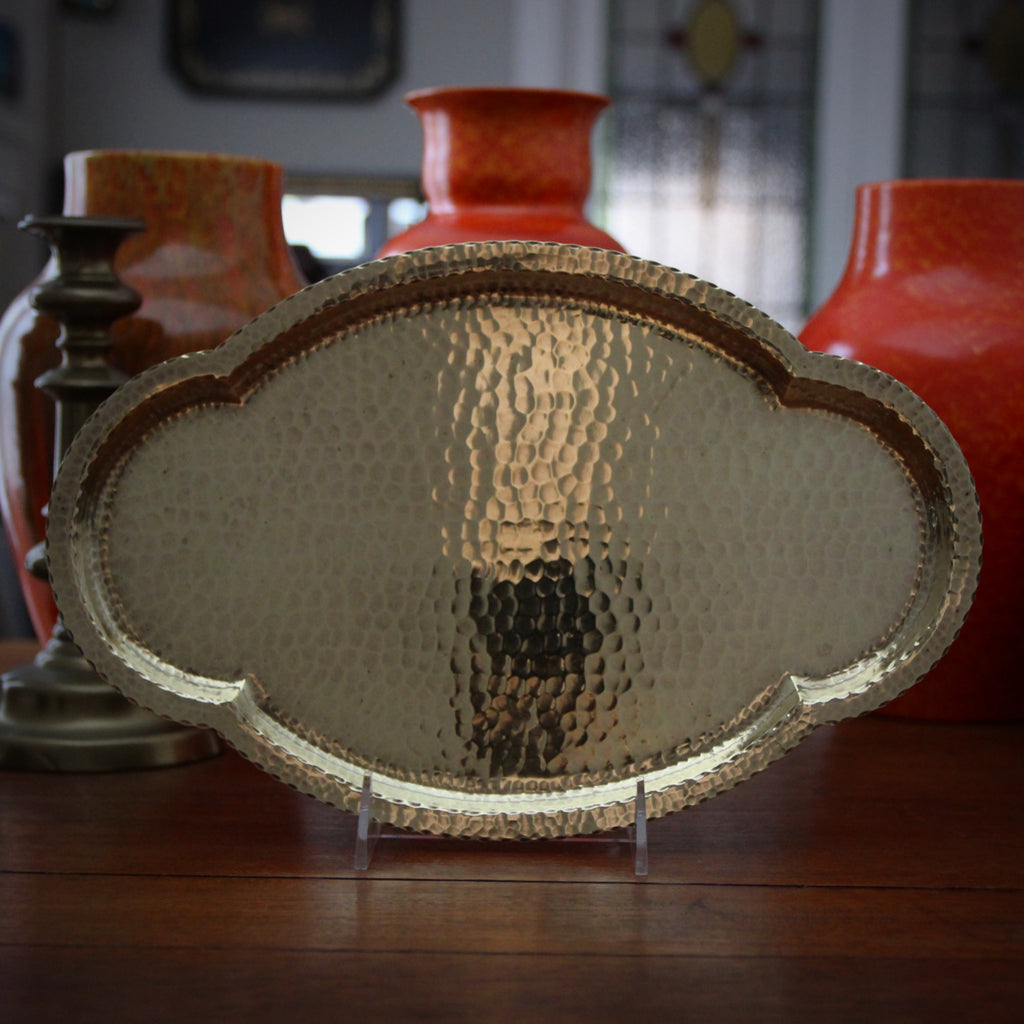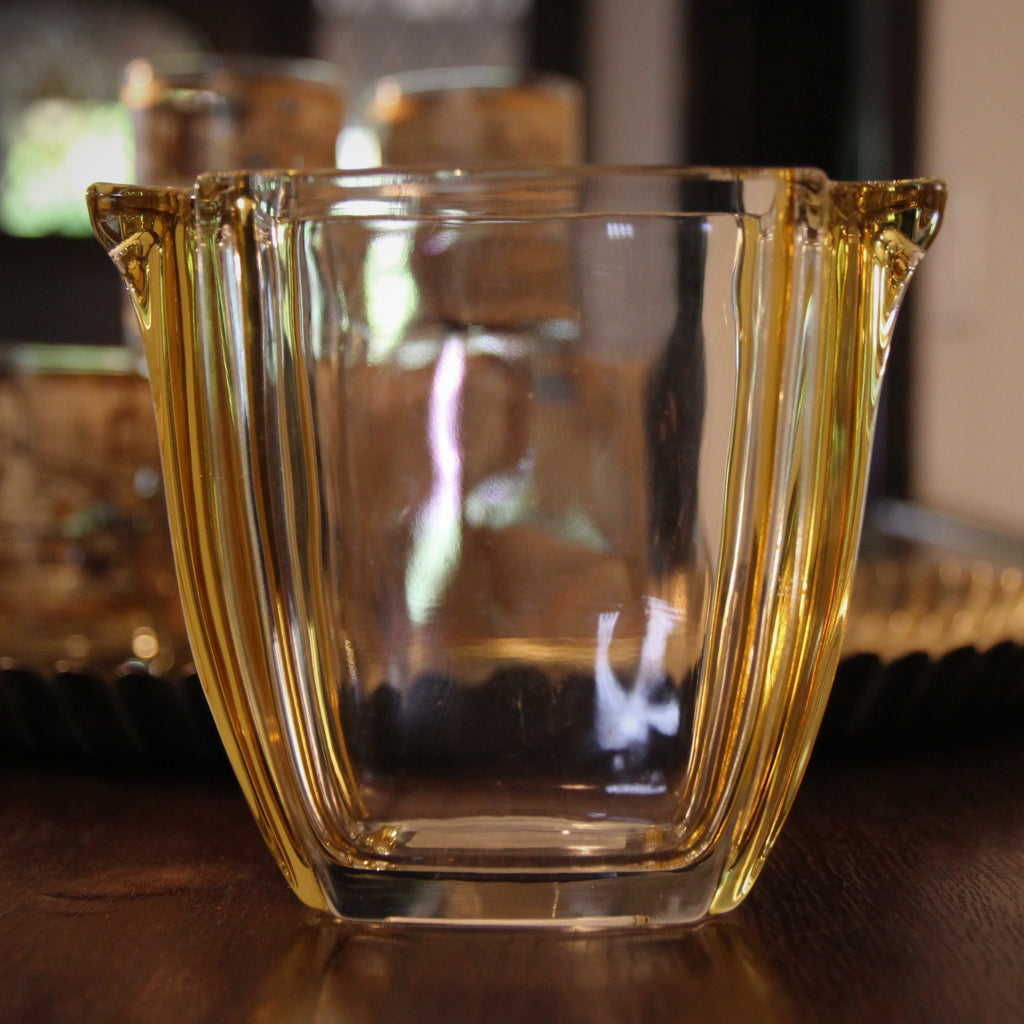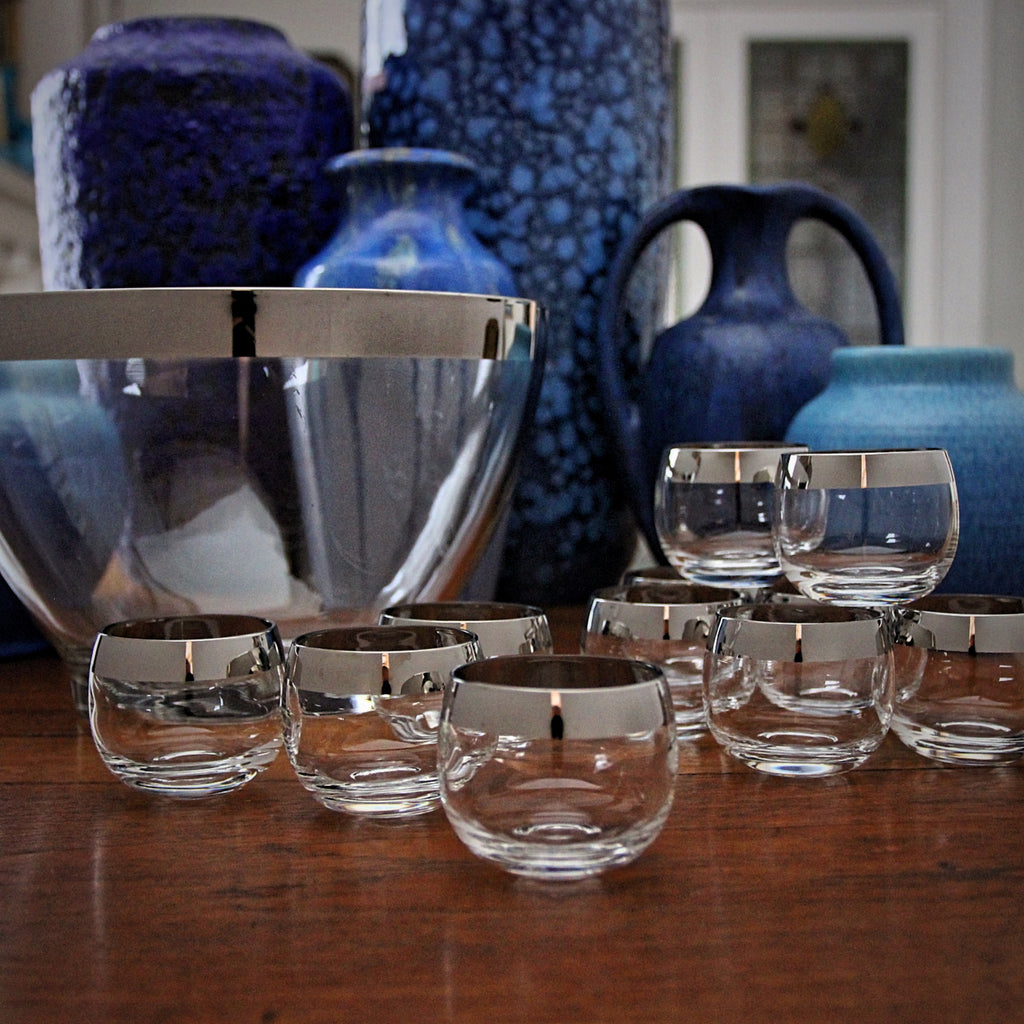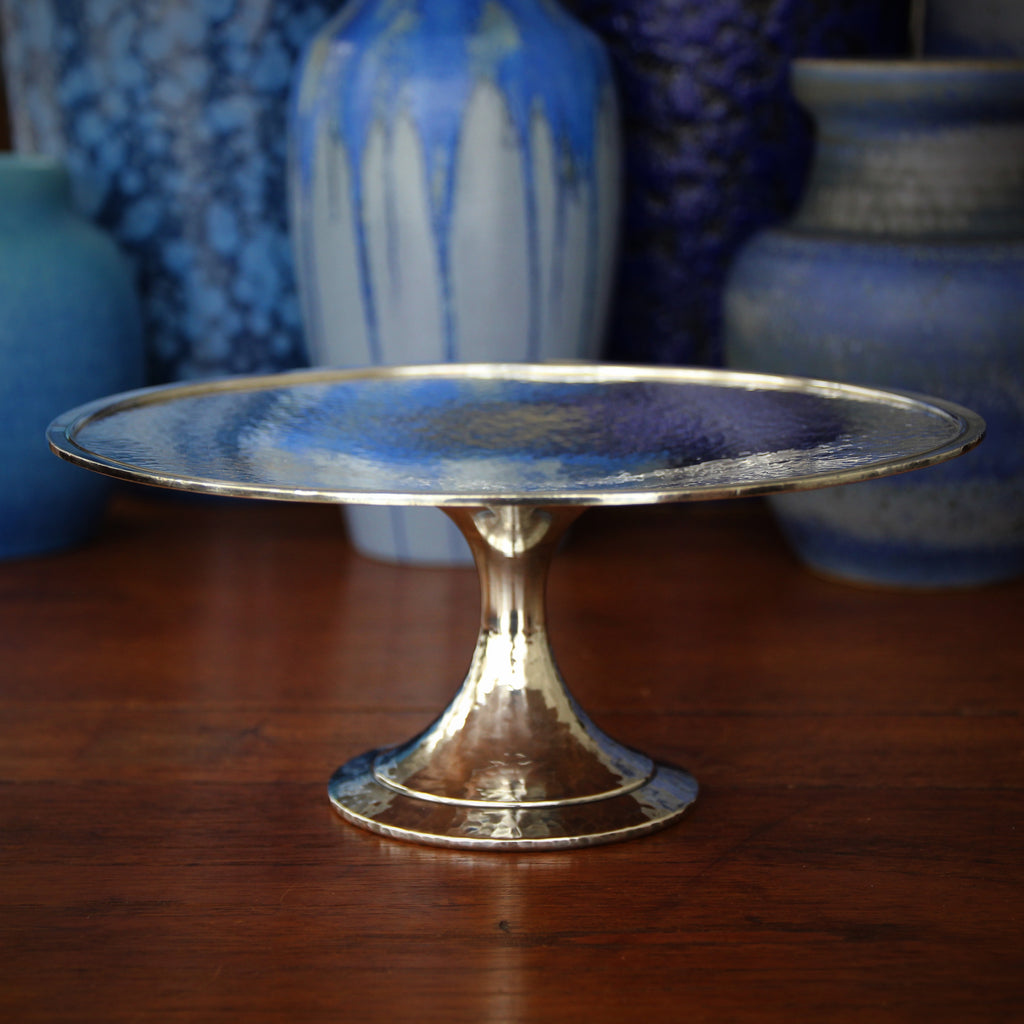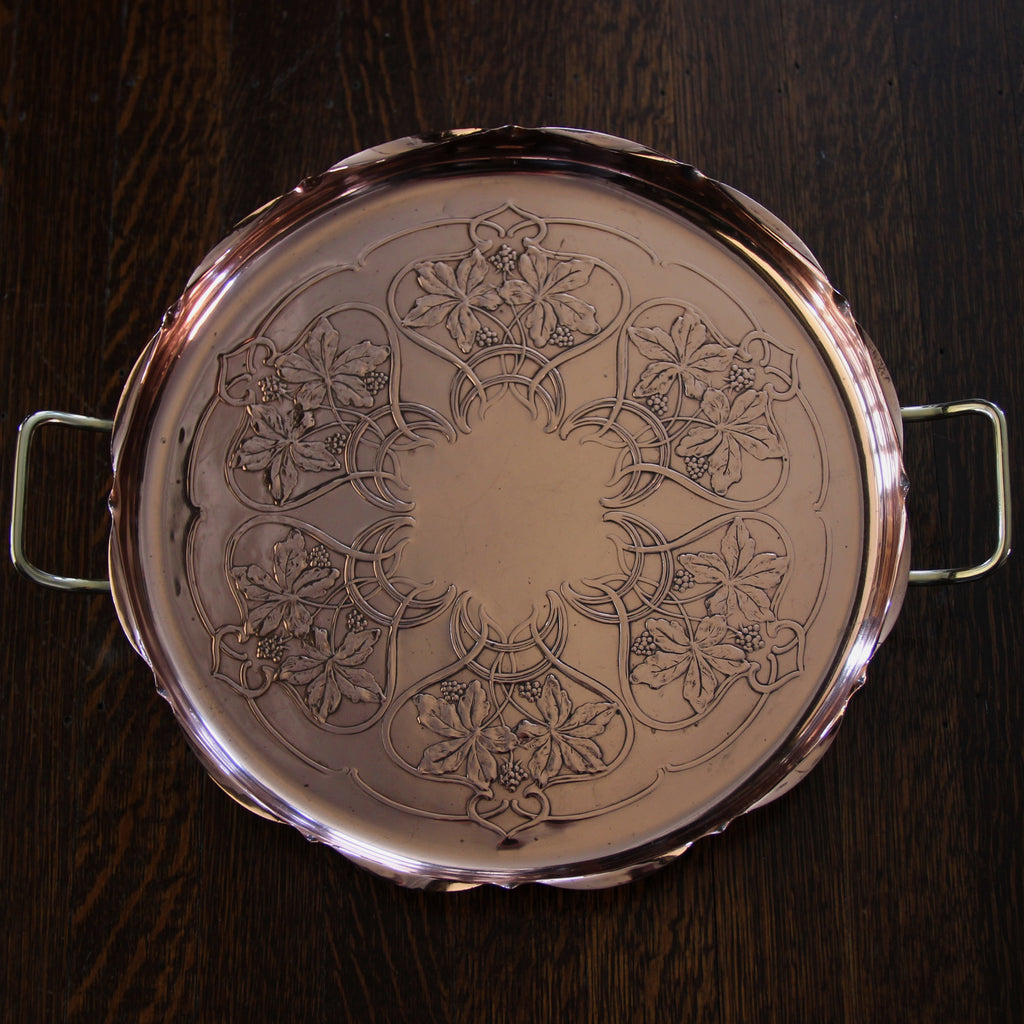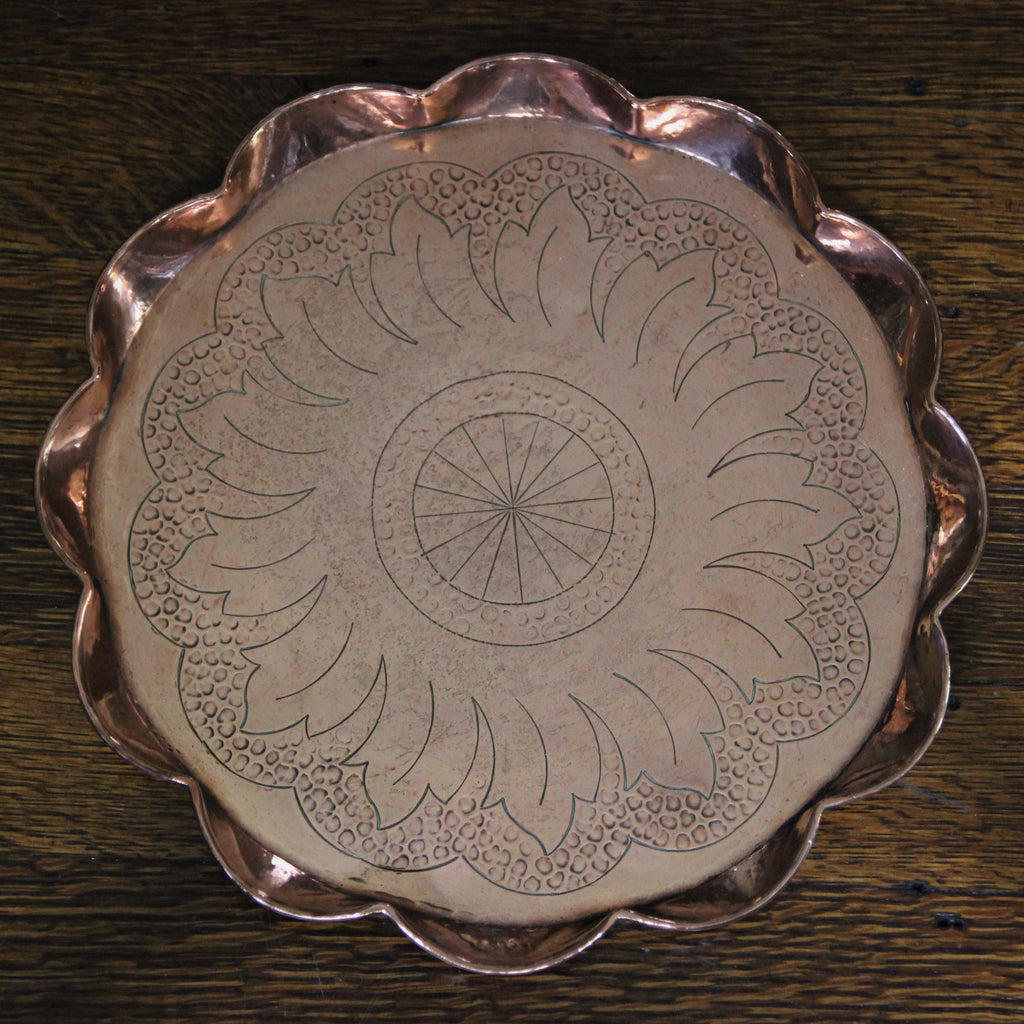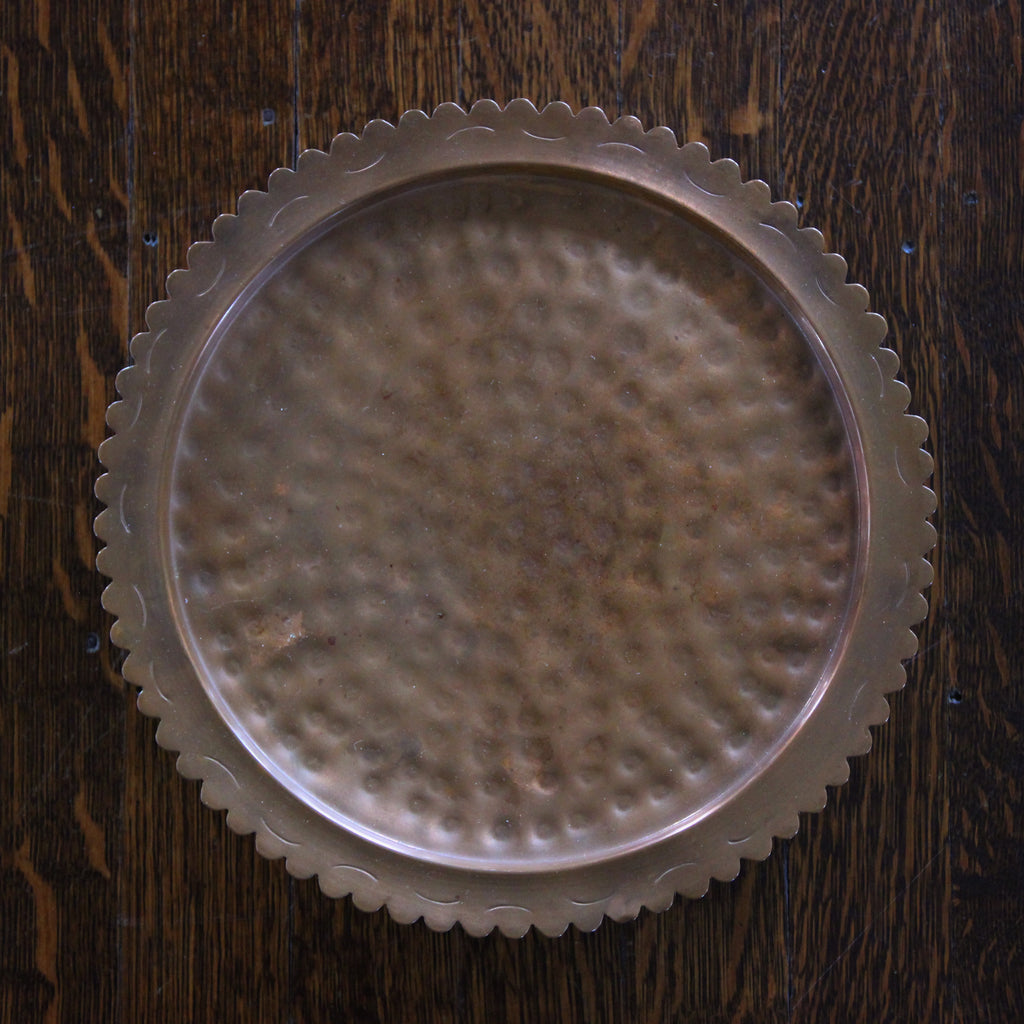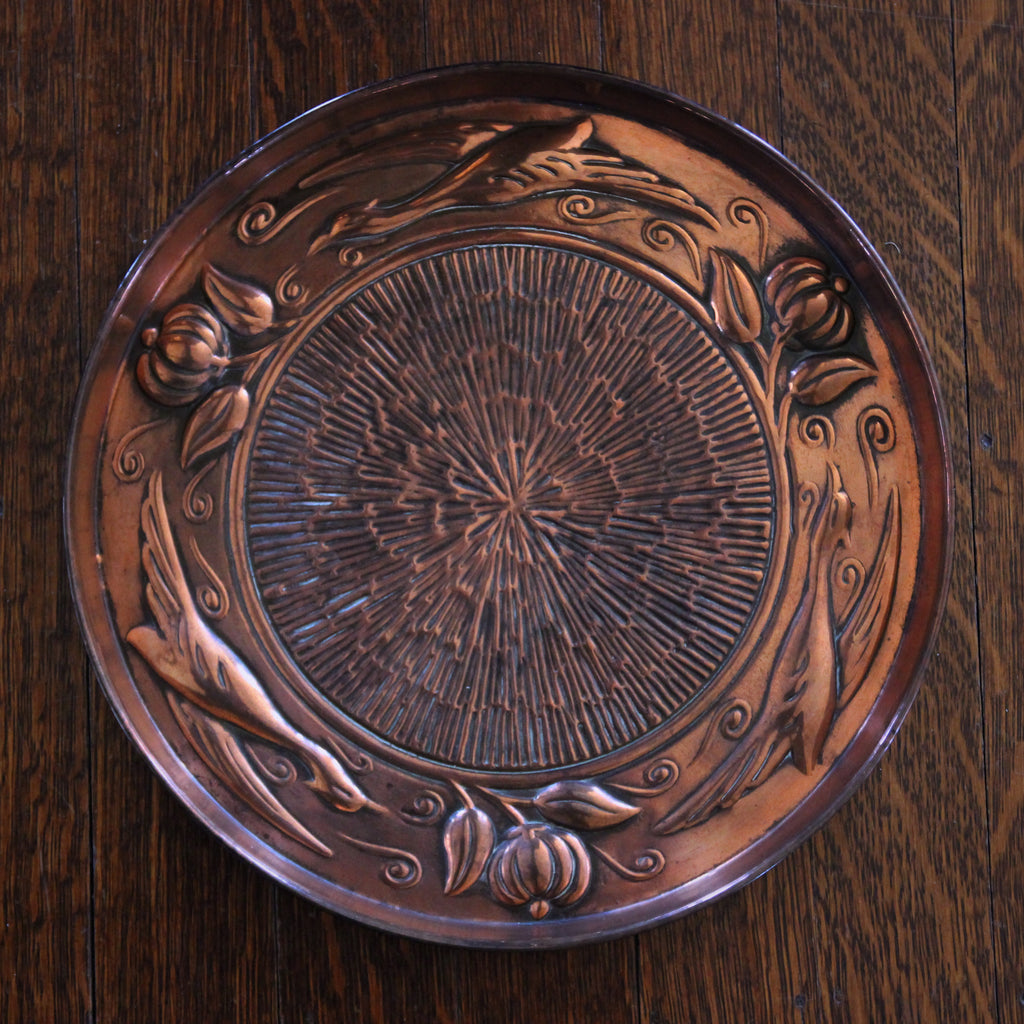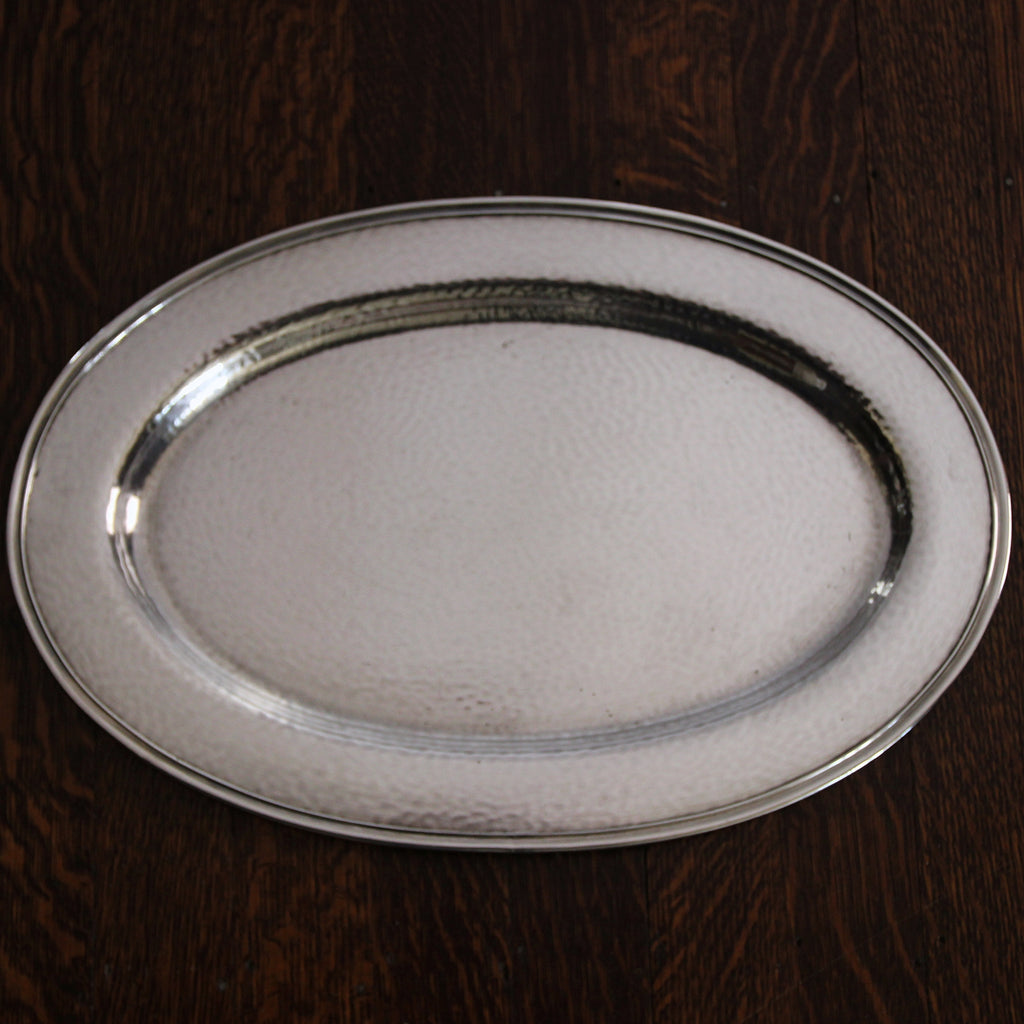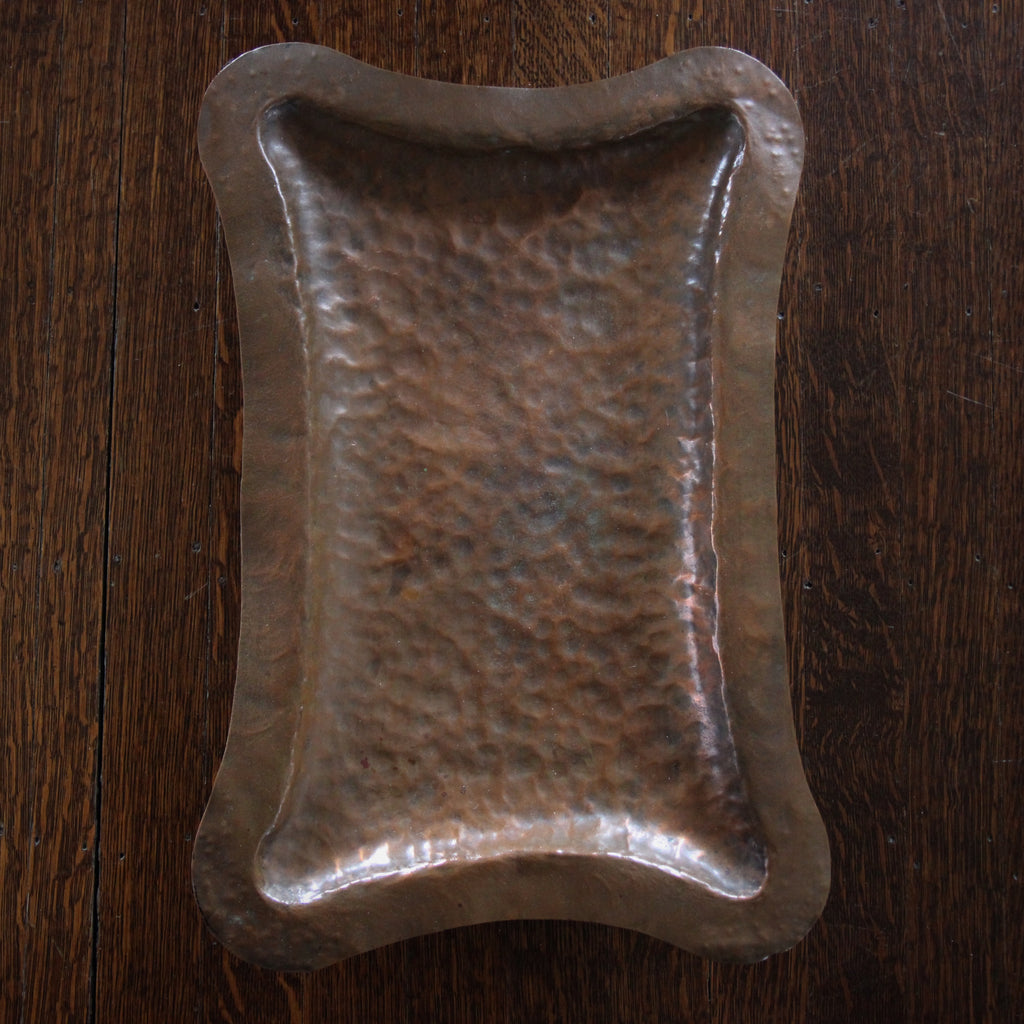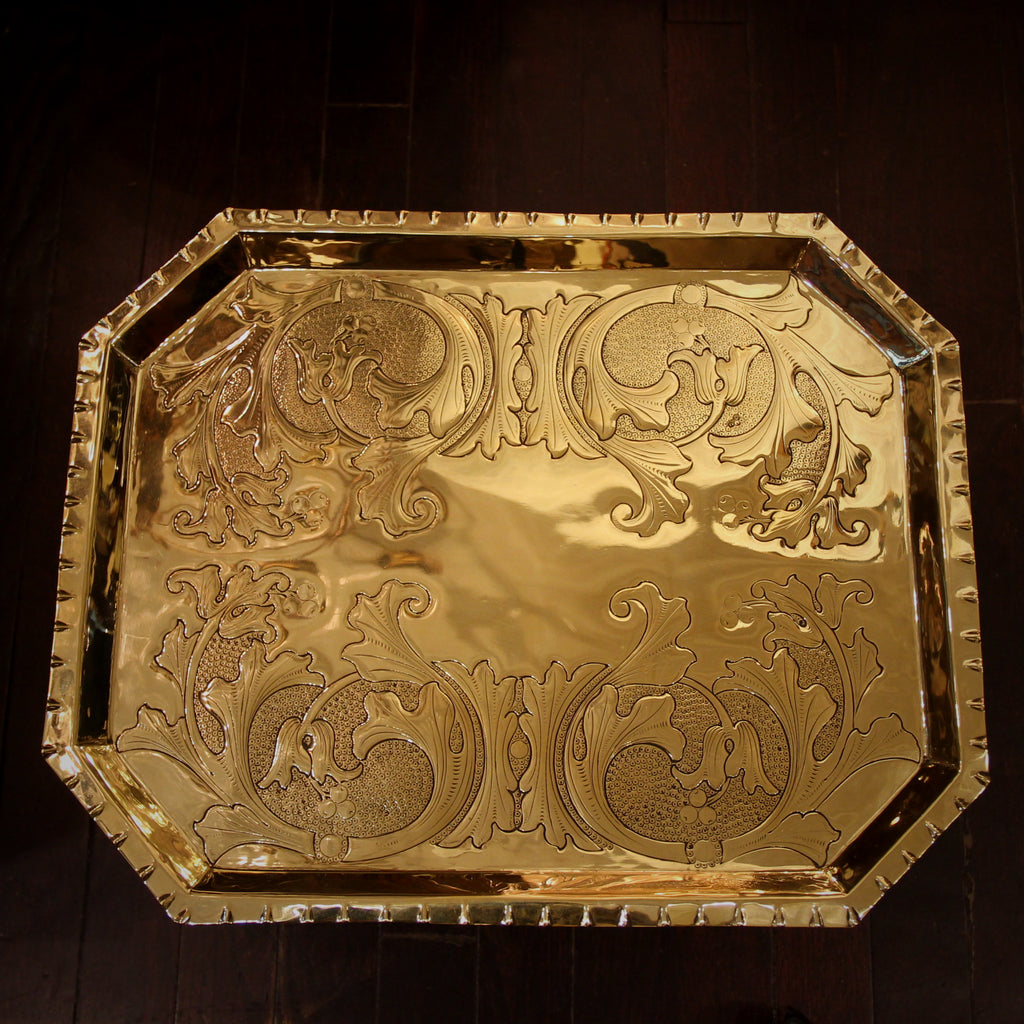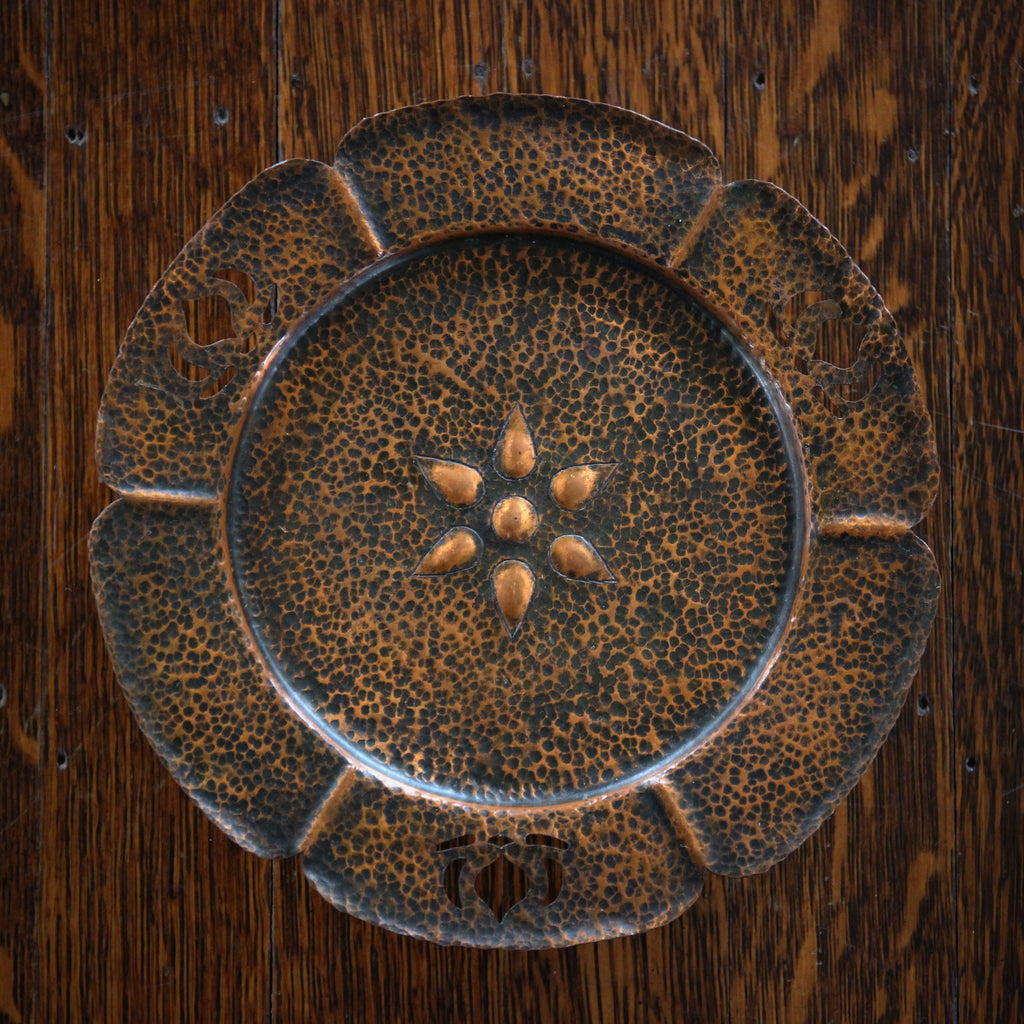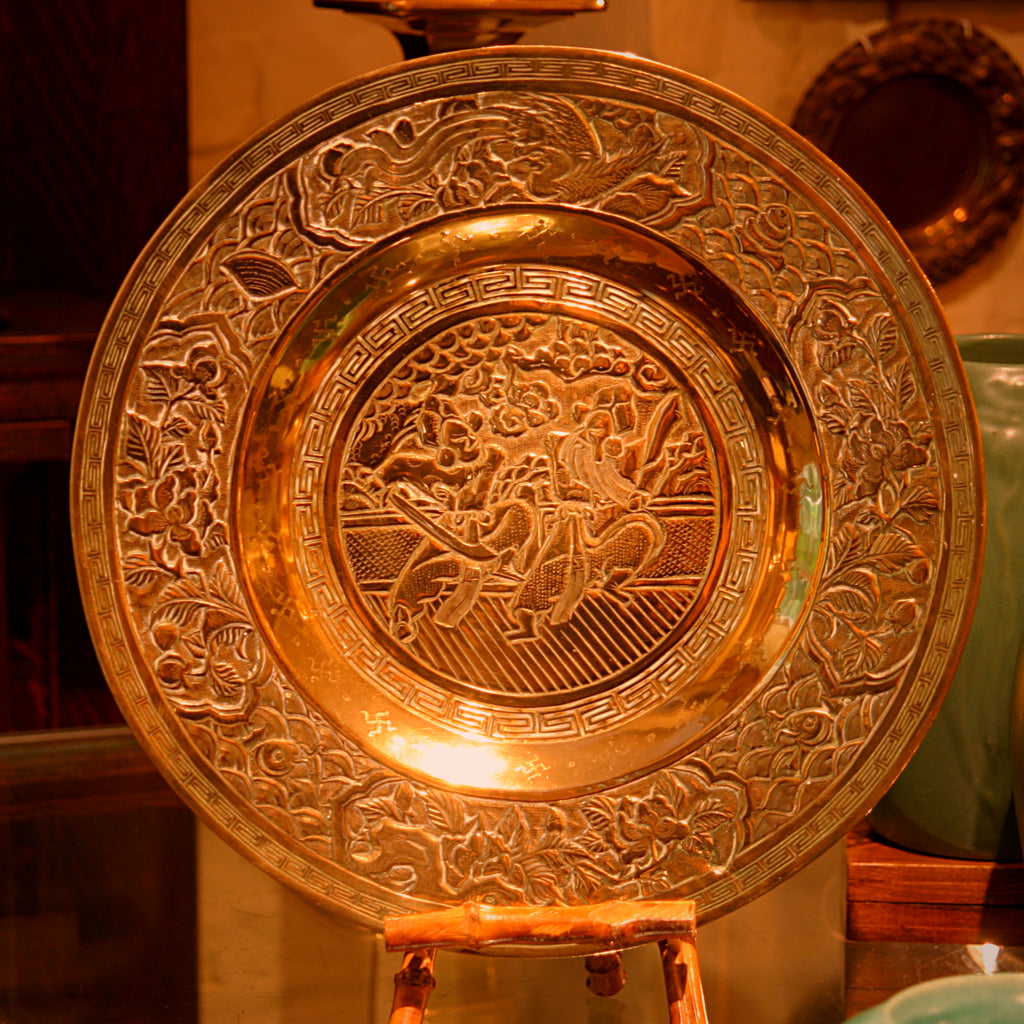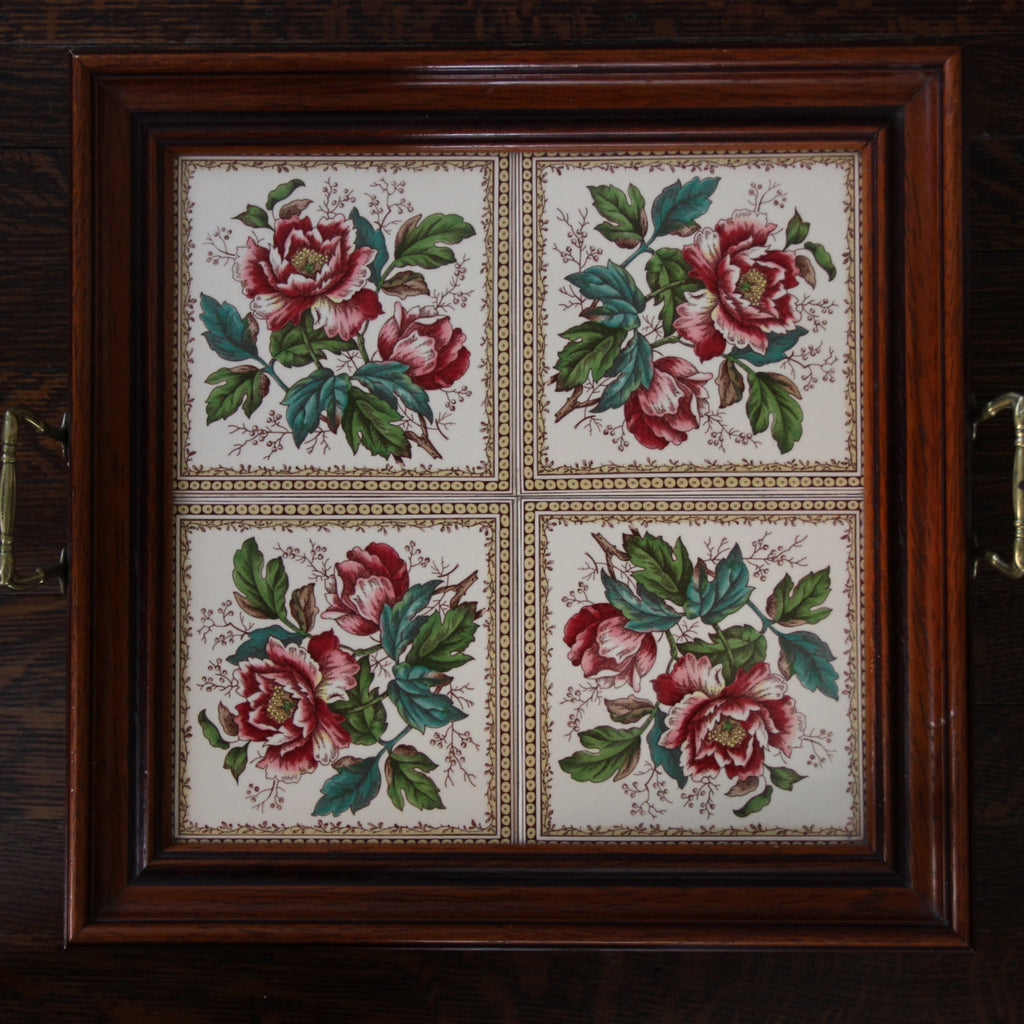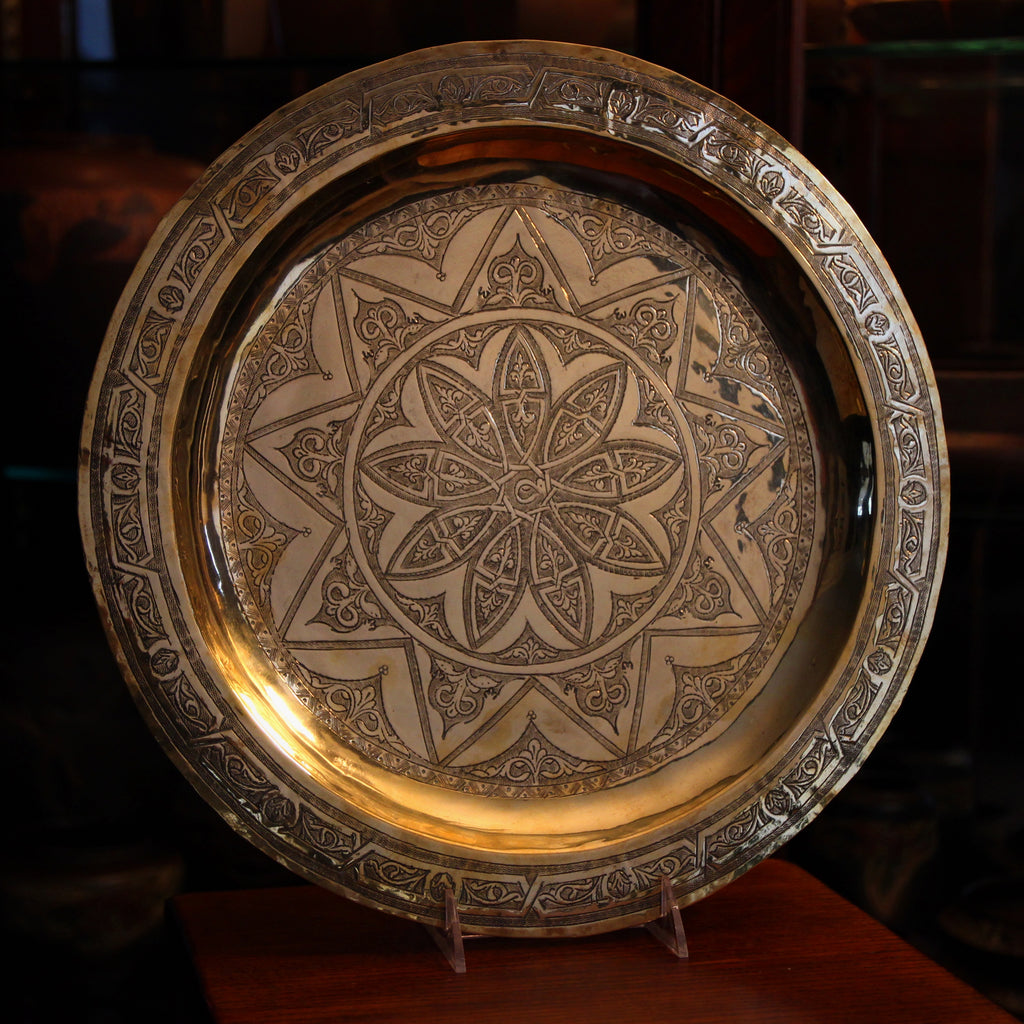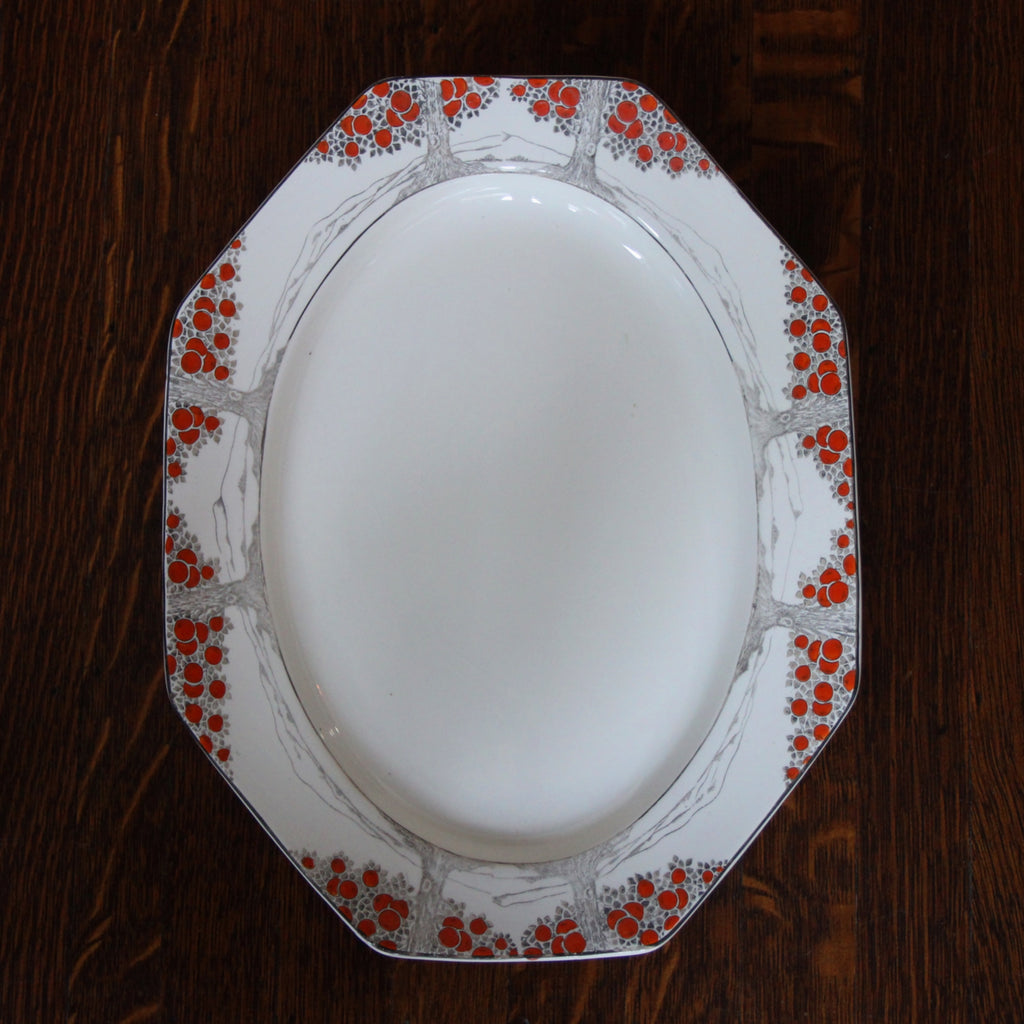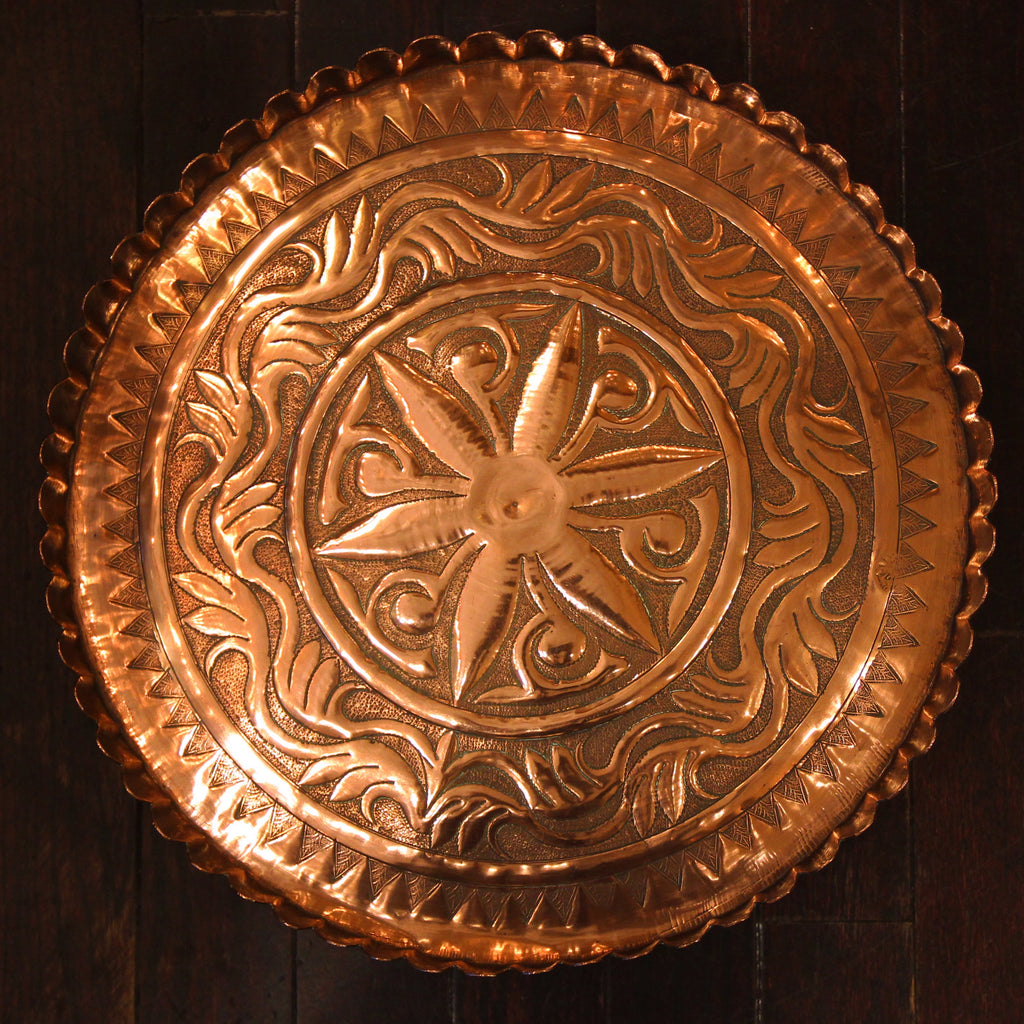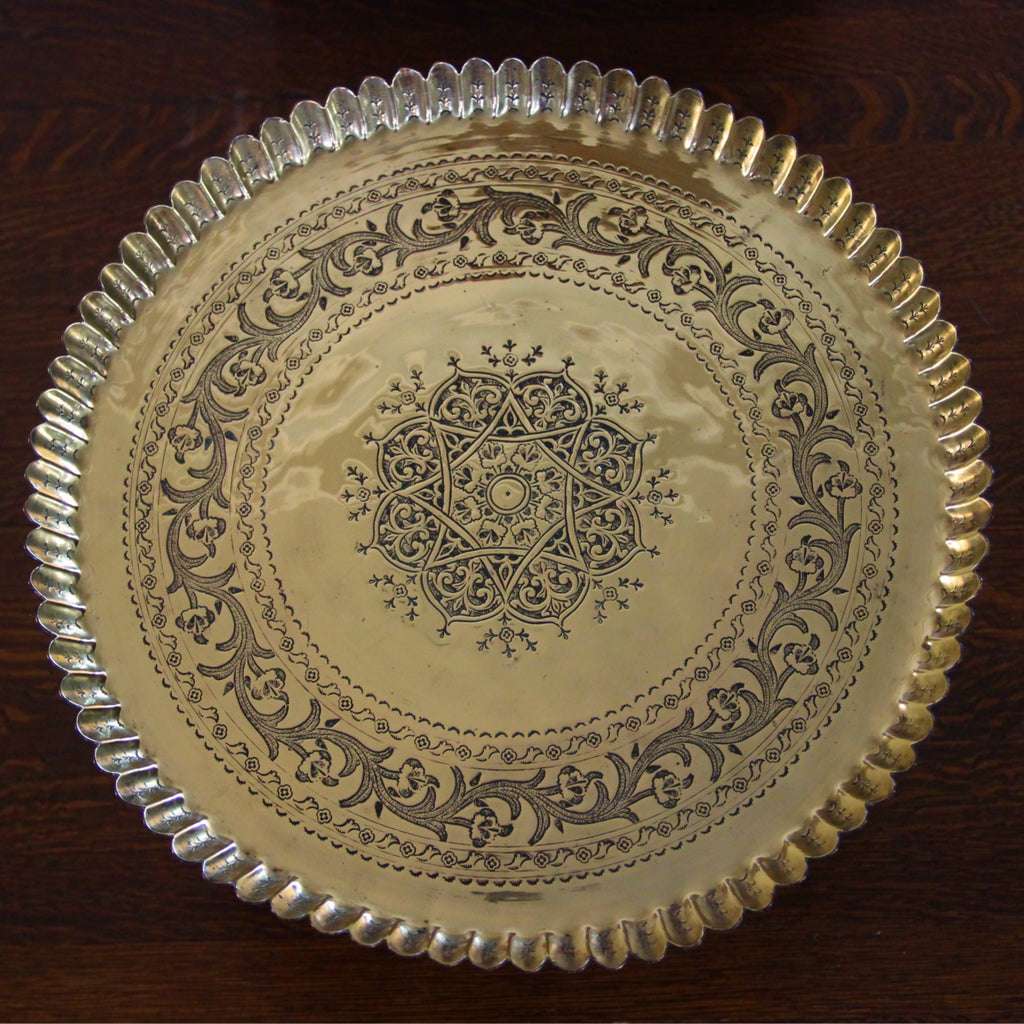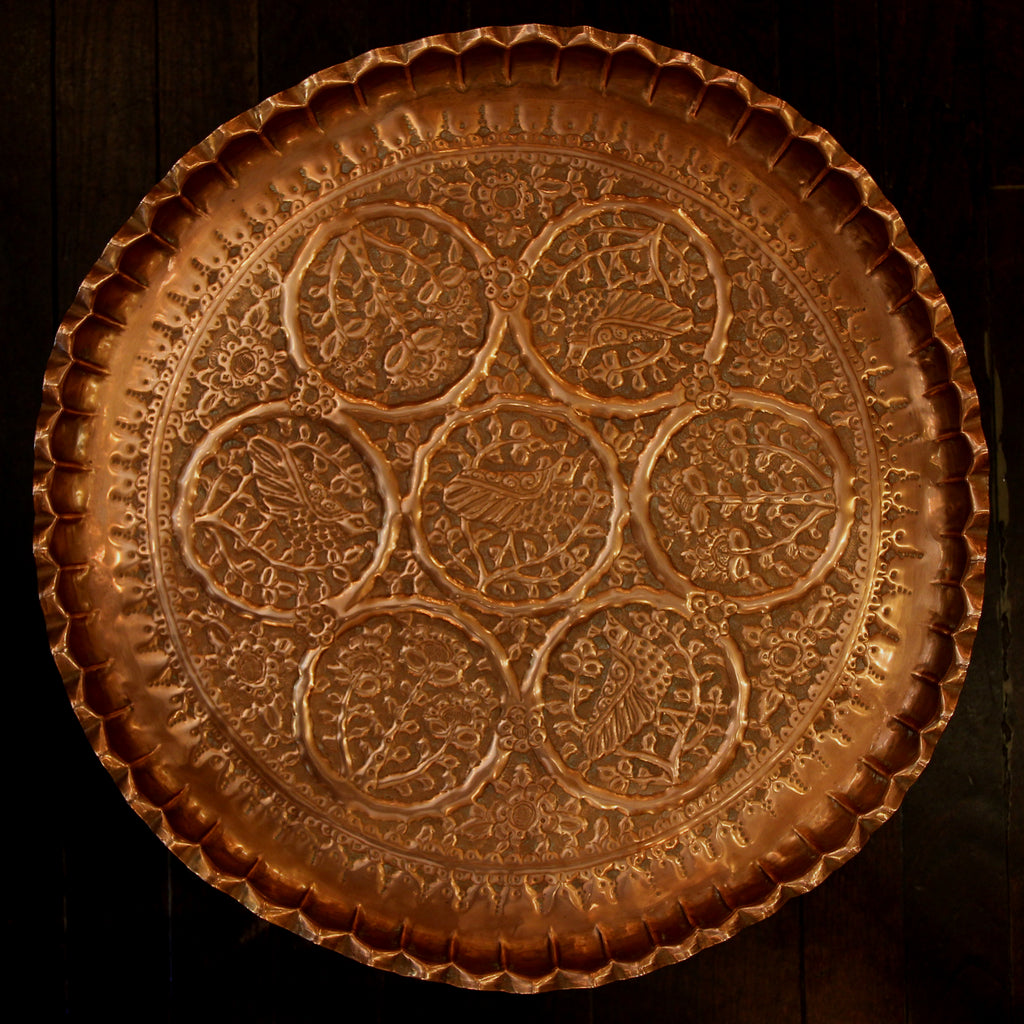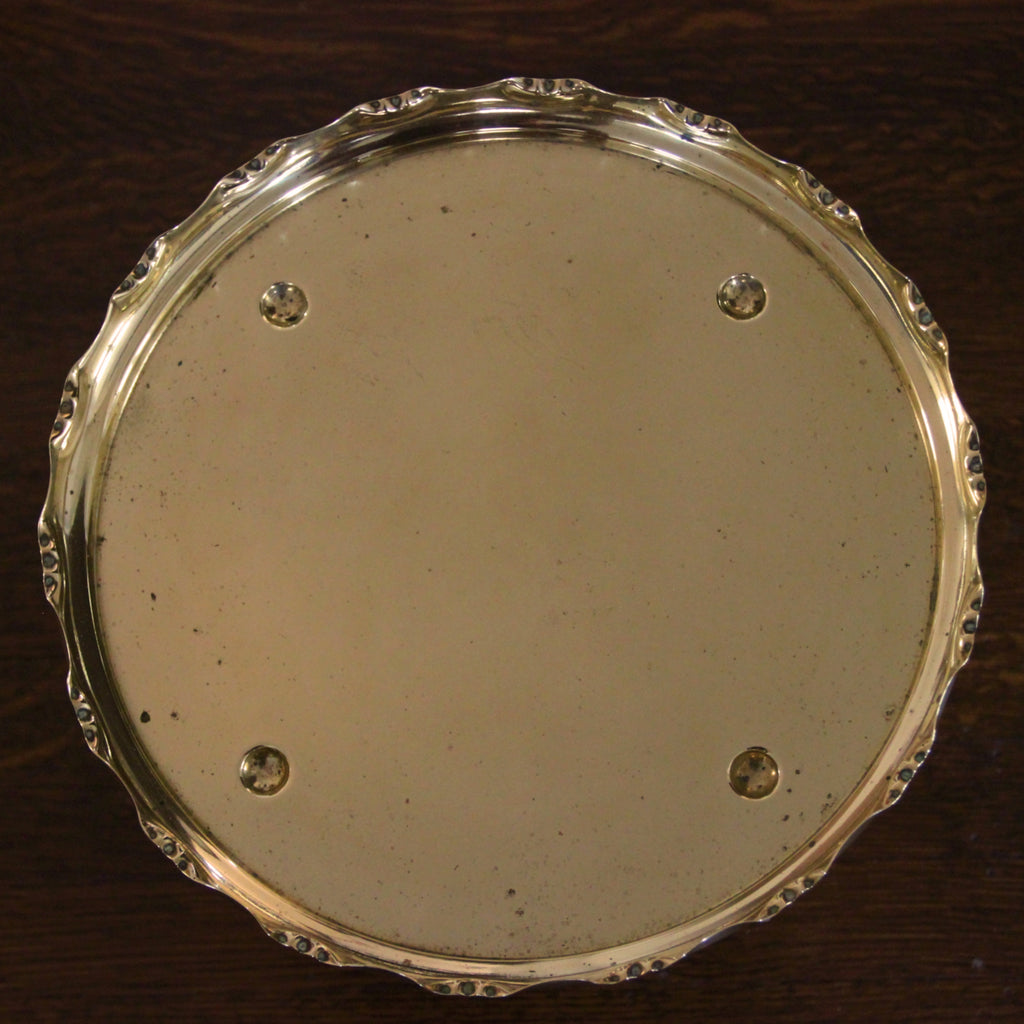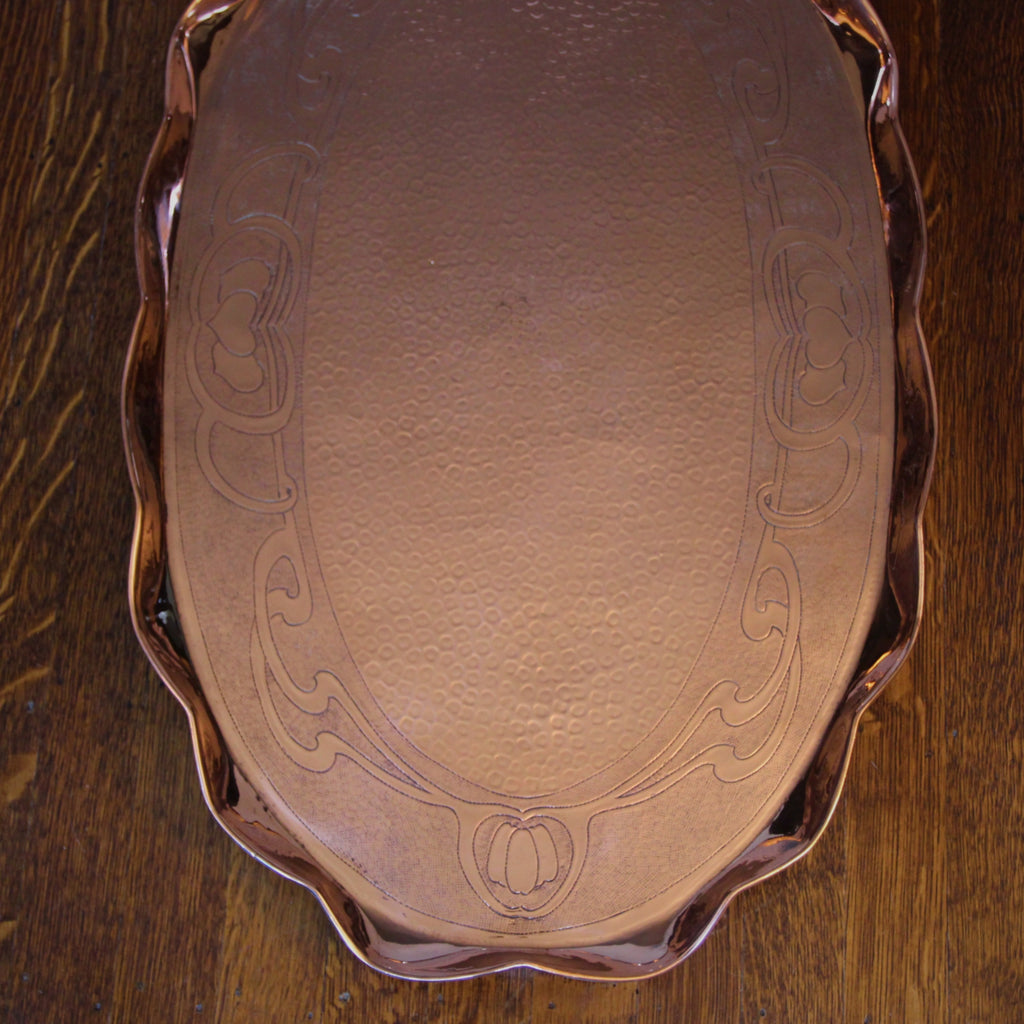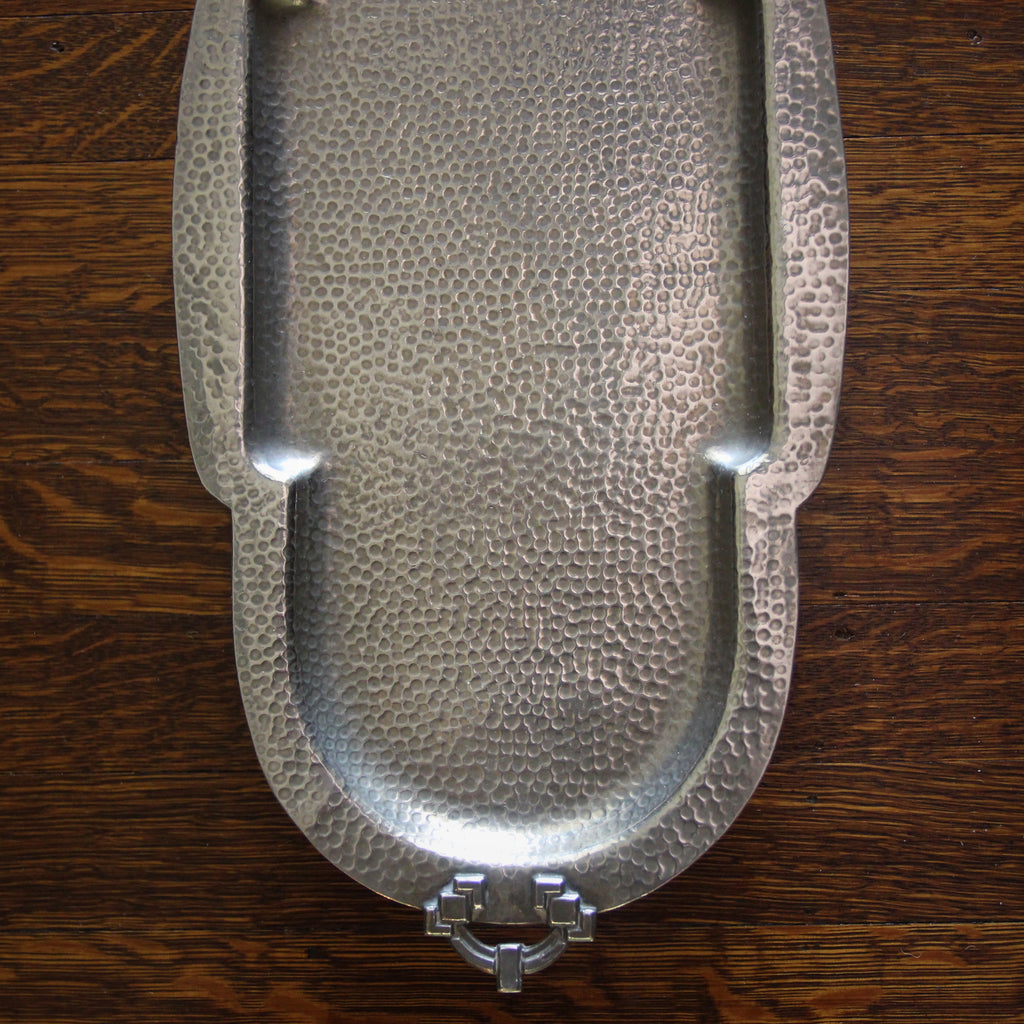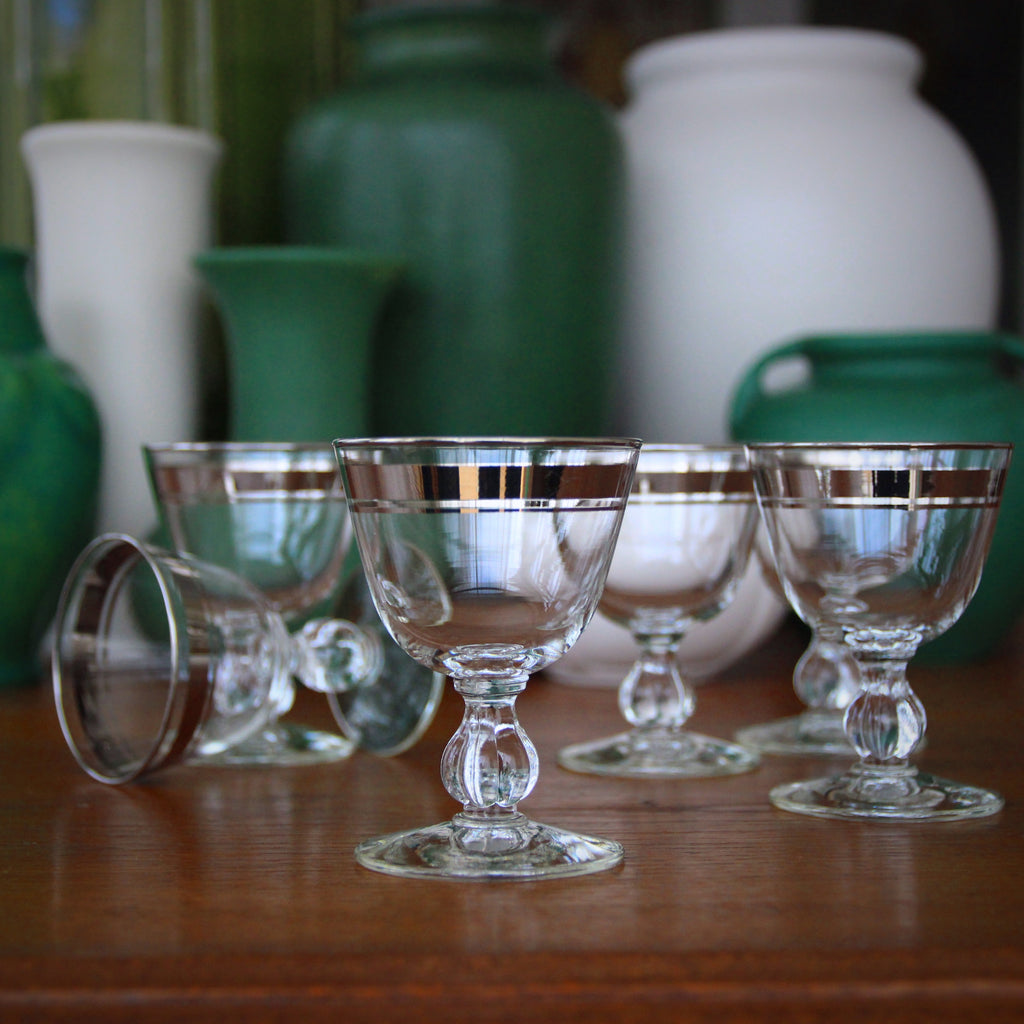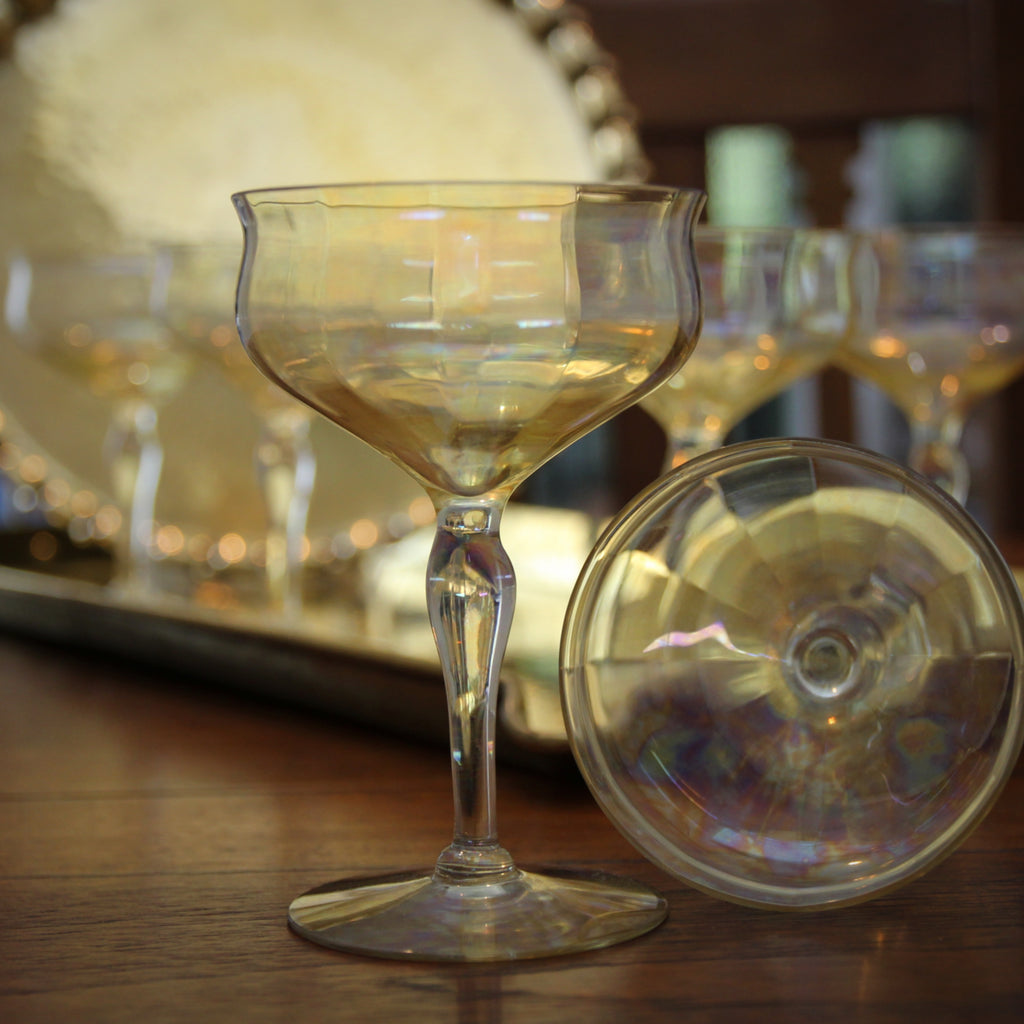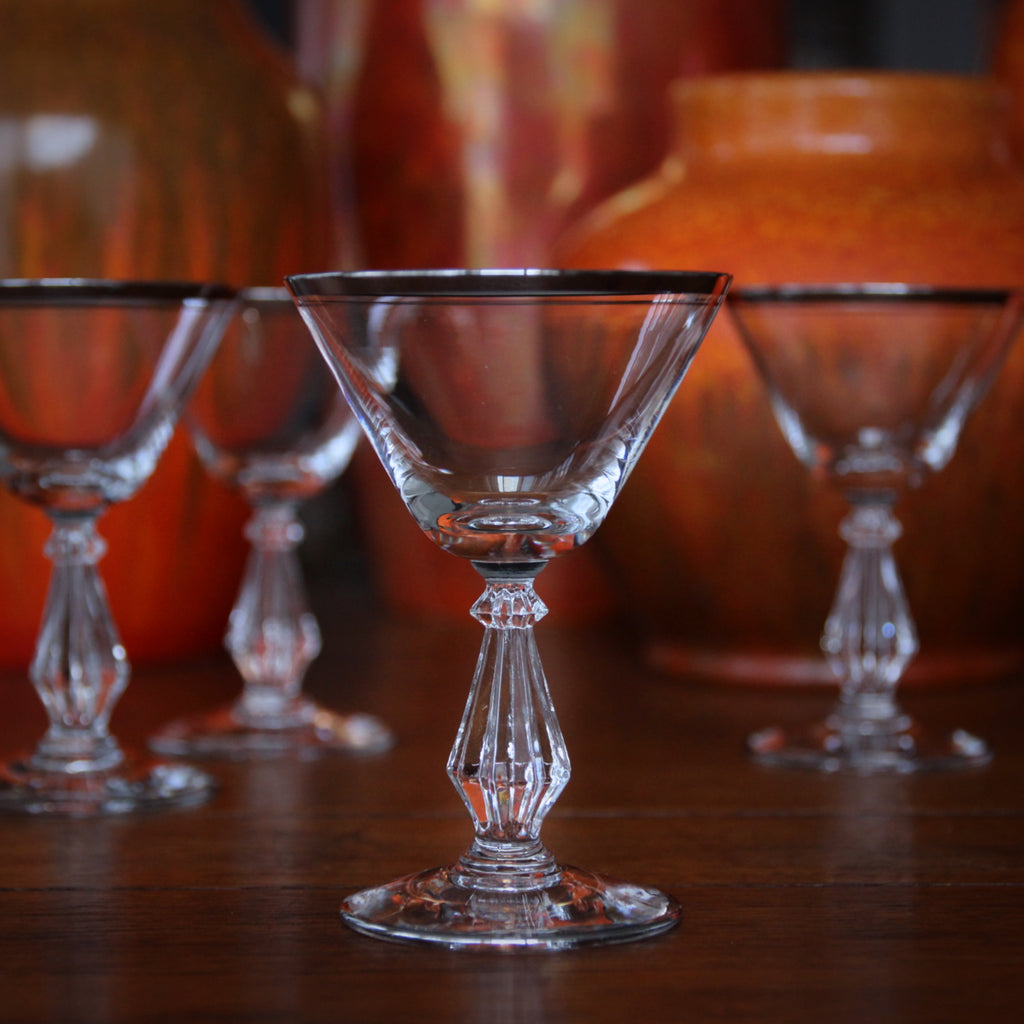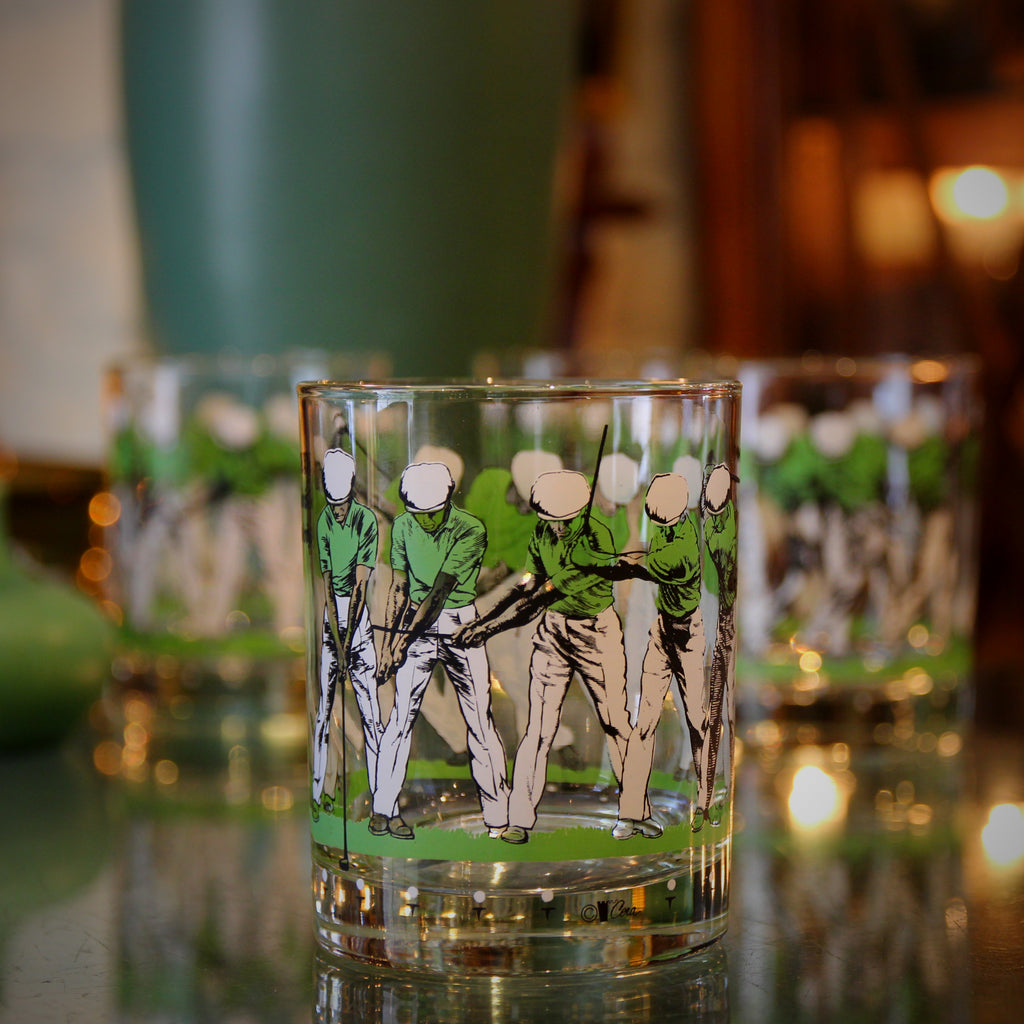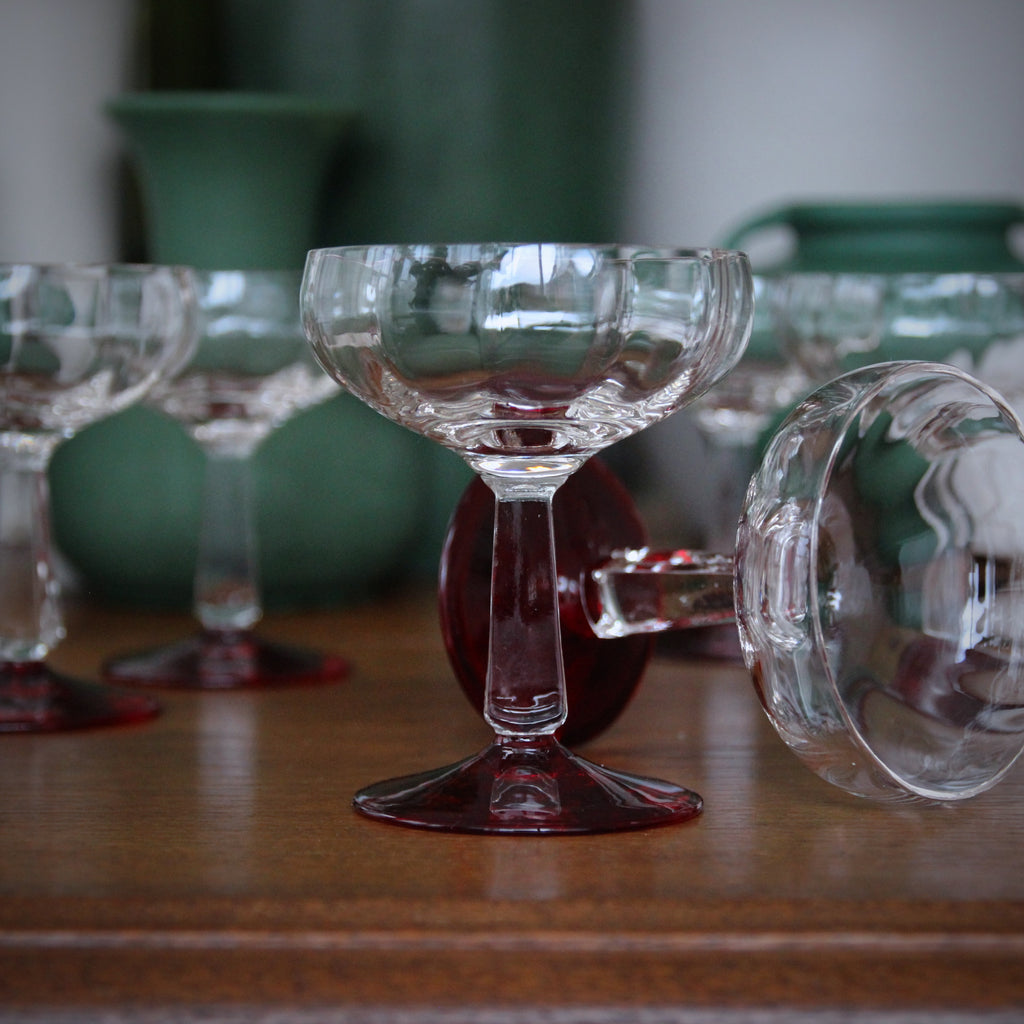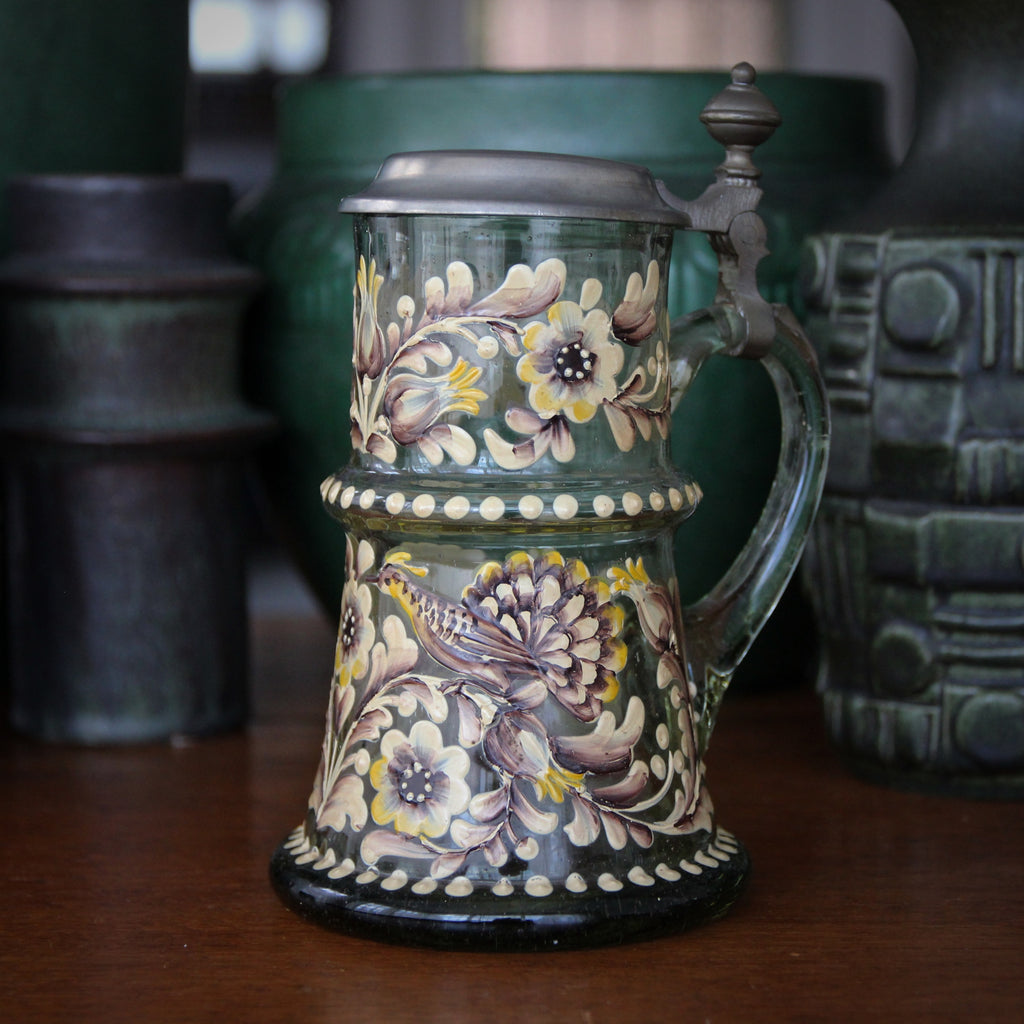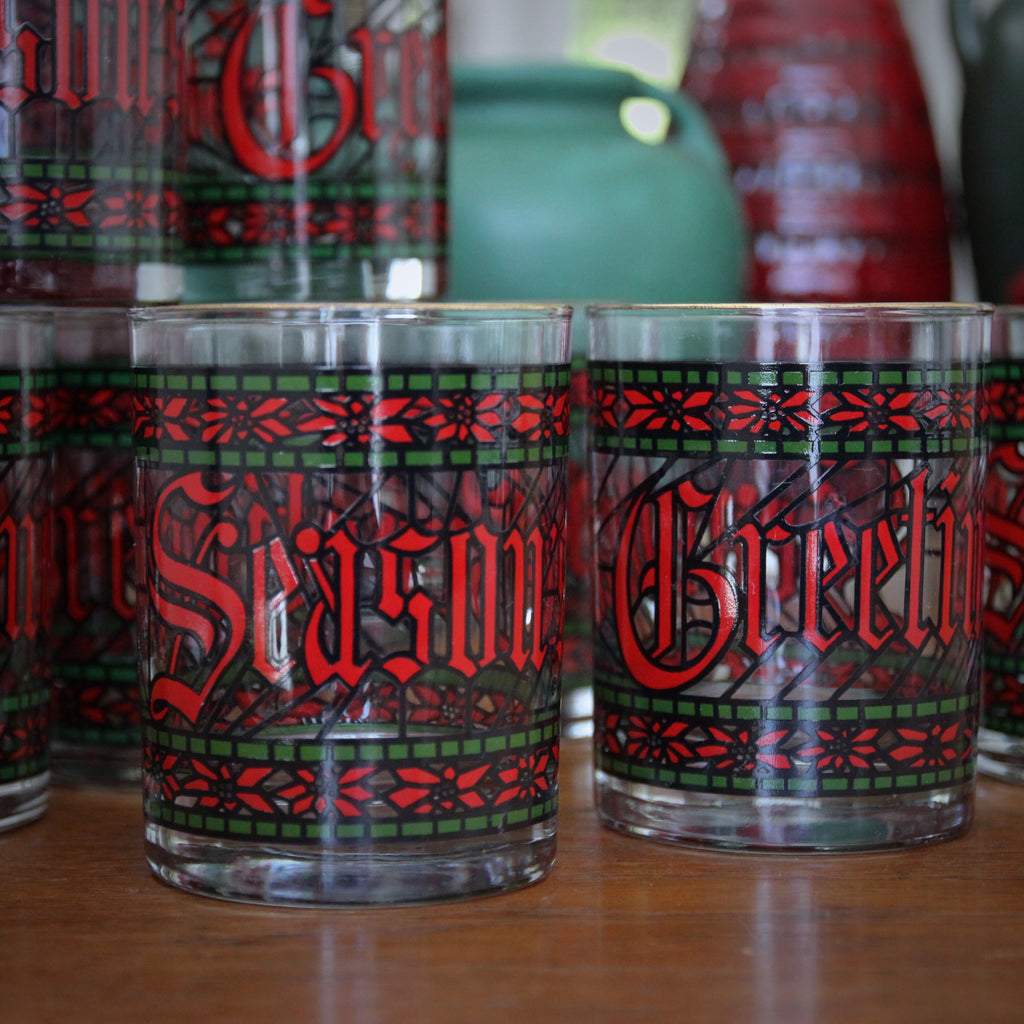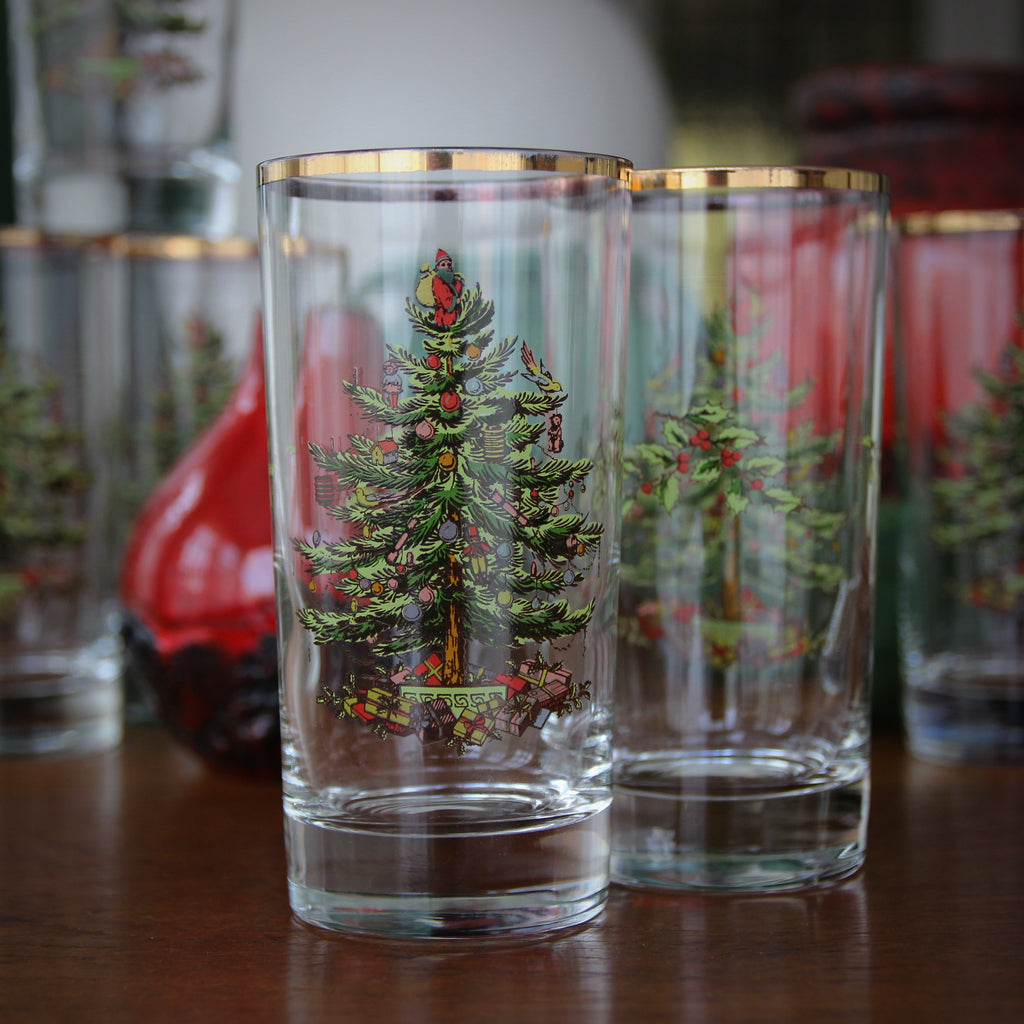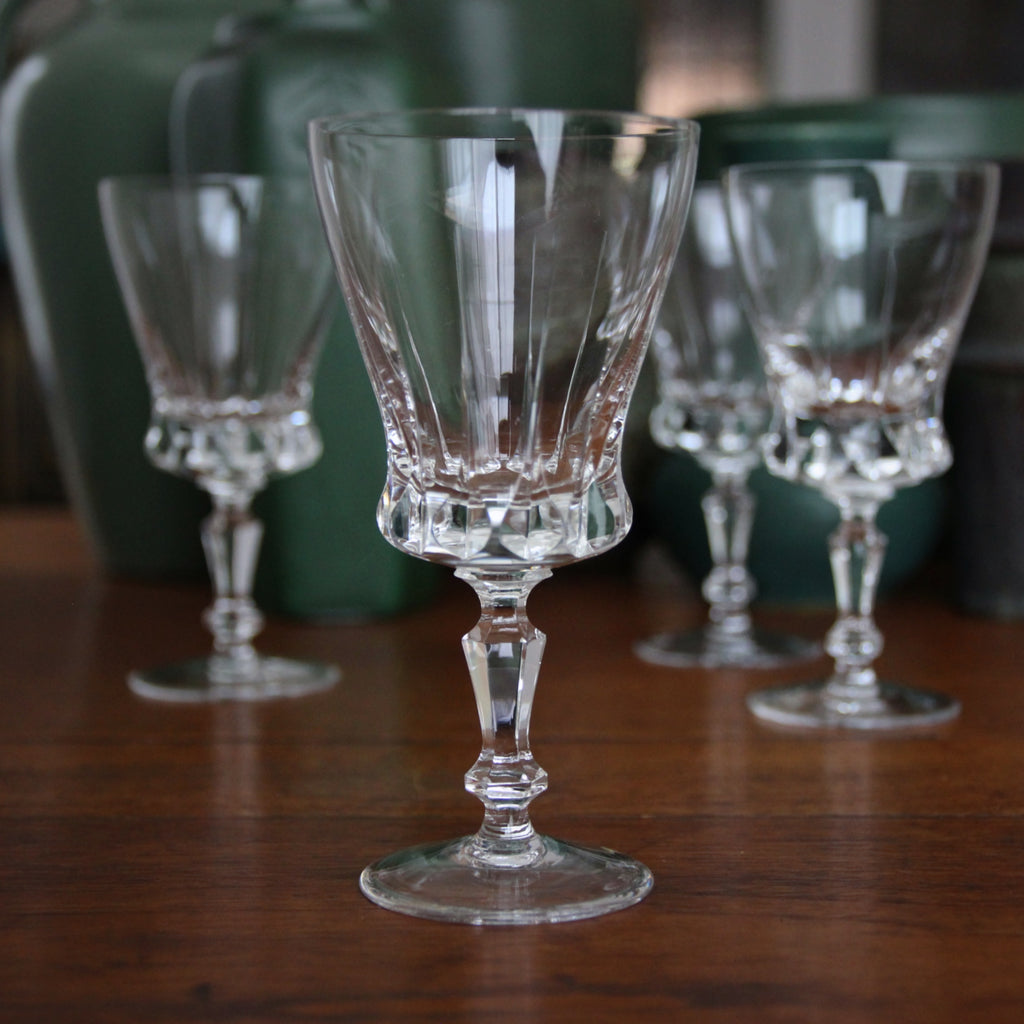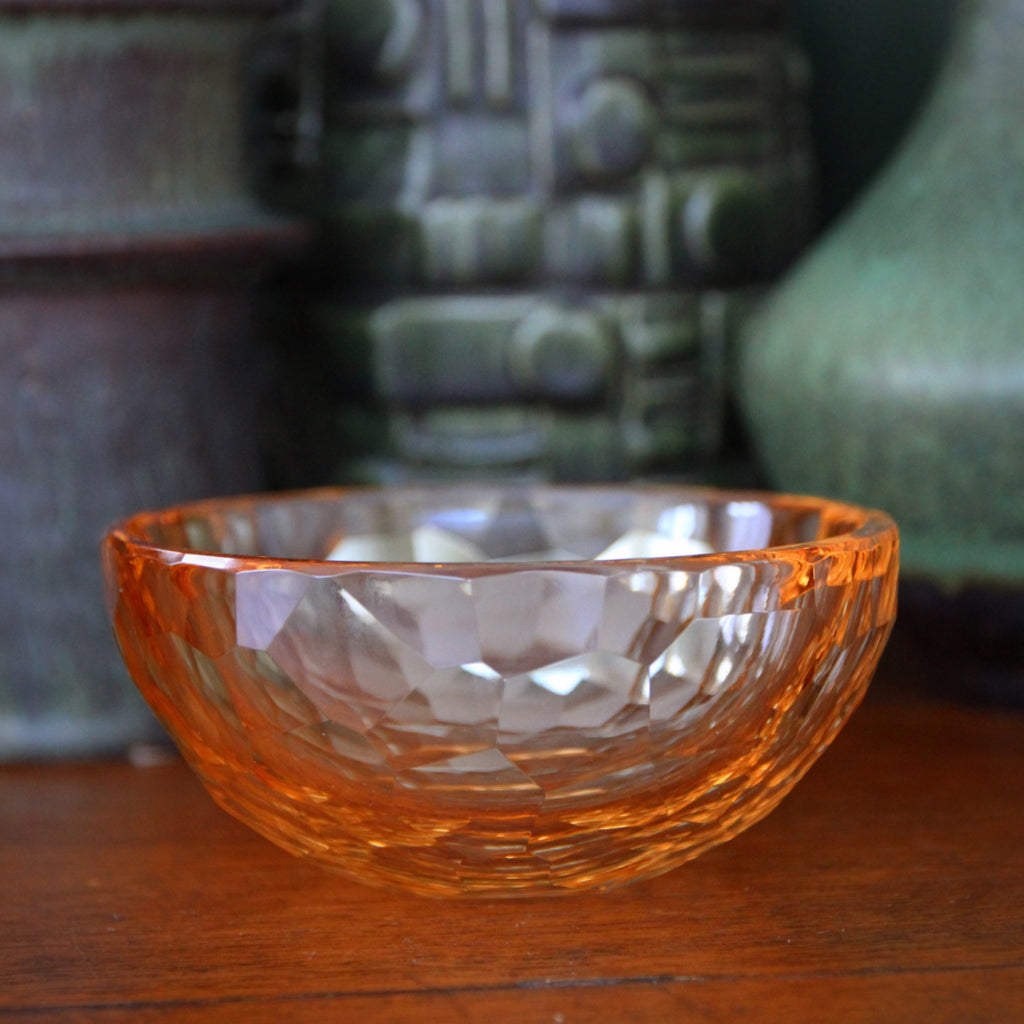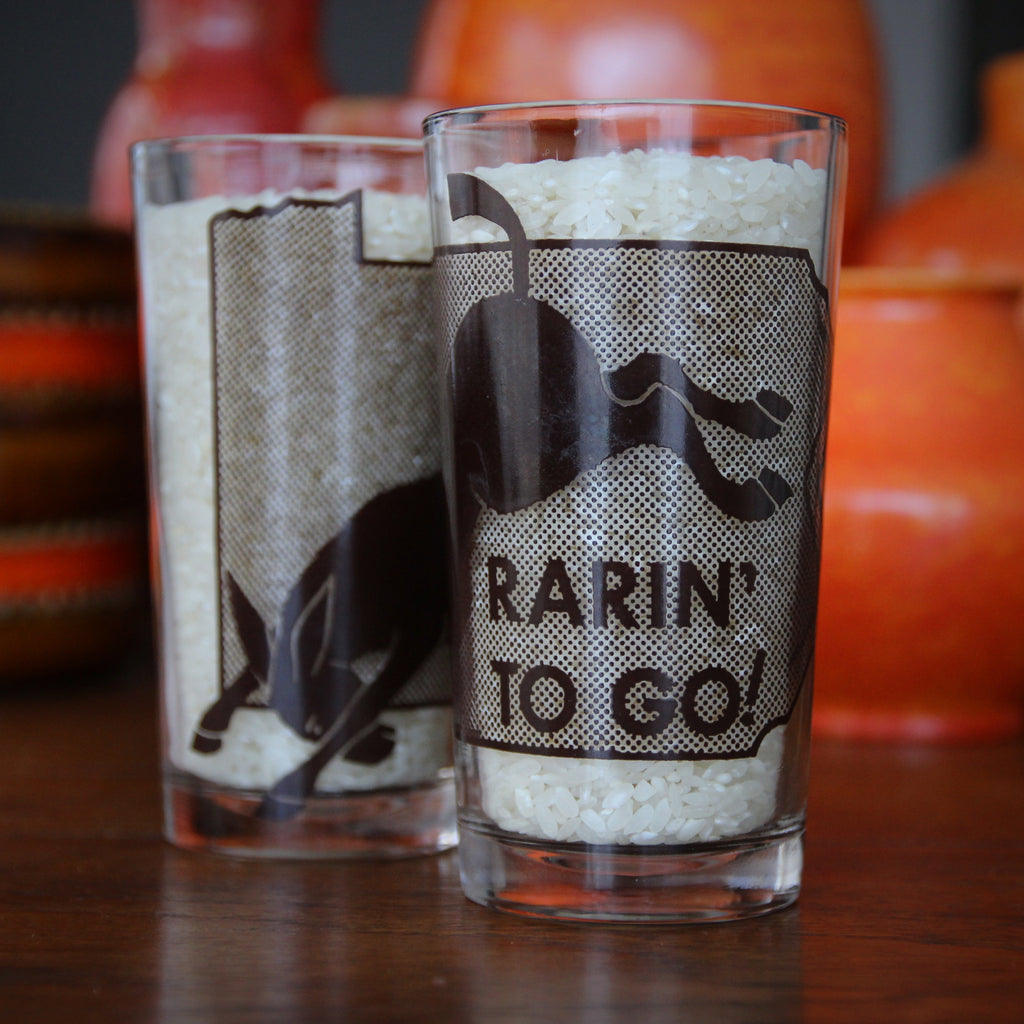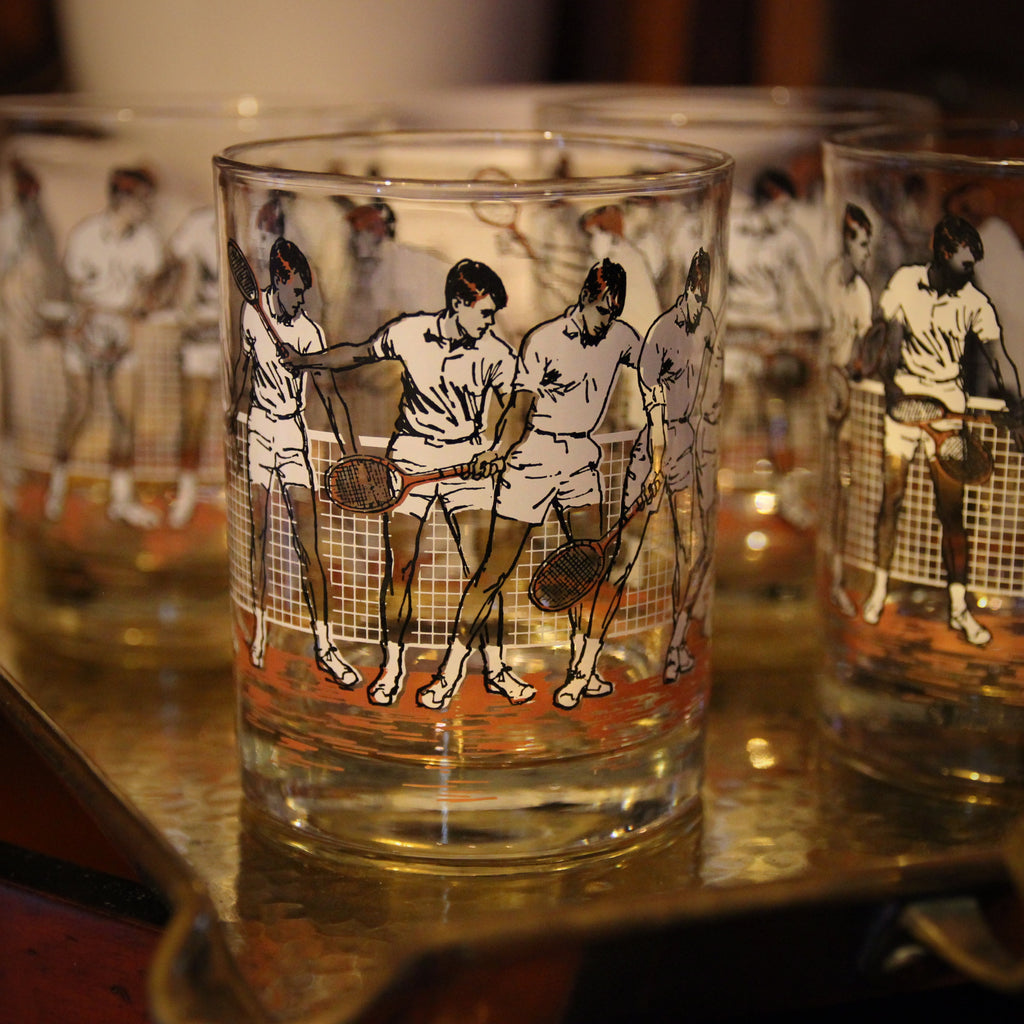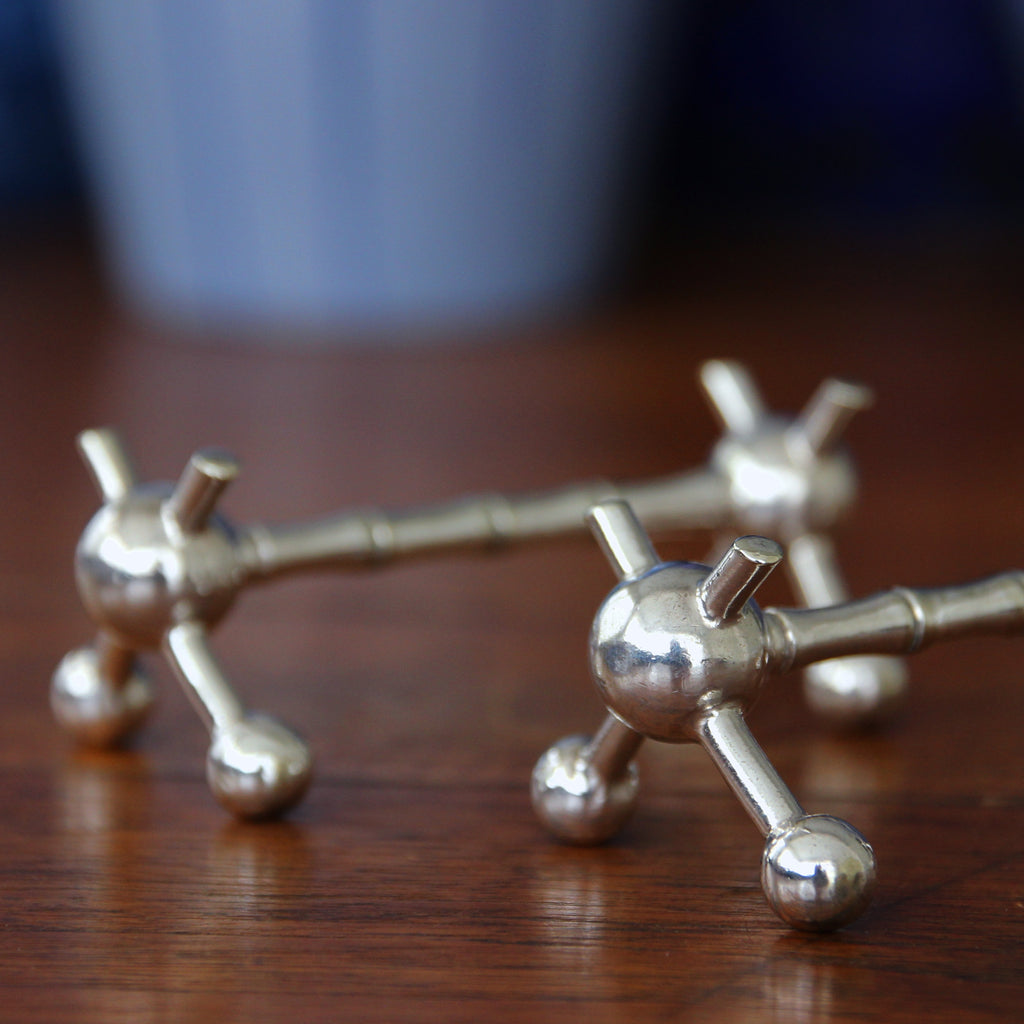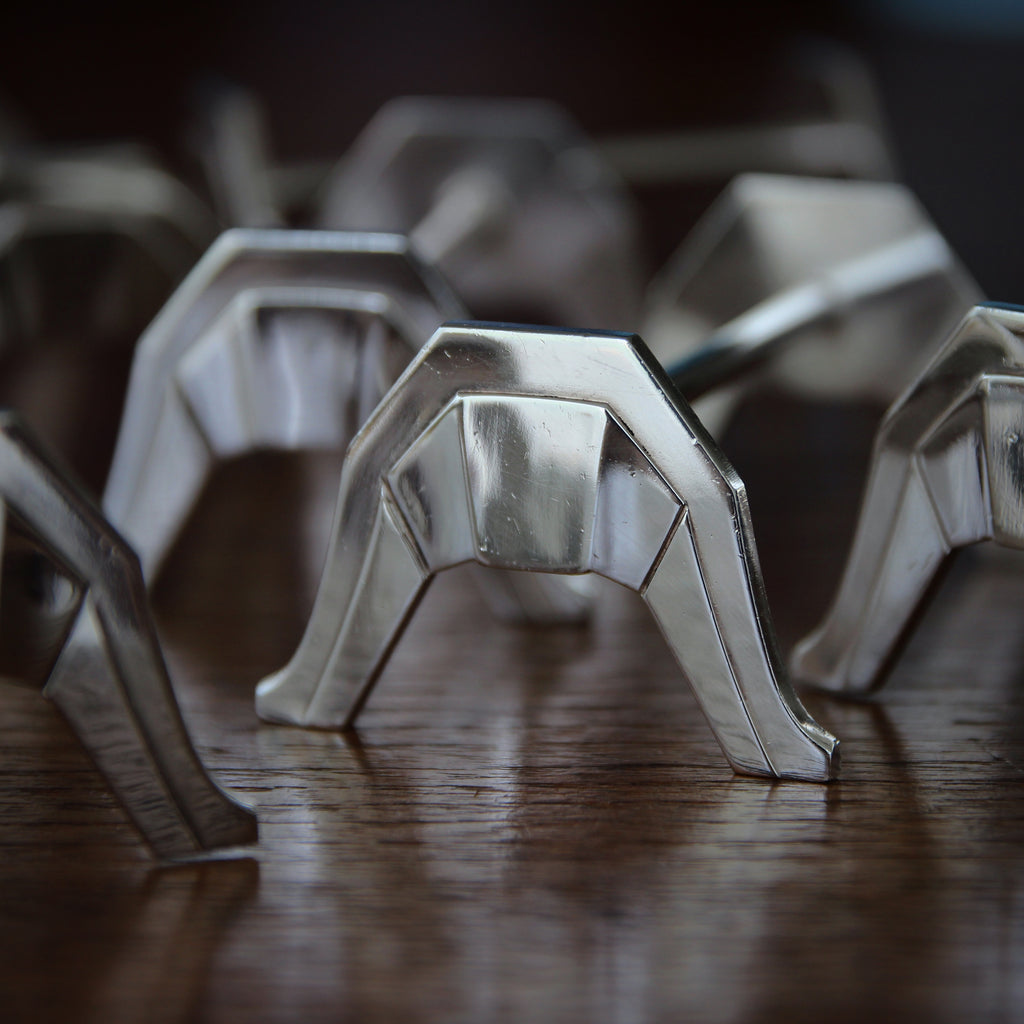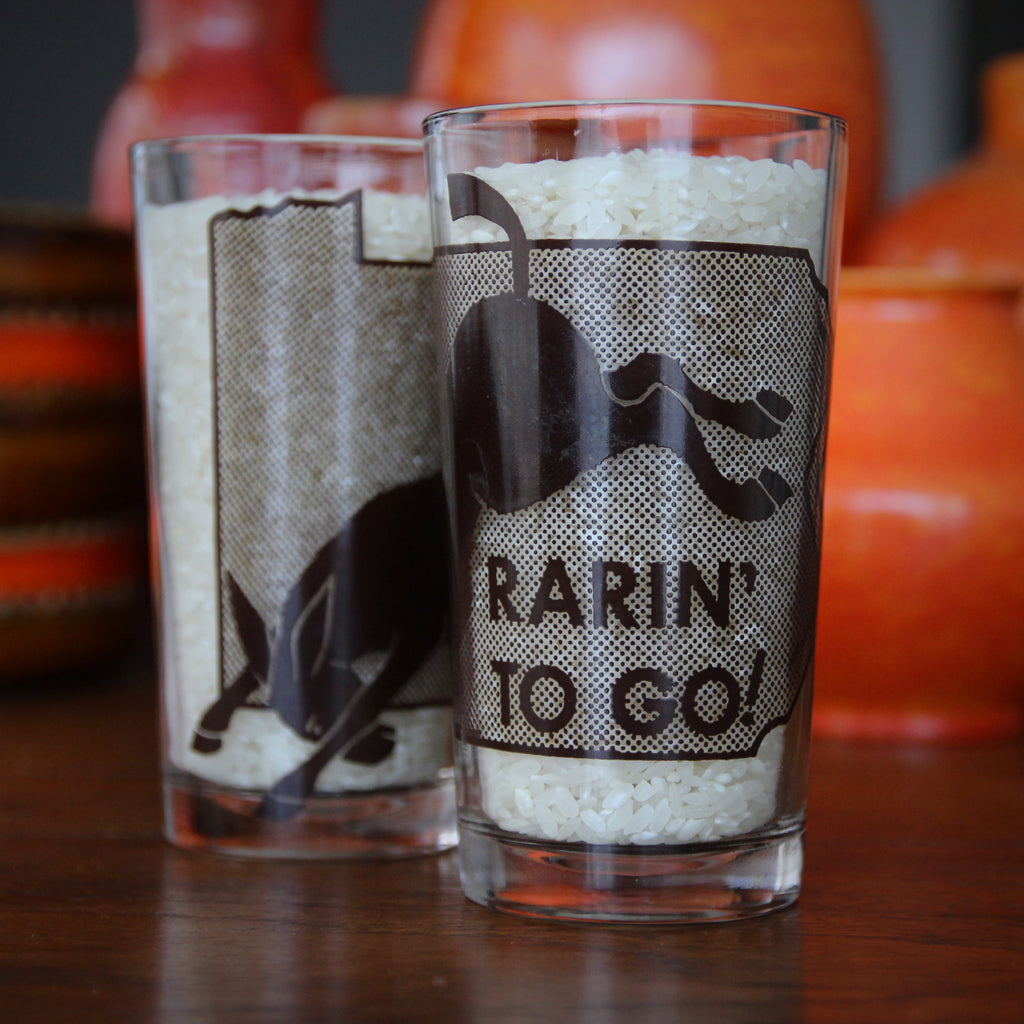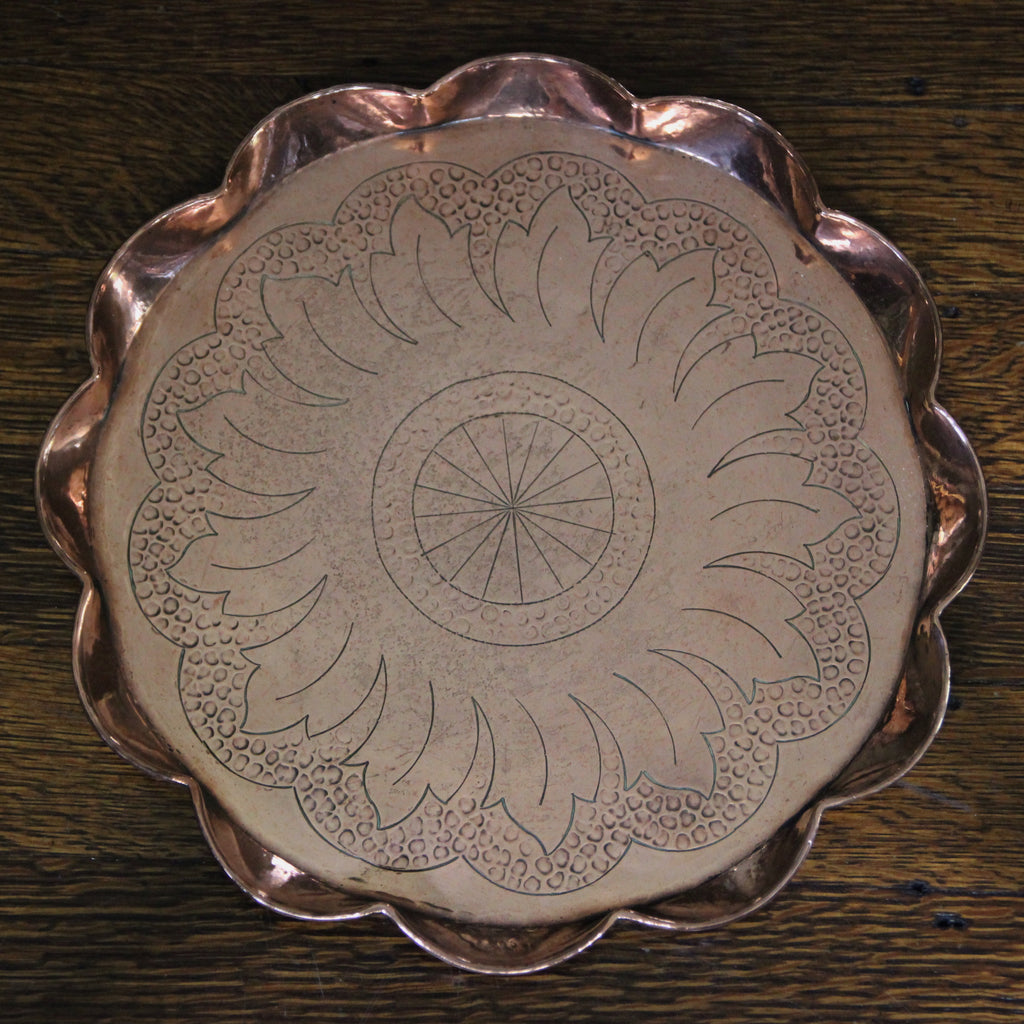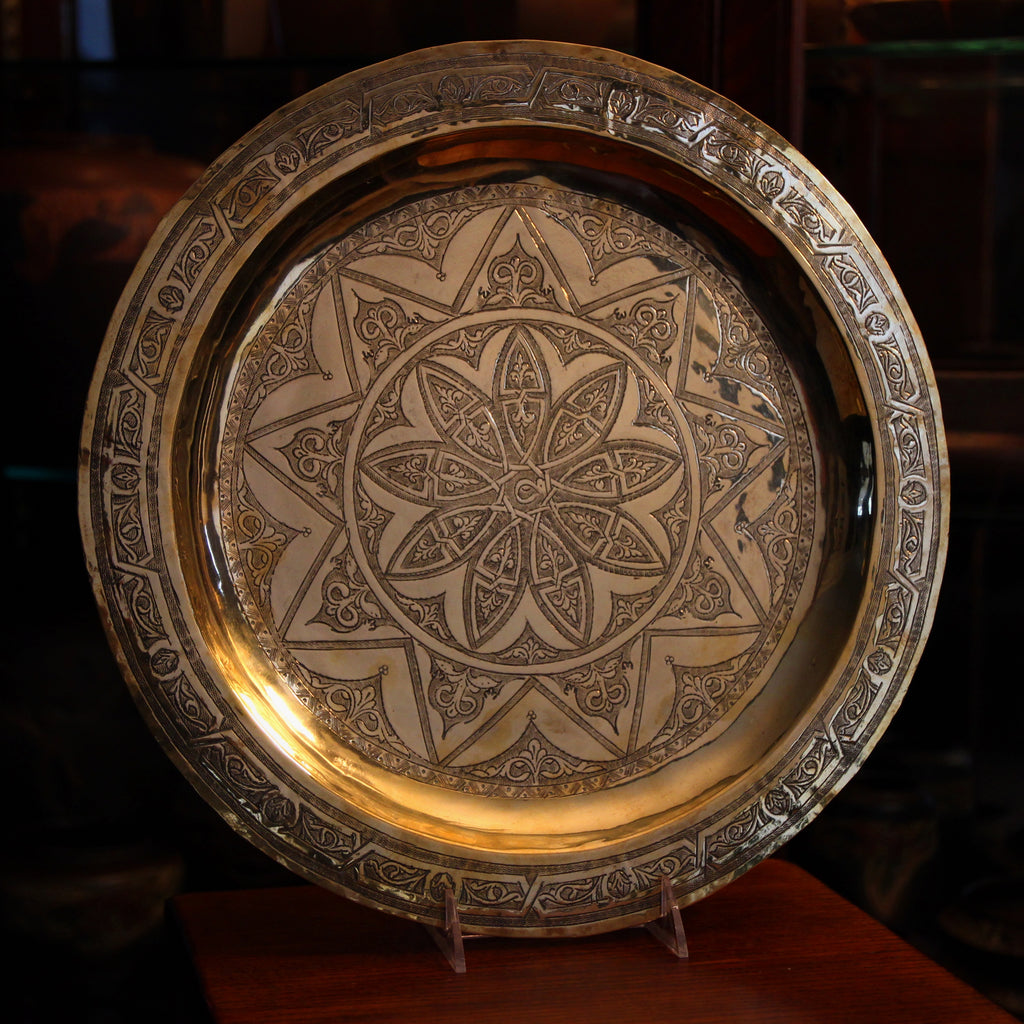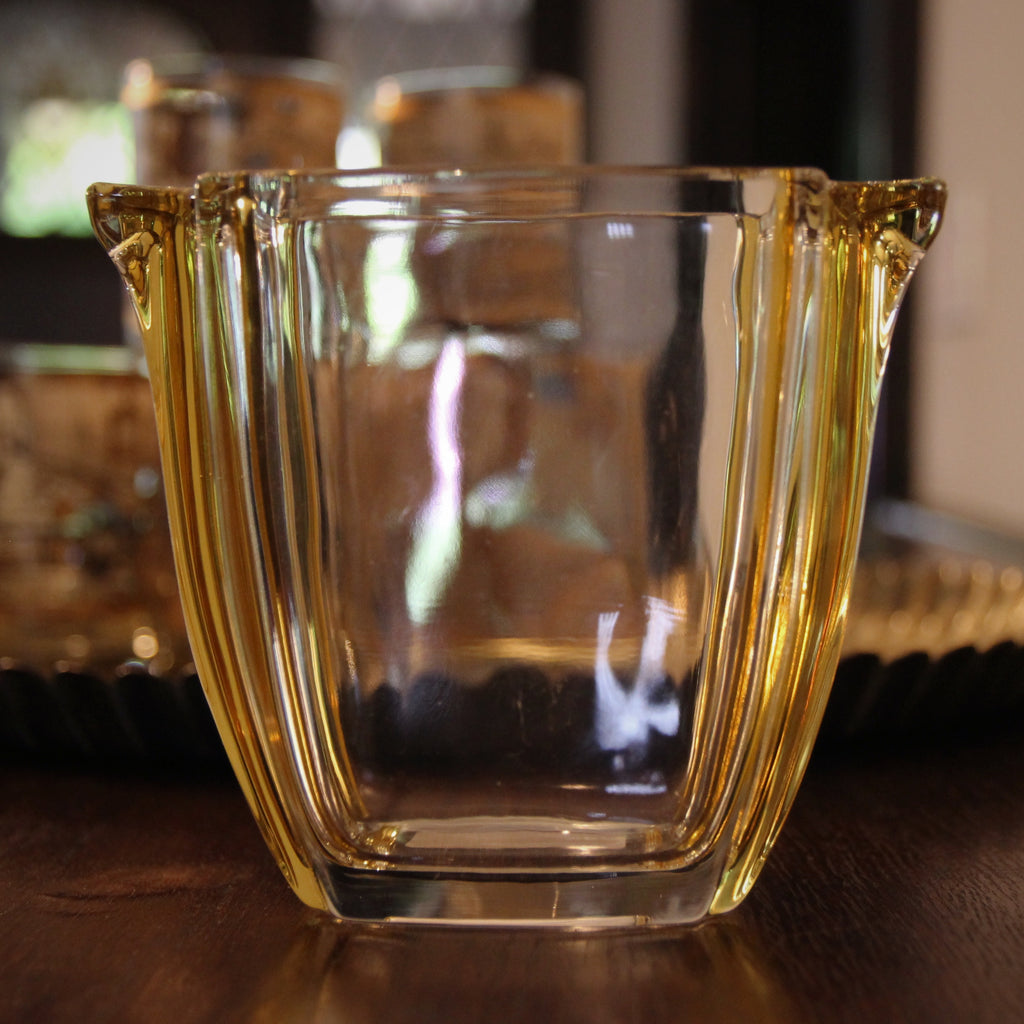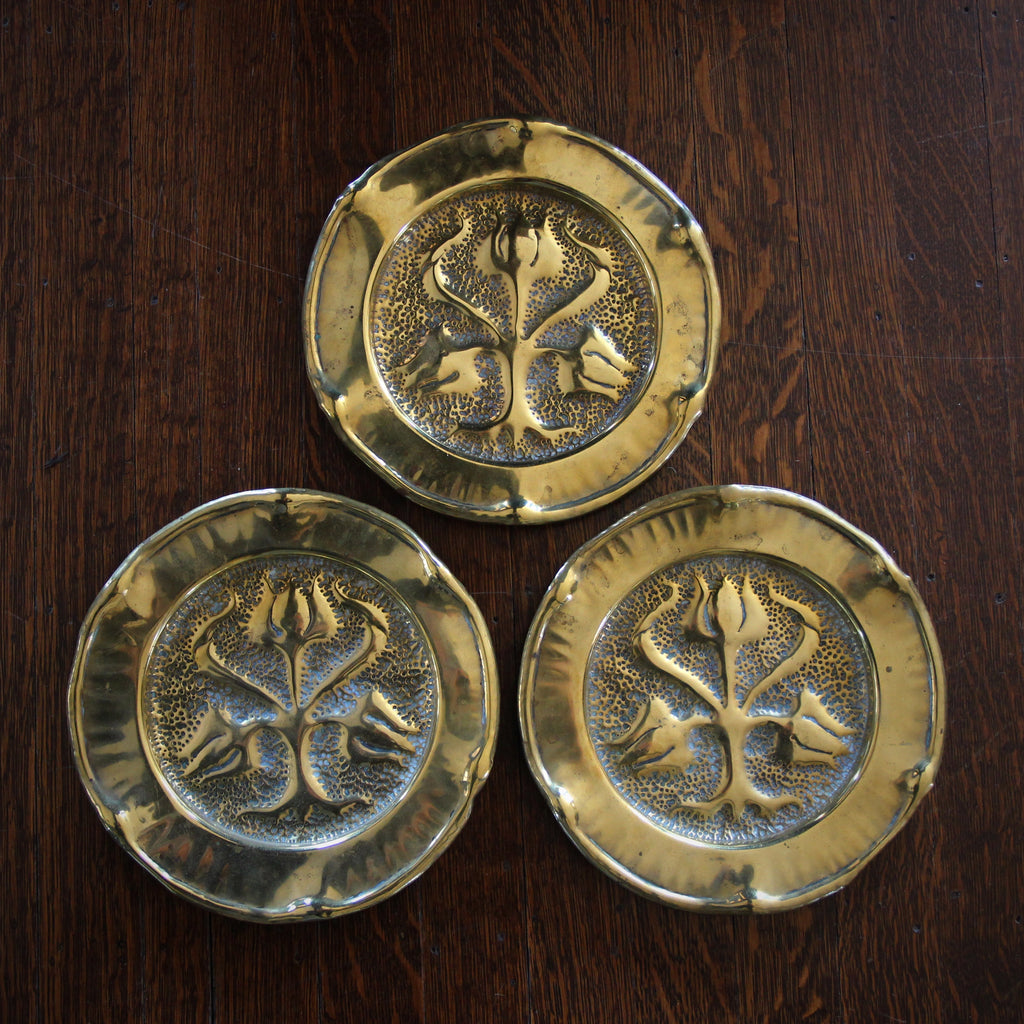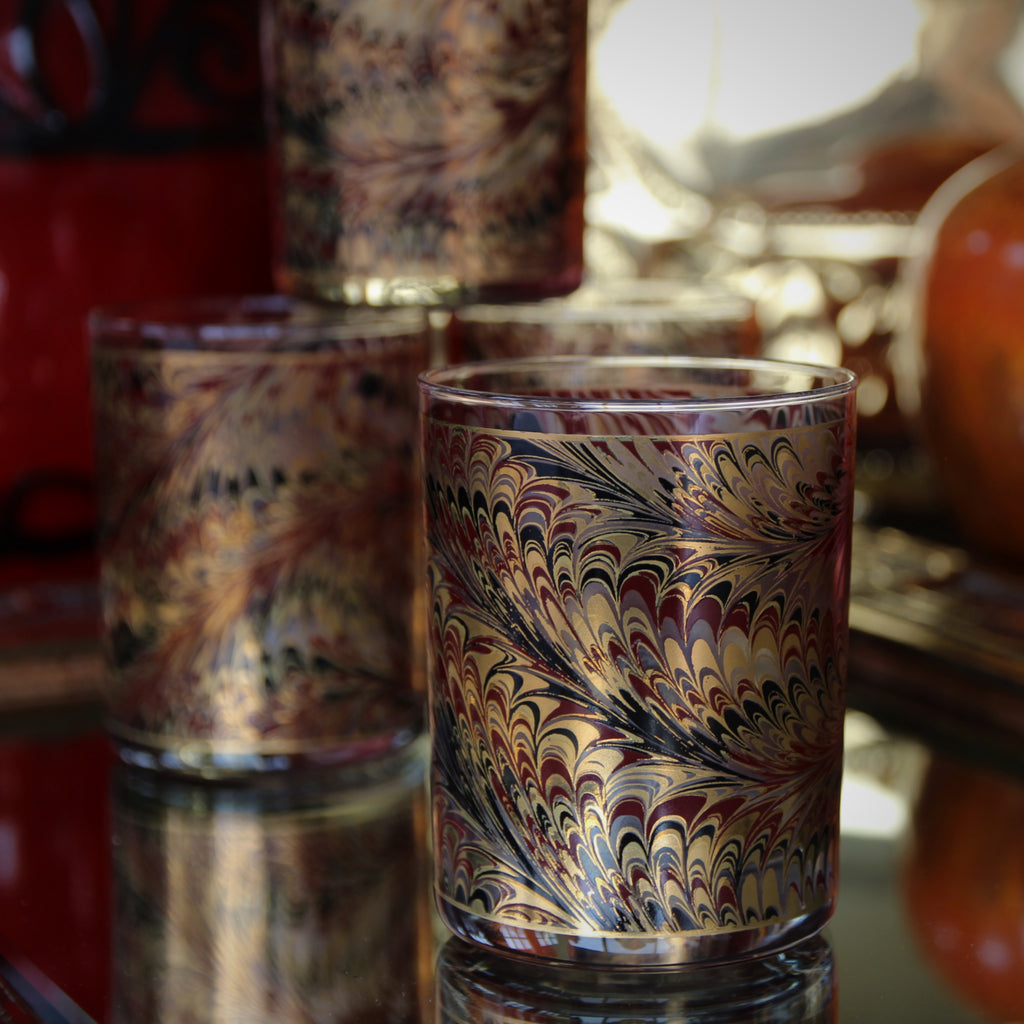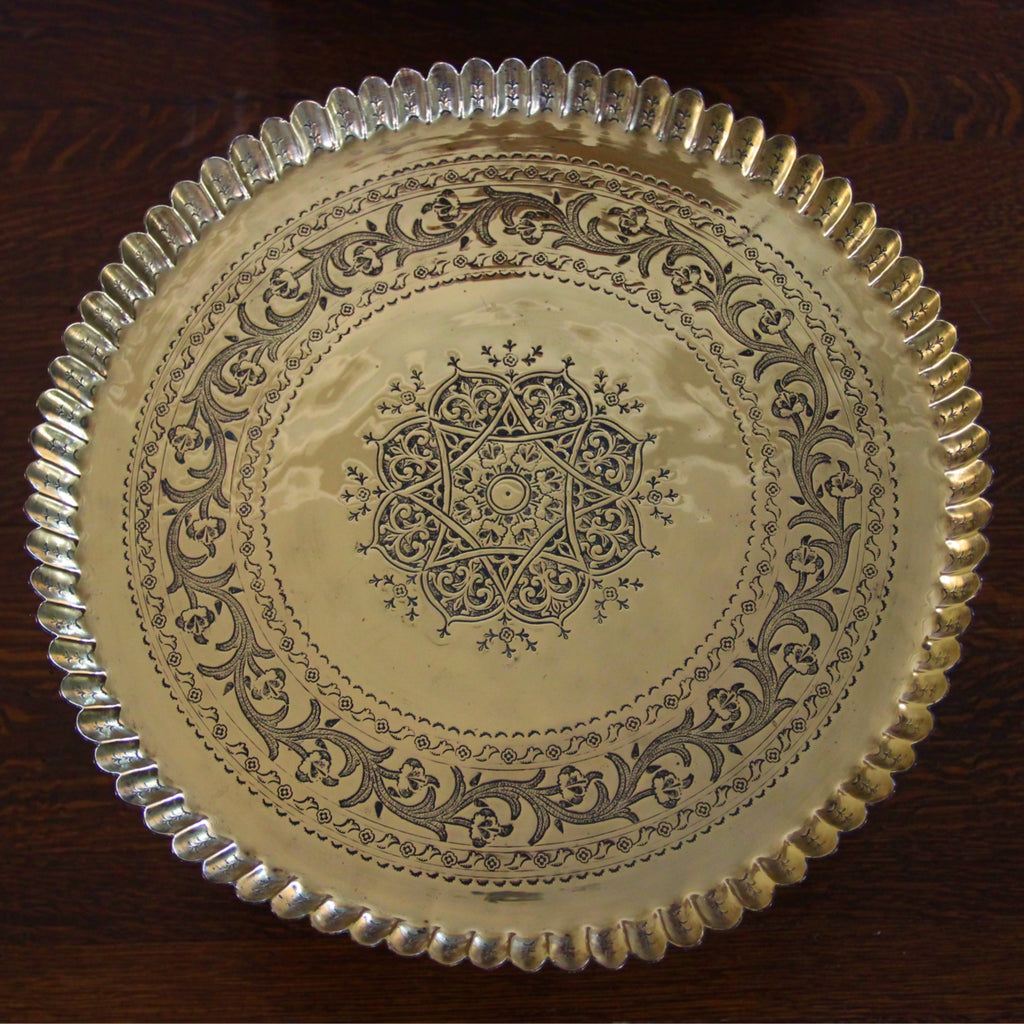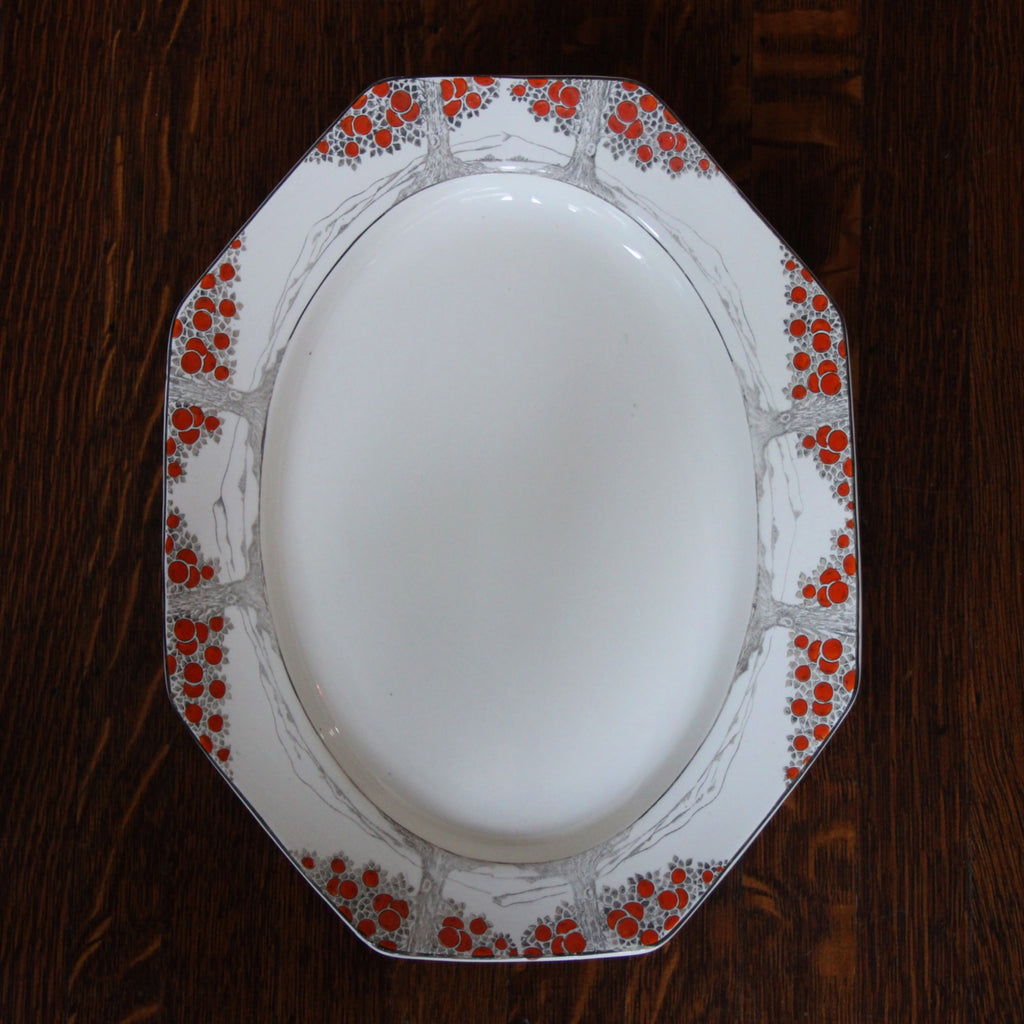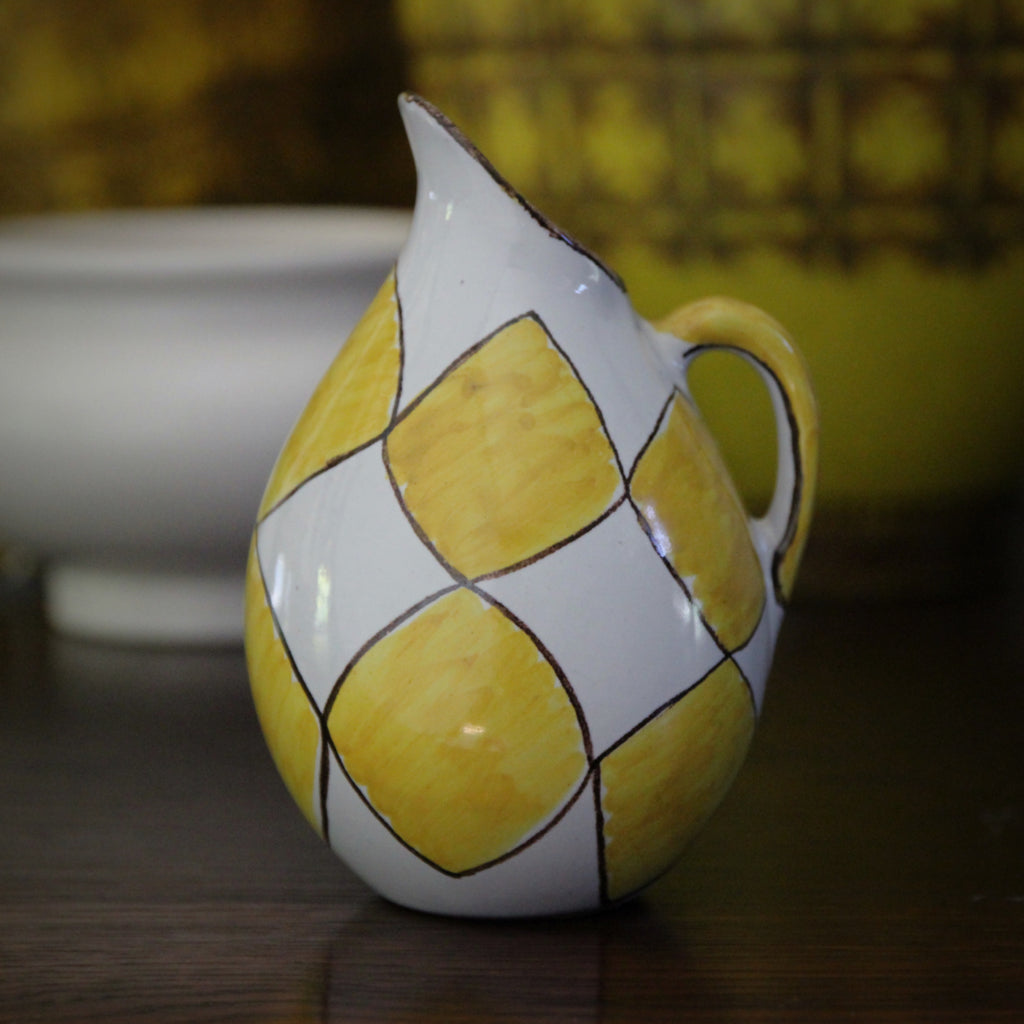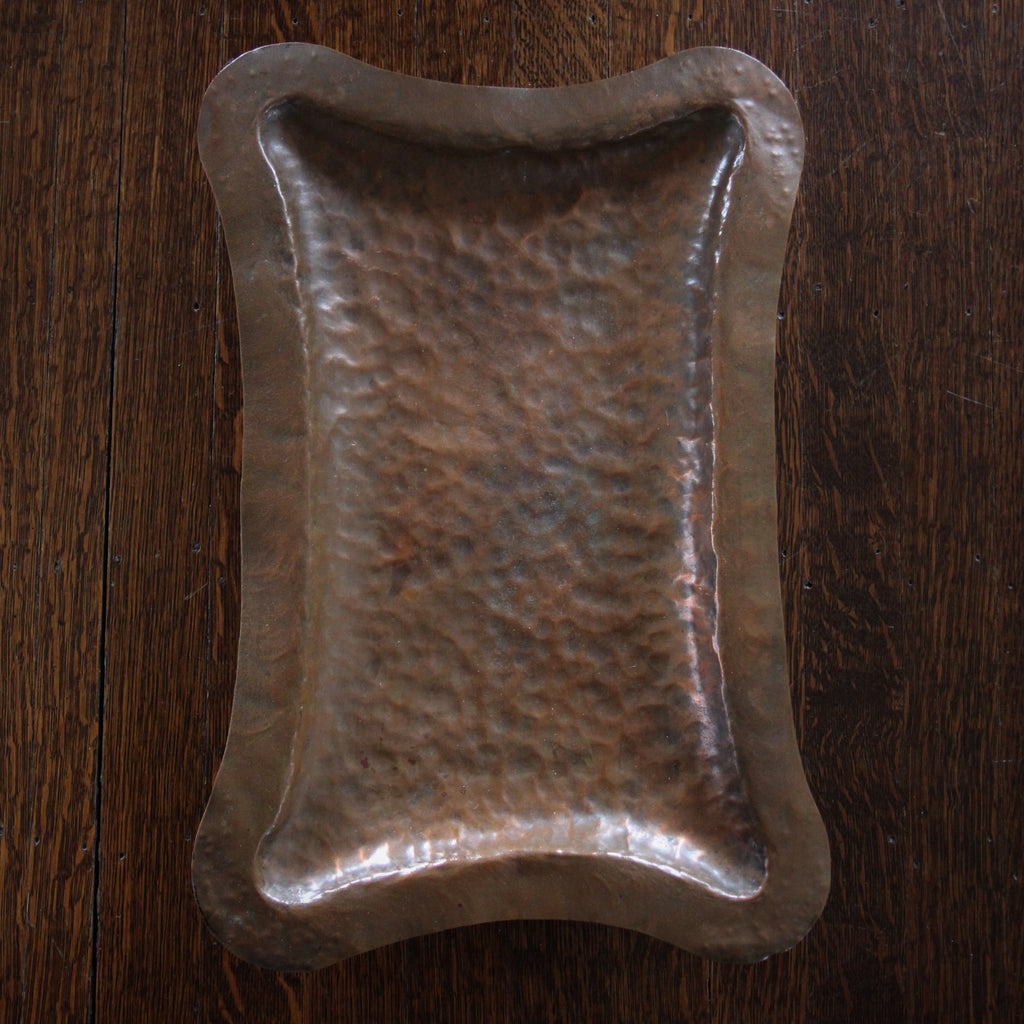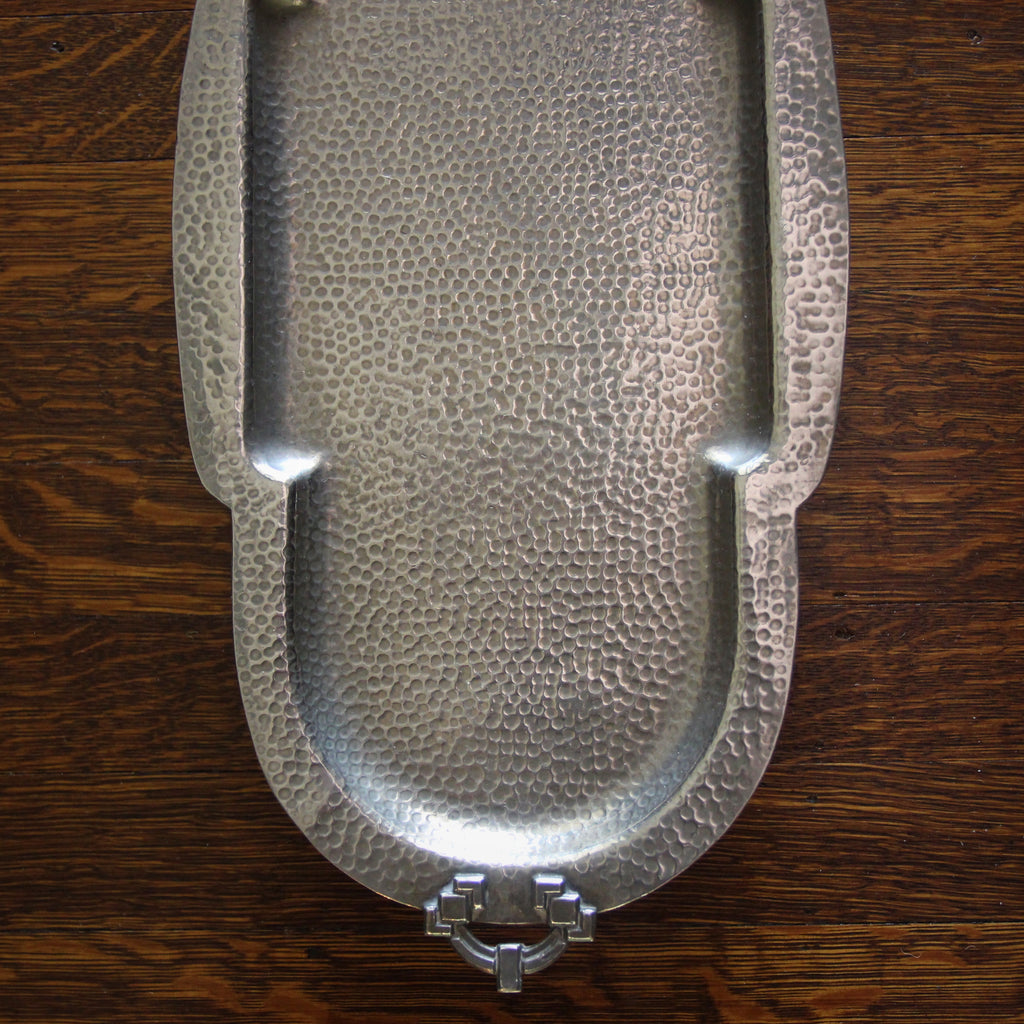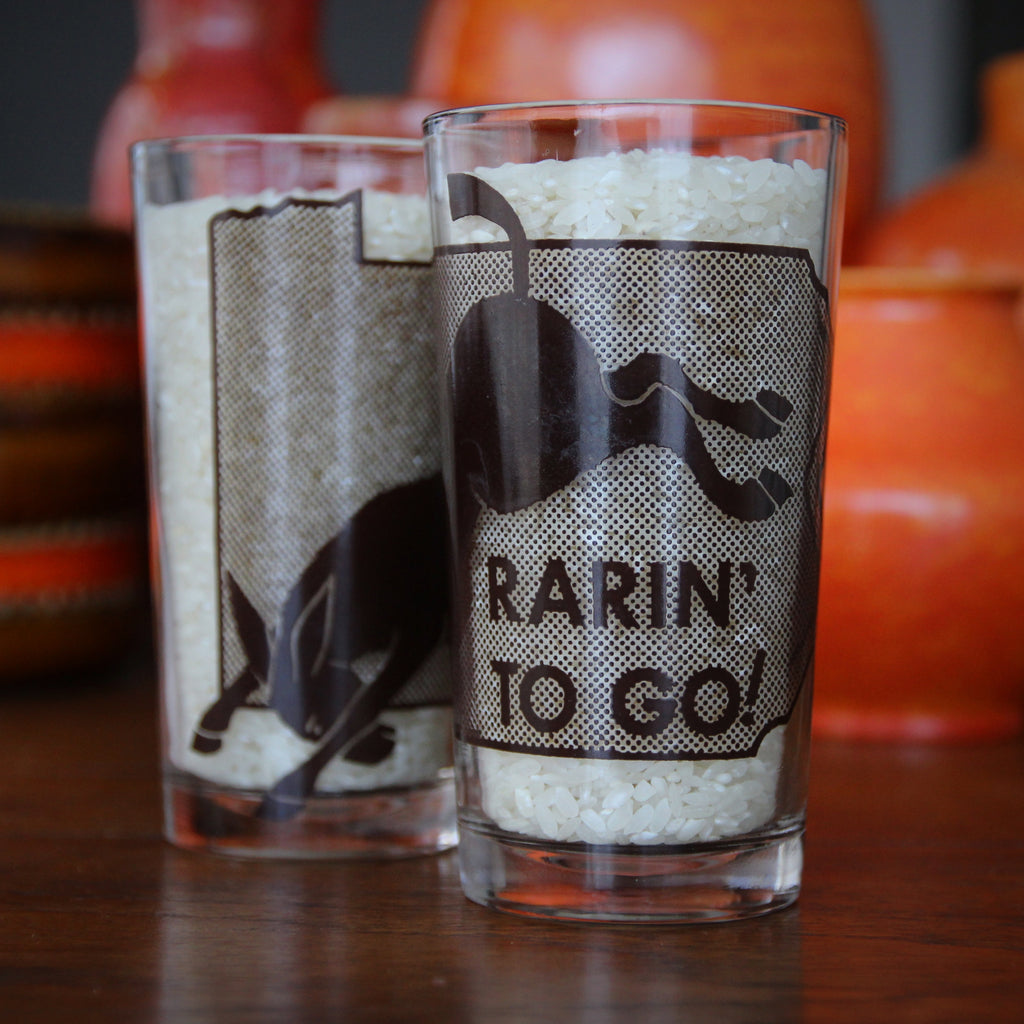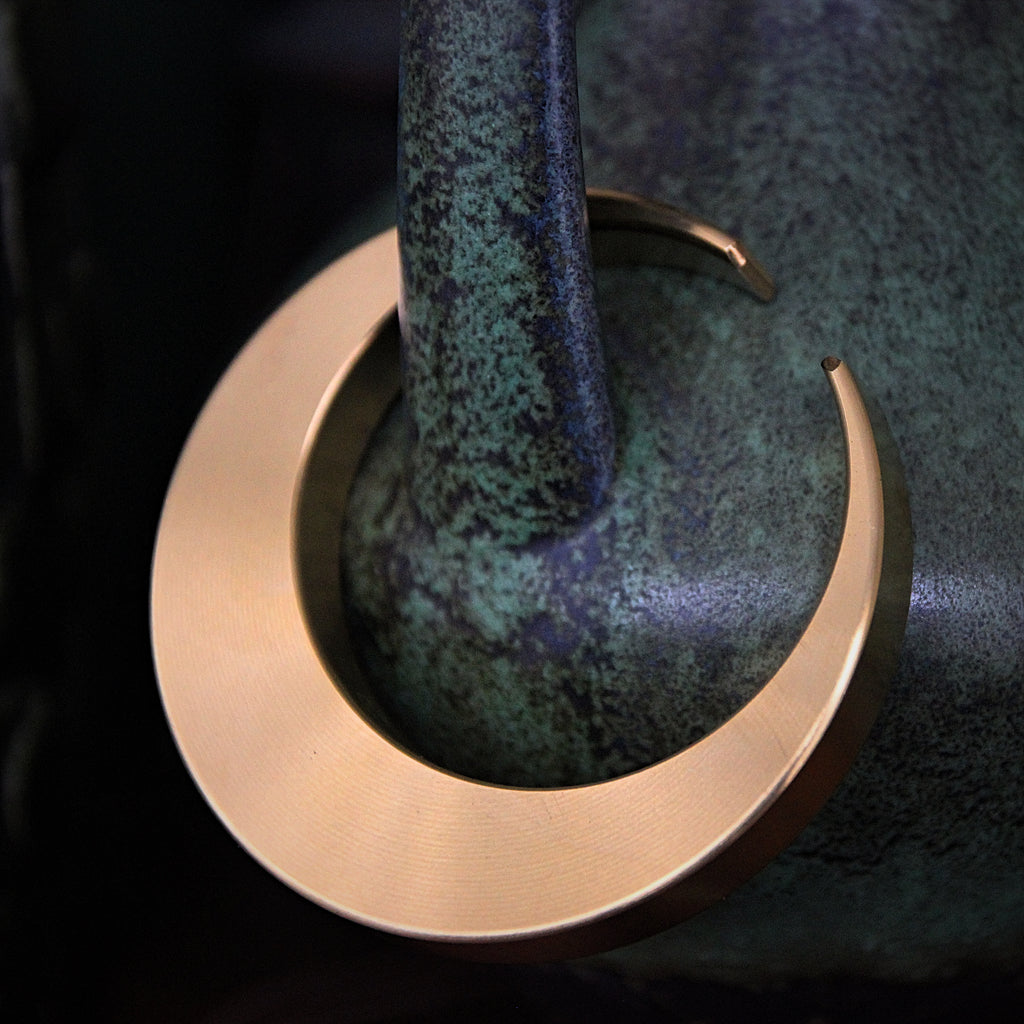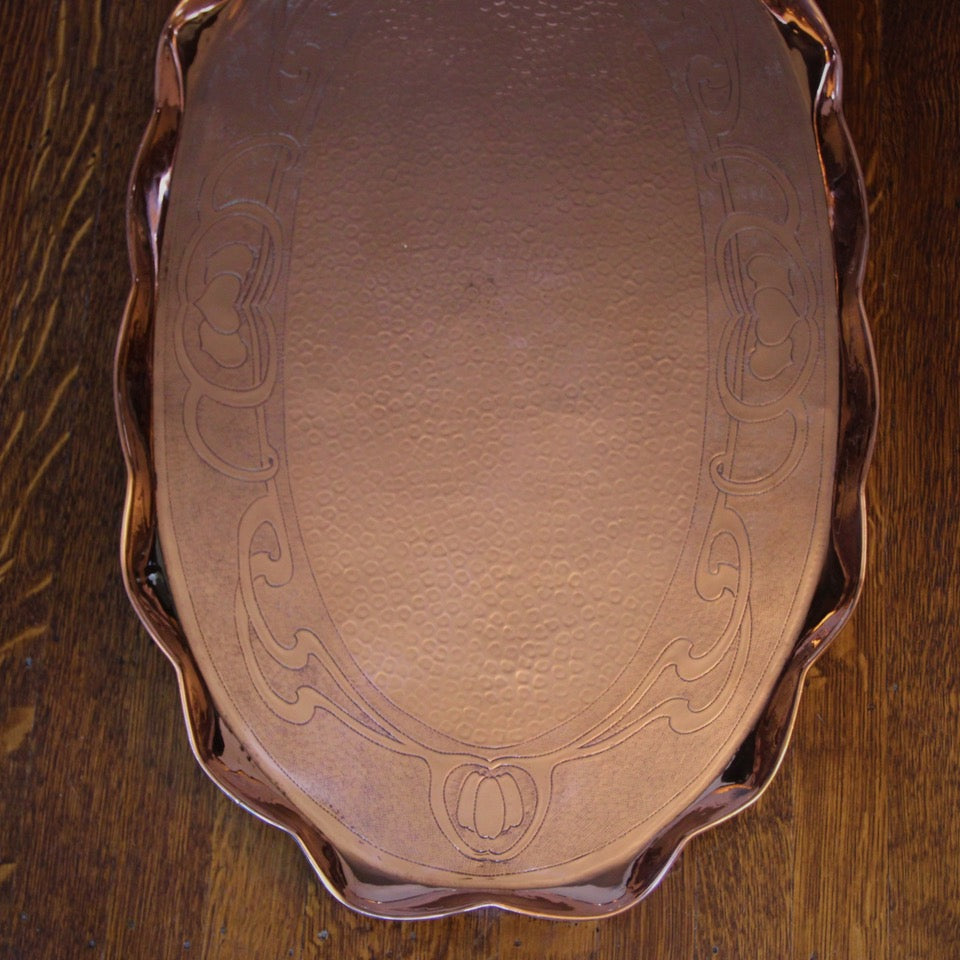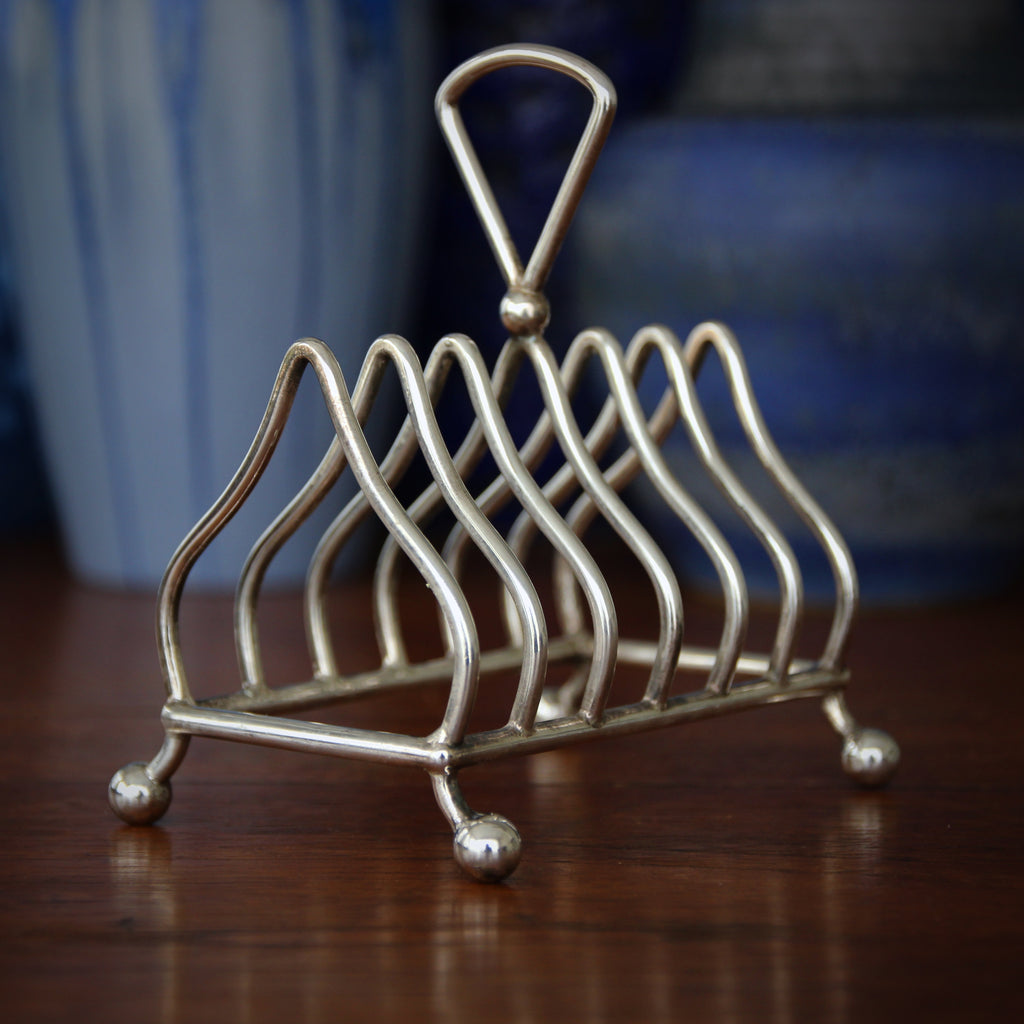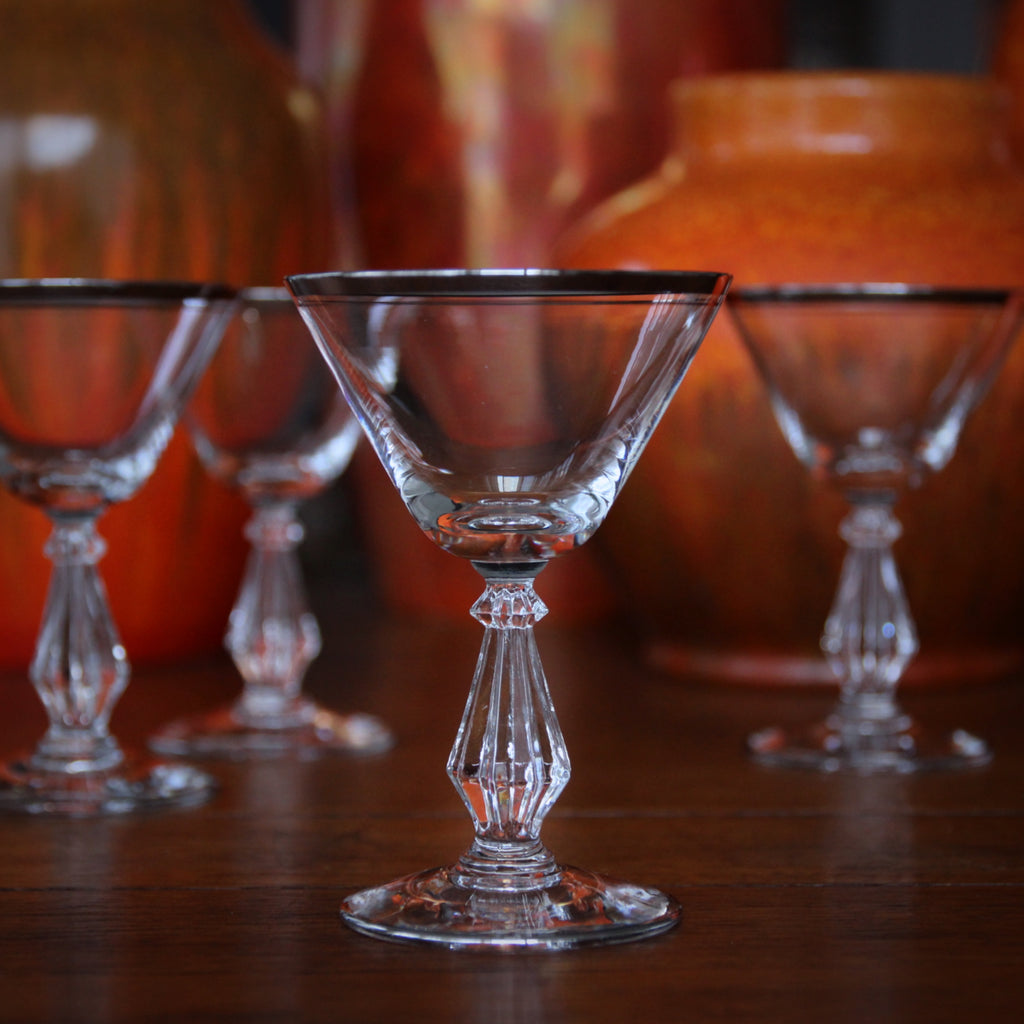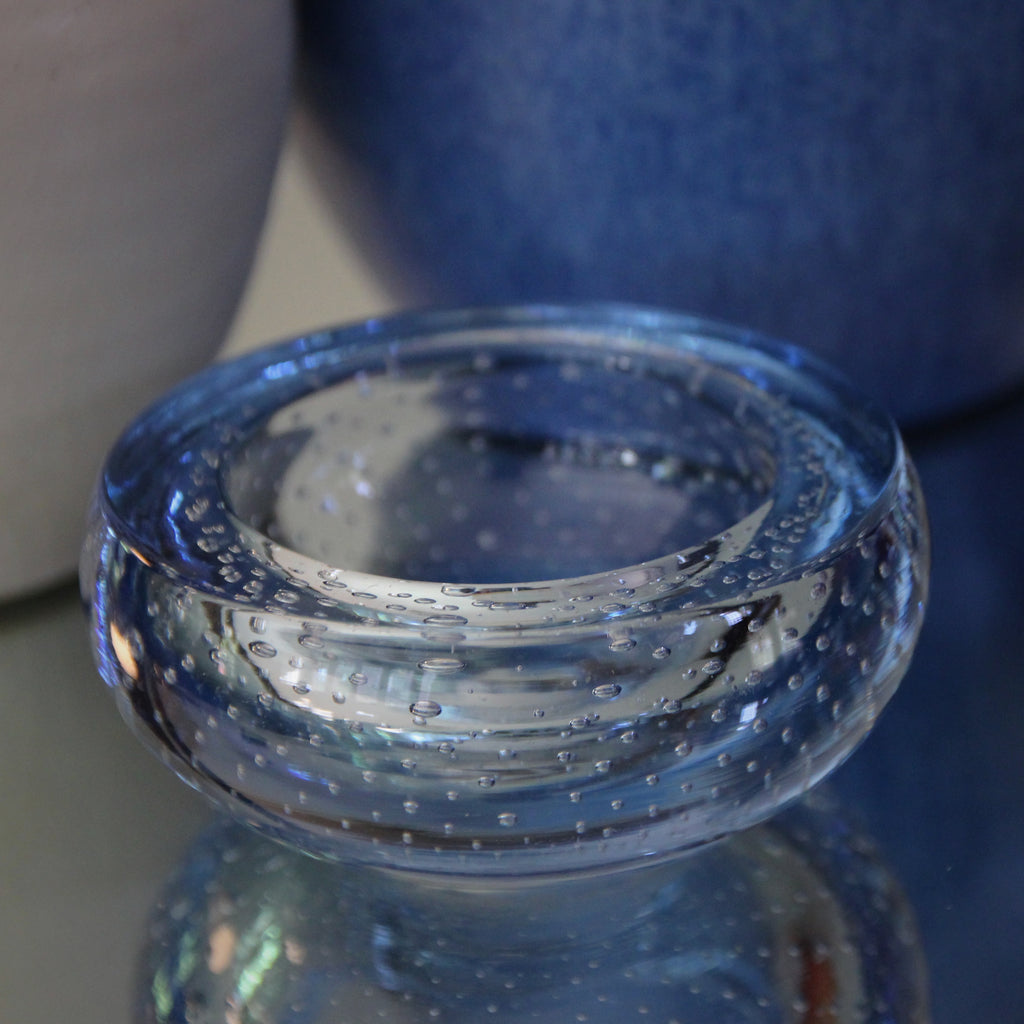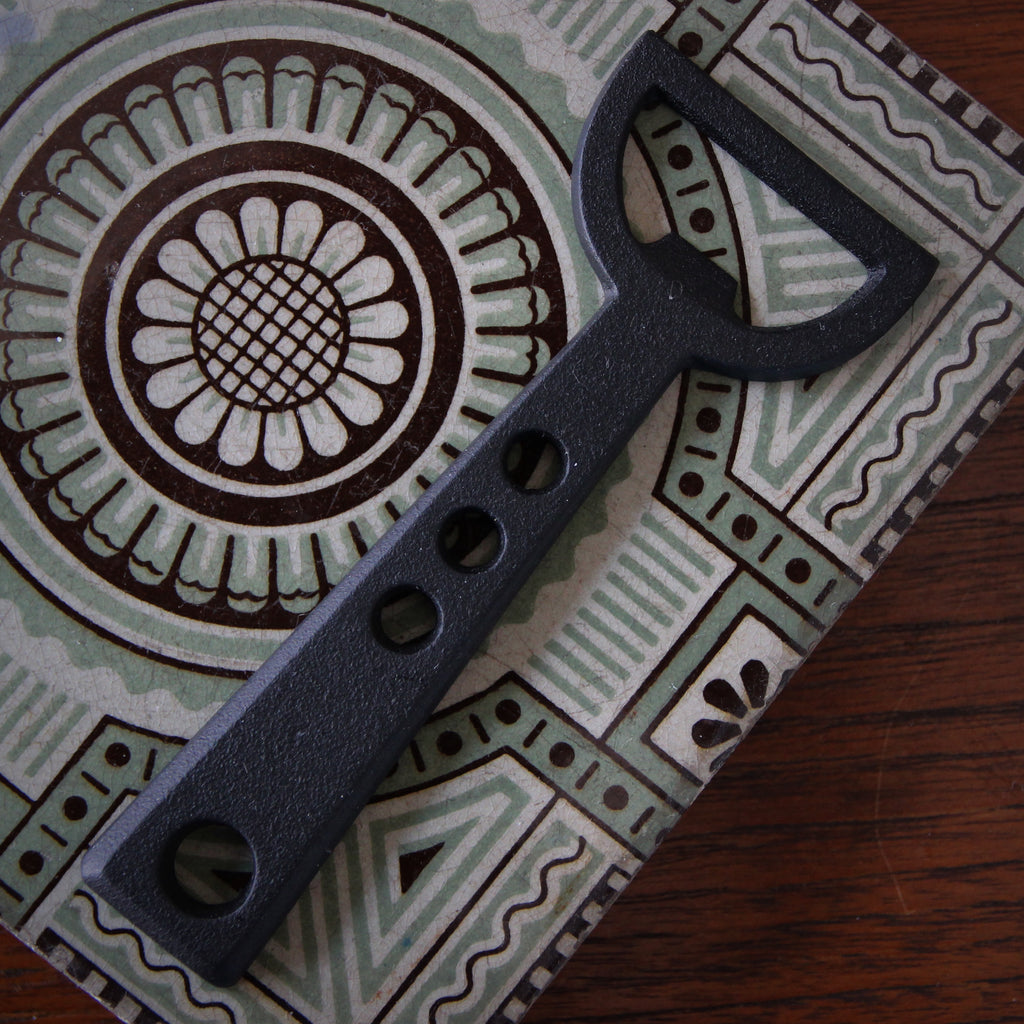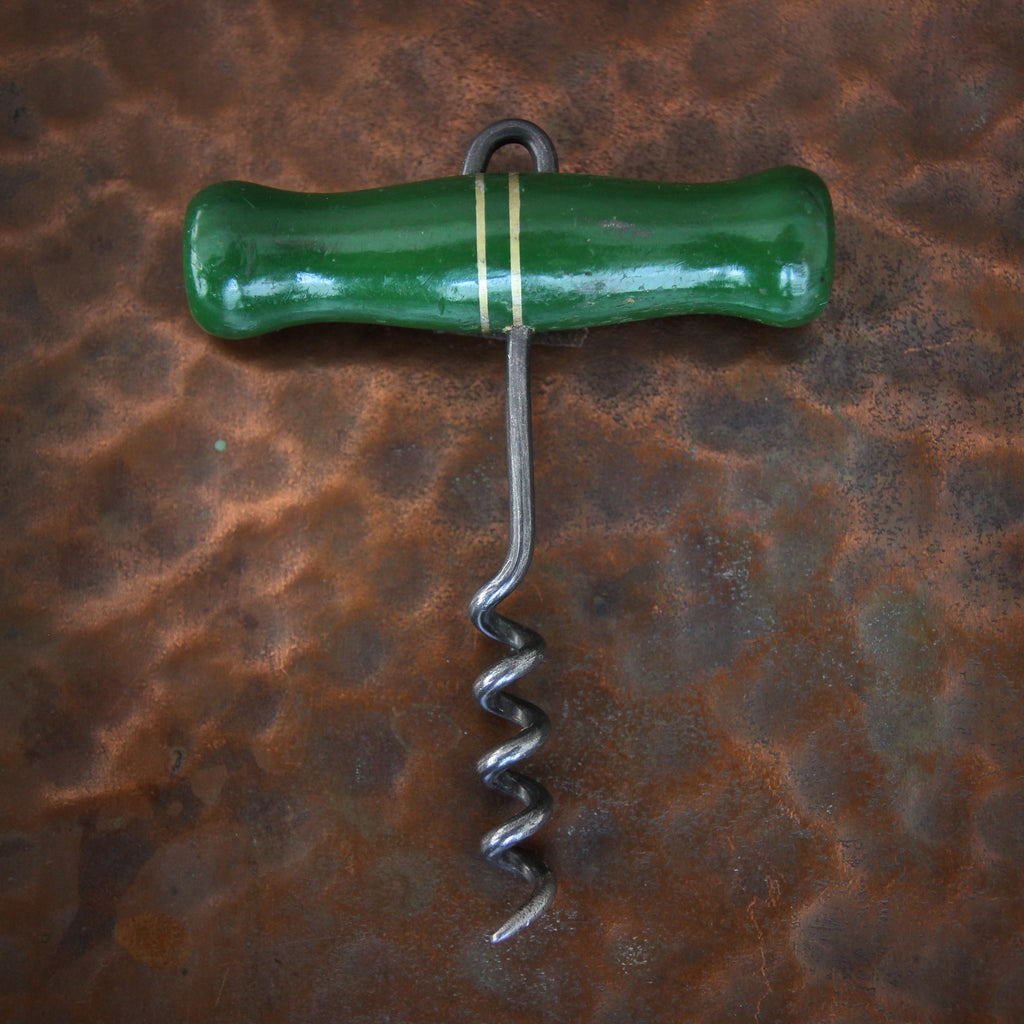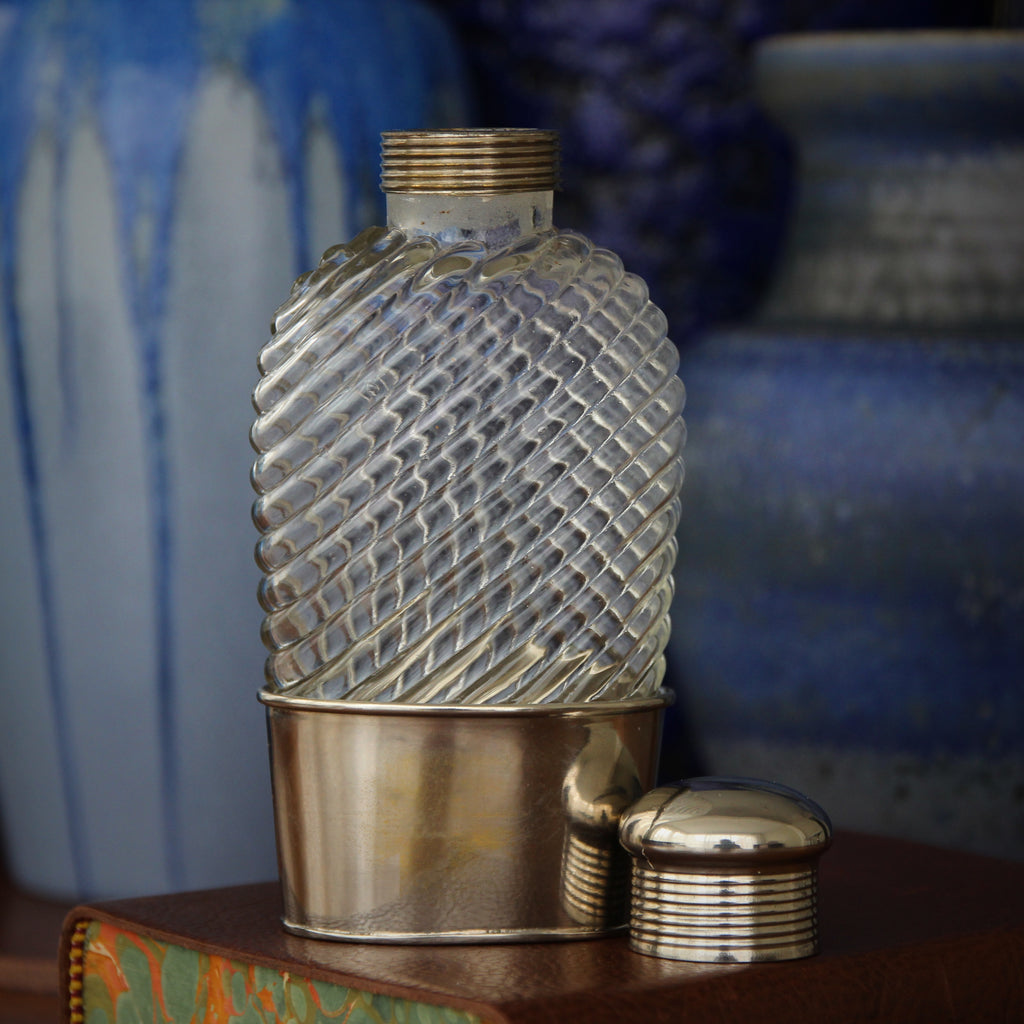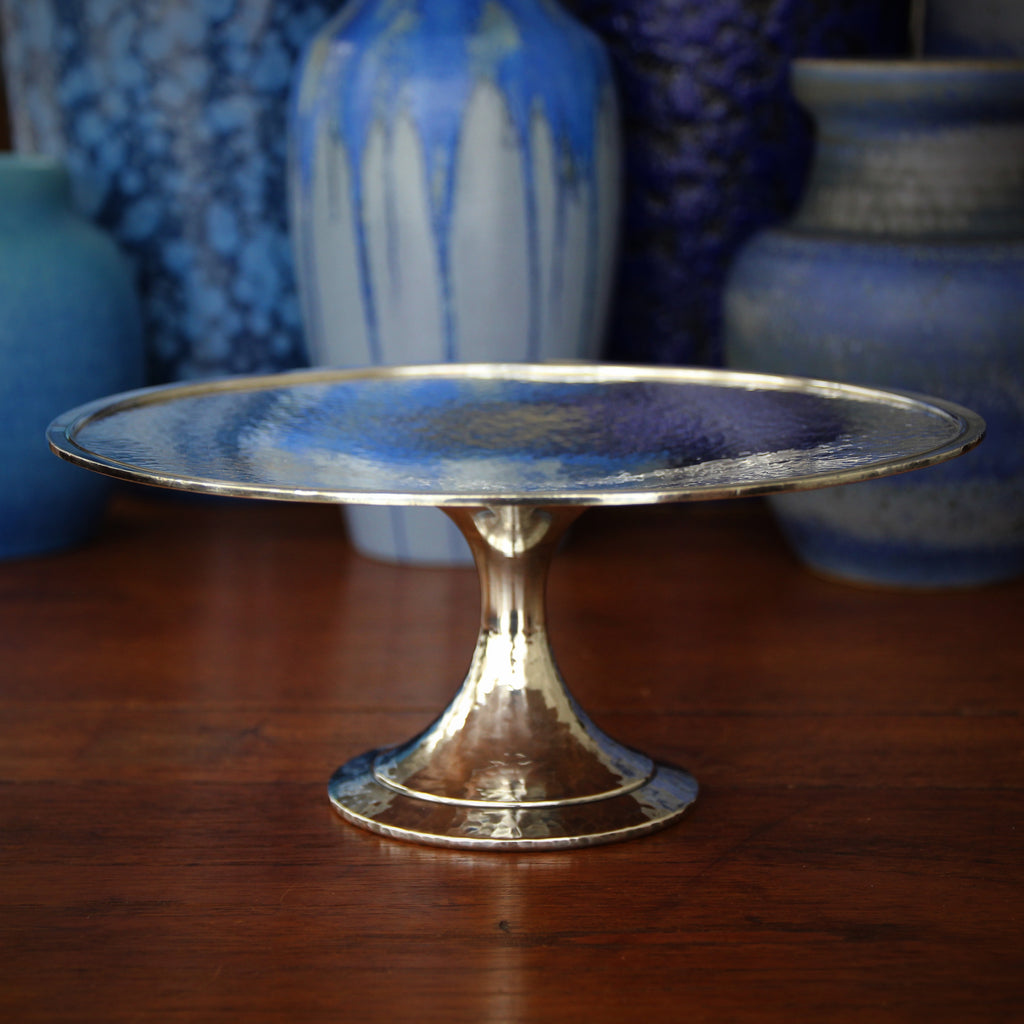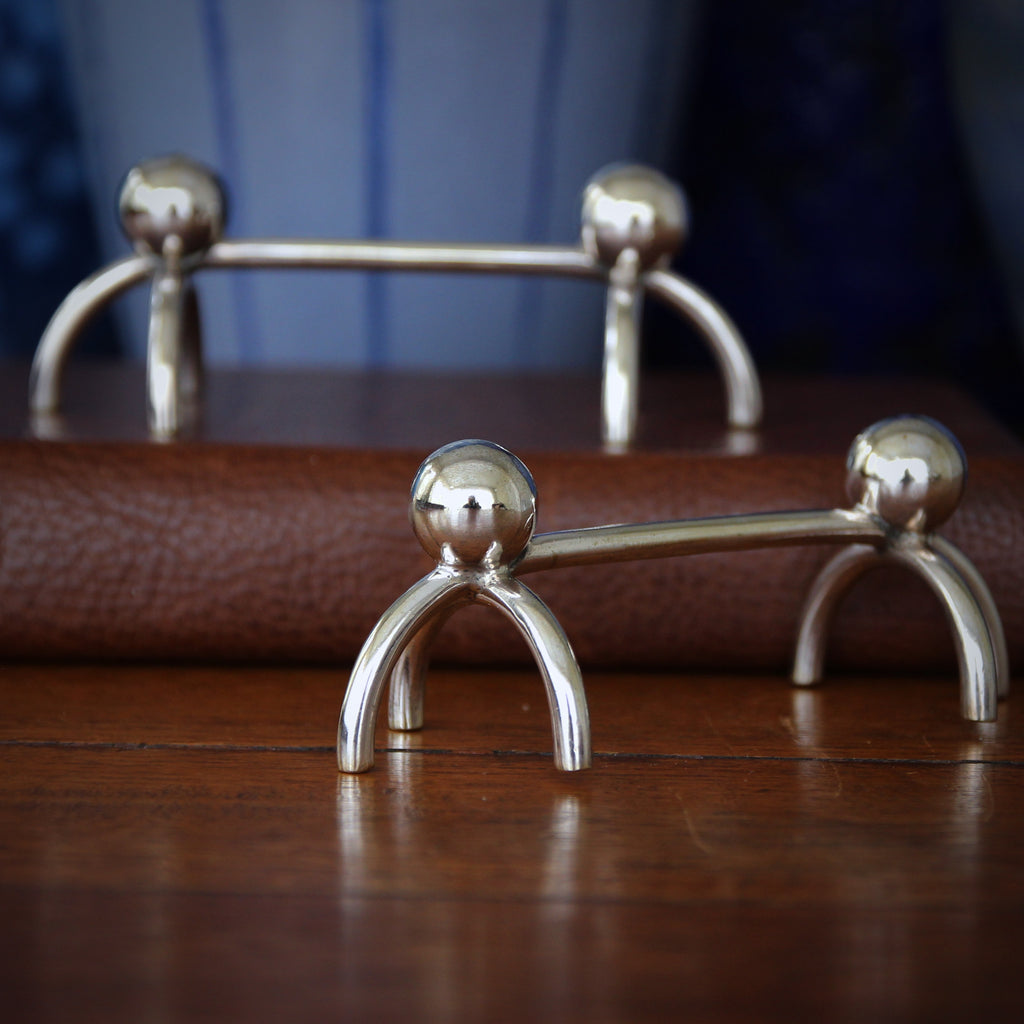JOURNAL — Glass & Serviceware RSS
One of my favorite Christmastime songs isn't a Christmas song at all. It's Ella Fitzgerald's recording of Frank Loesser's masterpiece, "What Are You Doing New Year's Eve?" Written in 1947, it originally was never intended to be a "December song," but the bittersweet melancholy lends itself so beautifully to the longing and anticipation which accompanies the ever-darkening season.
These four Mid-Century Modern Manhattan cocktail glasses could serve-up a sophisticated mixed drink or splash of Champagne as the bells toll. They are the classic 1950's cocktail glass—and finished with platinum at the rims and around the foot.
Cheers, Crisp & Clean - IV
This week we're sharing some of our glassware which embraces the crisp and clean aesthetic of the Winter season—and will help you ring-in the New Year in style!
For a few years now, "punch parties" have been en vogue. But these are not your grandmothers' gatherings! Millennial hipsters—reviving all manner of mixed drinks—have rediscovered why "spiked" punches have long been popular. This Mid-Century Modernist punchbowl, by Dorothy Thorpe, comes with ten (four ounce) "roly-poly" punch glasses. Wide platinum bands provide substantial gravitas and style—even for the most discriminating hipster. And a refreshing splash of punch—raised for the countdown—will certainly make for a uniquely stylish New Year's Eve.
Cheers, Crisp & Clean - III
This week we're sharing some of our glassware which embraces the crisp and clean aesthetic of the Winter season—and will help you ring-in the New Year in style!
This set of four fine crystal wine glasses sit atop faceted stems and are punctuated with (handsome and decorative) platinum rims. Holding four ounces each, they are a nice size for a lunchtime tipple—or a sufficient serving of a sweet or fortified wine.
Raise one to the New Year!
Cheers, Crisp & Clean - II
This week we're sharing some of our glassware which embraces the crisp and clean aesthetic of the Winter season—and will help you ring-in the New Year in style!
This set of eight Modernist Pilsner glasses are decorated with handsome platinum banding, including a platinum ring around the rim. Such a rim is decorative, yes, but it also provides a bit of attractive "metallic reinforcement" on the glass's most vulnerable surface. And, while so many people associate Champagne (and coupes) with the New Year's countdown, some people prefer a different kind of "bubbly." Dress-up your brew with this elegant, tapered glass. What could be more "New Years"?
Cheers, Crisp & Clean - I
We're counting-down the last few days of the outgoing year, while simultaneously plunging-into the first few days of the new season: Winter. We'd like to share some appropriate service ideas for your New Year's Eve festivities—glasses which embrace the frosty bite (and clean aesthetic) of the Winter season.
This set of six cocktail glasses from the 1950's sit atop a "pumpkin" stem and are finished with platinum banding around the tops of the glasses. The platinum rims provide an extra level of protection to the glass—besides punctuating it handsomely.
Countdown to the Countdown
New Year's Eve is two weeks from tonight. If you plan to raise a glass, perhaps a splash of sherry will suit your palette. These six French sherry stems, made in the 1950's, combine lovely, swirling glass bowls atop stately black glass stems and feet. Nearly sculpture, they will add a measure of crisp sophistication to your New Year's Eve countdown. And there's still time to receive them before the holiday!
Planning Ahead
Christmas is less than two weeks away. And New Year's Eve will be here in 19 days. Plan now for your Countdown Party with the help of this Italian glass ice bucket. The handsome shape—which "evolves" from a faceted, hexagonal bottom to a smooth, round top—catches the light intriguingly. It is sized "just right," not too big on that crowded bar top or bar cart. It can also be used to keep-chilled that special bottle of bubbly.
Holiday Cheer! - III
Here's a more elegant glassware offering: a classic Double Old Fashioned rocks glass, decorated with 22 karat gold swags, stars and a holly tree. Atop it all, a gold rim—which is handsome and useful: it helps protect the rim against chipping. The set of four glasses hold 12 ounces each.
Holiday Cheer! - II
Sixties swank will add a little punch to your punch. These two sets of highballs—one with six glasses, the other with eight—are decorated with a jaunty array of wreaths, bows, bells, trees and poinsettias. Not really elegant, certainly not tacky—these 10 ounce tumblers capture a certain Sixties style, full of innocence and promise and simple Holiday cheer.
Holiday Cheer! - I
The Holidays—and the Holiday guests—are on their way! Get ready now with this set of six Mid-Century highball glasses. They are festooned with swags of green pine, red bows and candles, and a 22 karat gold lantern. Perfect for egg nog or even something a bit harder.
Blue Christmas
In France, where wine is a common part of daily life, it was once customary to serve vin in a little jug like the one above—just a glass (or two) of a typical, cheap and utterly delicious table wine, often purchased from a basket on the floor of the neighborhood "Maman et Papa" grocery store. I have always admired those cultures which do not attempt to exalt wine beyond its humble status. No fuss. No pretension. No multitude of differently-shaped wine glasses (one for each specific "varietal"). Rather, I applaud those who pass the little wine jug along with a tumbler and a shrug. "What's the big deal?" This Art Nouveau wine pitcher, made in Turn-of-the-Century France, is signed Charles Gréber (1853-1935). In...
Hanukkah Cheer!
Today is the first day of Hanukkah, "The Festival of Lights." I have always loved the holiday's colors—blue, white and silver—such a clean and sophisticated palette, reminiscent of the wintry season. I also love these Modernist glasses, each one crowned with a platinum rim. Not only is the platinum embellishment crisp and handsome, but it also protects the glass rims from chipping. And, as a set of twelve, this collection will prove very helpful for the eight night celebration—or any holiday gathering you'll be hosting.
Christmas and More
These handsome (and beautifully-crafted) cocktail glasses are perfect for the Holidays—or any other month of the year. New Year's Eve, Saint Valentine's Day, Easter Sunday, Independence Day or Thanksgiving: the set of six glasses will add an extra measure of festivity to any festival. Tightly-faceted bowls add sophisticated, understated glimmer to the glasses. The rosy "plum glass" is confidently colorful without becoming treacly. And the flared lip on the glass makes imbibing even more pleasurable. White wine or red, Champagne or cocktail, these versatile vessels will bring age, style and sophistication to your next gathering.
Coasting With Class
Yesterday we shared a set of four glass and sterling coasters—heavy, ponderous, traditional. Today we share a lighter, cleaner, and (I would say) more elegant offering. The pierced sterling silver galleries provide crisp punctuation to the glass bases—which have been etched with an ultra-simple star pattern.
These Post WWII coasters have a Modernist sensibility—though their light appearance gives them a classic and timeless appearance. Click on the photo above to learn more about them.
I Am Not Your Ashtray
Post War exuberance opened the door to an explosion of gracious entertaining in the late 1940s and 1950s. "Little Luxuries," like these pressed glass coasters with sterling silver rims, provided an elegant setting for a mixed drink in a highball or stemmed Manhattan glass. This set of four coasters are marked "Sterling" and with the name of the maker, "Frank M. Whiting - North Attleboro, Massachusetts."
On many an occasion I've seen these being sold as ashtrays (which they were not) and I've even seen (recently-produced) period films and television productions using these coasters to snuff-out a butt.
Three Months To Go!
Three months 'til Christmas. (But who's counting?)
It seems like it was only just Summer, yet, before you know it, Christmas will be here! Get ready for the season with this set of four (plus one) jolly rocks glasses from the Seventies—decorated with a "stained glass" Season's Greetings" wrap. A light rim of gold helps protect the edges and provide an extra touch of subtle sparkle. Whether serving eggnog for the kids or something a little harder for the grown-ups, these Double Old Fashioned tumblers will have you hoisting with style for the Holidays.
The Waning Days of Summer - V
For the fanciest amongst us, nothing says "summer" quite like taking-out the boat for a sail around the bay. John F. Kennedy, Humphrey Bogart, even the current Duchess of Cambridge have spent many a wonderful hour on-the-water, most delightfully during the summer. For those of us without the time (or the boat), perhaps this set of four "yachting" rocks glasses will provide a modest measure of satisfaction. Four designs, in four different colorways, cruise around the wall of these double old fashioned glasses. Raise a glass while your boat sits in dry dock. Or raise a glass as you envision your ship coming-in.
The Waning Days of Summer - III
Yesterday we talked a little about golf. If one sought to find golf's opposite sport, it seems that tennis is poles apart from from that grassy, country club pursuit. Tennis is played in a tight, constricted space; explosive energy quickly "fills-up" the court. Tennis is also fast! There is no time to think—only to respond. And the brutal physical demands of a five hour tennis match—feet, legs, wrists, shoulders (all while maintaining performance)—is beyond my comprehension. These four double old fashioned "rocks" glasses, made in the 1960's or 1970's, demonstrate "The Forehand" in stop-motion illustration. The rather handsome tennis pro will bring back memories of summer matches on the clay (or grass or asphalt) long after the court has been buried in...
The Waning Days of Summer - II
For some, a late afternoon on the links is their idea of Green Heaven. I suppose such a wide open space—beautifully landscaped, devoid of crowds—can make time on a golf course a relaxing and (perhaps) contemplative experience. These four rocks glasses, from the 1960's or 1970's, demonstrate "The Basic Swing" in handsome stop-action illustration. Raise a glass—perhaps once the cold has settled-in—with three friends. Let it be Endless Summer.
Revival
For much of my childhood (and young adulthood), cocktails were relegated to the old-timers in Tiki Bars and to the printed paper menus found in neighborhood diners. More recently, Millennial Hipsters have brought-back "mixed drinks" with a vengeance—reviving the old-time potions and creating many new drinks (which they have dubbed "Craft Cocktails"). Though I do not drink alcohol, I am nevertheless excited to see proper "cocktail glasses" enjoying a well-deserved revival in usage. In the world of mixed drinks, a cocktail glass, like the one shown above, is the real workhorse of the bar. Cosmopolitans, daiquiris, margaritas, manhattans, martinis and any number of new Craft Cocktails are beautifully-served in such a cocktail glass. But, for several recent decades, cocktails had...
Somebody Stop Me
I have always loved vintage glassware and have sold many, many sets over the years. When buying glassware, in my attempt to be discriminating, I will refuse to buy any sets of fewer than six glasses. Or, let's say, I try to refuse. This fine crystal set only includes four glasses. I couldn't help myself! A smoky crystal bowl sits atop a faceted stem, making for a very handsome appearance, indeed.
The Exception Proves the Rule
We've all heard the aphorism, "The exception proves the rule." We think we know what it means. In fact, we probably do know what it means. But seldom do we take the deep dive—to wrestle with the verbiage—and determine whether the phrase makes logical sense as written. British "lexicographial genius," Henry Watson Fowler, outlines five possible approaches to understanding the phrase in his classic tome, Modern English Usage (1926). I won't trouble you with his complete analysis. But it basically boils-down to: only when there are exceptions, can we know that there exists a rule. When there are no alternative choices (that is, no possible exceptions), the remaining invariability (that is, no options) precludes the need for an established rule. Or something...
Christmas in July
Five months to go! Let it snow, let it snow, let it sNOOOOOO!!!
For those of us happy to embrace a head start, how about these: a set of four Jolly Holiday tumblers, decorated with an encircling holly-leaf wreath and embellished with bold, scrolling red ribbon. Serve adult drinks, if you wish, or use them for the kids' eggnog. They're fairly durable (for glass). And they will certainly contribute to the cheer of the season.
Something Tall and Cool
We've hit Summer's mid-point—or has it hit us? Time for a nice drink, tall and cool! This Modernist pitcher, from the 1960's or 1970's, was intended to mix cocktails with Mid-Century swank. And it still will! But don't hem it in. What about sangria? It also would serve iced tea or lemonade with élan. Smoothies would be a delight. And egg nog at the Holidays would enjoy a surge in style.
What's the Rush?
Although the Fourth of July celebration was yesterday, many people seem to be extending the holiday to the Fifth of July, also. Why not? What's the rush?
These vintage Russian napkin rings come in six bold colors, enhanced with spontaneous and flamboyant hand-painted sprays of flowers and leaves. By assigning each houseguest a differently-colored napkin ring, he or she might be able to use it for the weekend. This practice was much more common in the early Twentieth Century—when guests often visited for several days and doing laundry was a difficult and tedious procedure. Any thing one could do to reduce the laundry load—like squeezing several uses out of one laundered napkin—was much-welcomed by the household staff.
Keep Rollin' Along
Edna Ferber spent months researching the lives and stories of people who lived and worked on the showboats which once plied the rivers of the American South. She even spent a week on one of the boats, though, by this time, these floating theatres were quickly disappearing. Her 1926 novel, Showboat, was a great success and was quickly adapted into a musical by Jerome Kern and Oscar Hammerstein II (produced by Florenz Ziegfeld). Ferber was initially shocked that anyone would want to musicalize her serious novel, though she eventually consented when she realized the commitment displayed by the high-calibre production team. Clocking-in at 4.5 hours long, the show was trimmed to just over three hours when it opened on Broadway...
Iridescence
Iridescence, also called goniochromism, is a phenomenon throughout the natural world—found in animals, vegetables and minerals. Simply put, iridescence is the event in which surfaces appear to gradually change color as one's angle of viewing is changed (or the angle of light source shifts). Iridescent materials reflect light across all (or part of) the rainbow spectrum. In contrast, pearlescent color usually means the reflection of sparkling white light along with the predominant "base" color of the object. Iridescence occurs when something "interferes" with the consistent reflection of one pure color of light off the physical surface. It could be the varying thicknesses of the reflective material, an uneven (reflective) surface, or something else in the underlying structure of the surface. Consider a soap...
Wise Owl
People have always found owls mysterious. They hunt by night, fly in complete silence, and appear to study intently (and contemplate) everything that happens before them. Those big eyes seem to see everything. Thousands of years ago, the Ancient Greeks associated owls with knowledge; Athena, the Goddess of Wisdom, was often depicted with an owl who would whisper the truth to her. In later centuries, Athena's Roman counterpart, Minerva, continued to be shown with a a wise owl. The "secretiveness" of owls has sometimes earned them an association with death. An owl flying into (and out of) a room conveys the poetic symbolism of the passing of human life from Earth to the Hereafter.
Eight Months 'til Christmas!
Eight months—244 shopping days—'til Christmas! Get your table set (well in advance) with this set of eight Jolly Holiday highballs from the Fifties. Christmas Wreaths, New Year Bells and Poinsettia Blossoms take us back to an older, slower time.
Christening Cup
Baptism is an important (some would say vital) rite within the Christian Church. The ceremony, usually followed with a meal or other gathering, has become an opportunity to give a meaningful gift to the little one. In the Nineteenth and Twentieth Centuries, silver became the gift of choice as the precious metal was believed to confer healthful properties and was also a symbol of prosperity. Thus, a silver Christening gift would convey a wish for the health and success of the newborn. Since the Victorian Age, useful gifts—especially items associated with nourishment—have been popular. Silver spoons (perhaps engraved with the baptismal date) were very common (and could be used to feed the child). Cups, bowls and egg cups were other functional choices. Sometimes...
Saturday Sailing
It may still be a little too chilly to hit the bay. But you can dream of that day right now—warm and snug indoors—with this set of four yachting whiskey glasses. Each glass features a different type of ship, in a different color way, so that your guests can easily identify their glass. At ten ounces, this "single old fashioned" glass is comfortable to hold (and takes up less precious space in your on-board galley).
Lift with Style
When I was a kid, growing-up in Hawaii, the only beer labels I could name would have been Olympia ("It's the water" - Tumwater, Washington), Primo (with its blue Hawaiian warrior and a name that rhymed with "Kimo") and, of course Budweiser ("...You've Said it All!). In the 60's and 70's, at least in my circle, beer was drunk by Joe Six Pack—and nearly every father who's just come home from work. The cool brew was much-relished, sure, but I don't think quality was a top criterion. Forget about sophistication. When I got a little older, perhaps in the 80's, I noticed a couple of "more upscale" brands on the scene: the elegant Heineken (imported and dressed in a costly...
Winter Rose
Though Spring is here, there's plenty of winter left in the atmosphere. We are still having occasional 20° nights. Our rose plants are showing nice, early leaf growth—though, disappointingly, flowers are still weeks away. So, until we are blessed with a real Spring rose, this Japanese crystal rose will have to suffice.
This rose-form paperweight, crafted of hand-cut crystal in Japan, is a wonderful object to behold and a certain conversation piece.
Spring Suggestions - VII
This handsome plate ticks many boxes. First there's the hand-hammered rosy copper, always a favorite of mine. And then the plate is "damascened"—that is, bonded with delicate elements of inlaid silver, creating a delightful pattern. And that pattern, too, tips its hat to several period aesthetics. The stag amongst the foliage is a common medieval tapestry theme. The hammered copper lies at the heart of Arts & Crafts metalwork. And the silhouette of the stag is reminiscent of the works of the American Art Deco sculptor, Paul Manship.
Spring Suggestions - VI
Hand-hammered brass, softly gleaming, makes for a handy and handsome drinks tray. It was made in Germany during the Jugendstil movement. The hammered "peening" softens the reflected light and the gallery of "pillows" around the edge will keep your glasses from sliding off. It would also make a useful "kitchen tray" to corral oil bottles and spice jars.
Spring Suggestions - V
For a "Mod" take on Springtime fun, how about these double old fashioned "rocks" glasses. The set of eight "lowballs" is boldly punctuated with bands of 22 karat gold. Handsome, useful and very, very cool. Your whiskey has got to taste just a little better from these glasses! Please click on the photo above to learn more about them.
Spring Suggestions - IV
Commence your Spring Cleaning in-style—at least at your dining table. This English Arts & Crafts hand-hammered brass crumber set boasts a central botanical decoration as well as hand-riveted metal strapwork. Crumbers like this would be used to clean the dining table linens between courses.
Spring Suggestions - III
You'd be forgiven if you thought this pitcher is Italian; its hand-painted Harlequin dress looks so much like the costume of Arlechino, one of the character clowns of the Italian Commedia dell'Arte. No, it's German, made by Übelacker in the 1950's. What is clear is the pitcher's strong Springtime sensibility. Wouldn't it be nice to be greeted each morning by this sunny, friendly creamer?
Spring Suggestions - II
Warm and softly-radiant, brass often reminds me of Spring. And this German Jugendstil hand-hammered brass tray is (a bit) reminiscent of the sun. It's modestly sized—perfect for tea-for-two or drinks for six. It would also be the perfect dresser or kitchen tray—holding bottles and jars.
Spring Suggestions - I
Hurrah! We've moved-into Spring—and we'd like to share some "Spring Fresh" ideas with you, now in-stock at LEO Design. One of these items might just "do the trick" to lighten the mood and move your abode into the new season of growth.
This French Art Deco ice bucket is beautiful and useful. It is blown of citrine glass and is reminiscent of an Early Springtime daffodil trumpet. Daffodils are amongst the first of the Springtime flowers—often emerging long before their more-reserved botanical cousins.
Mardi Gras
Today is Mardi Gras—"Fat Tuesday"—the last day to celebrate before Lent begins tomorrow, Ash Wednesday. It's the day when all the household's fats, meats, sweets and other indulgences are consumed or thrown away. A big Mardi Gras celebration prepares the family for a properly abstemious Lent. While we're still having a party, how about a handsome Modernist punchbowl service. Thick bands of platinum decorate this punchbowl and ten "roly-poly" punch glasses. Click on the photo above to learn more about it. Though our Greenwich Village store is now permanently closed, LEO Design is still alive and well! Please visit our on-line store where we continue to sell Handsome Gifts (www.LEOdesignNYC.com). We also can be found in Pittsburgh's historic "Strip District" at...
On a Pedestal
A nice tray can be used to present food in its best possible light. But putting something atop a pedestal adds a whole new dimension to the exhibition. Place a cake or muffins or even cookies upon a raised plate (like this one, shown above) and you've elevated the presentation. This Arts & Crafts cake plate is made of hammered and silver-plated. It was made by Derby of Meriden, Connecticut.
The Tray of Vine and Berries
This journal entry title may not be obvious—and it is quite far from clever. (I was attempting a reference to the 1962 film "The Days of Wine and Roses" and its haunting theme song by Henry Mancini.) But! There is an association! The film, made by Blake Edwards and starring Jack Lemmon and Lee Remick, is the tale of a couple and their relationship to alcohol. This German Jugendstil tray, made by WMF in the 1910's, is decorated with a delicate repouseé of entwined vines, palmate leaves, and clusters of delicate berries. Though I have not, yet, identified the variety of berry, I have leapt to the conclusion that the Germans may have used these same fruit to make wine...
Delicate Beauty
This little English Arts & Crafts copper tray is decorated with a hand-tooled radiant botanical design. It's not very big—just over nine inches across—but it has great style. It would look perfect hanging on the wall (in that "perfect little spot") or it would serve beautifully as a dresser tray, organizing all those bottles, tubes and jars which are part of one's daily ablutions.
Juxtaposition
It was in Seventh Grade when I was taught the word "juxtaposition"—that is, the placing of two items next to each other in order to compare or contrast their features. To my eleven-year-old mind, juxtaposition seemed to be a useful concept. But I had no understanding of how much I "would juxtapose" in my future life (or that I'd be writing about it 46 years later).
When I first found this English Arts & Crafts copper plate, I focused on the large-peen hand-hammering at its center. Such "brutalist" hammering is especially good for providing highly-visible texture from a distance (for example, as seen from across a room while hanging up-high on a wall).
More Remembrance
Yesterday we talked about the poppy as a symbol of remembrance, specifically of those who gave their lives in war for Britain. This English Arts & Crafts copper plate shows a trio of poppy pods—yet to be opened. Additionally, it shows a trio of wild geese, flying around the rim of the plate. For Celtic Christians, the wild goose is a symbol of the Holy Spirit, much as the dove is for the broader church. And don't underestimate the intentionality of "threes" (either geese or poppies). A trio, in Christian symbolism, is a reference to the Trinity. This handsome plate conveys a symbolic meaning—hidden within its the skillful repoussé work of its maker.
Remembrance
This English Arts & Crafts copper "pie plate" is decorated with a repoussé whiplash and poppy design. In England, poppies memorialize the war dead and (today) especially those who gave their lives in World War One. Red poppies stain the open fields of France's Western Front—where British (and other) servicemen died (and some were buried). Additionally, the narcotic effect of opium (from poppies) has always connoted sleep, thus the close association with eternal rest. This copper plate is beautiful in its own right—and made even more special by the remembrance it engenders.
Shocking!
For most of human history, the world was dominated by a small number of monarchs, the aristocratic one percent, and all the rest of us—the 99% who served those monarchs and aristocrats. "Luxury" was out-of-reach for all but the tippy-top. And then came the Industrial Revolution. While the Industrial Revolution did create many problems—pollution, exploitation, and the relegation of human labor as an interchangeable commodity—it also allowed for the growth of a modern Middle Class. And this new middle class had something heretofore unknown to them: discretionary income. For the first time, a growing middle class could afford to buy things that they wanted, not just what they needed. But they were still not rich enough to match the...
Rustic Character
Yesterday, we shared one of the finest trays in our collection. If one might call that one "Beauty," the shallow bowl, shown above, might be called "The Beast." But a beast is not without its usefulness—or its charm. Rustically hand-hammered copper is fashioned into a shallow bowl. Set upon a refectory table, it would be perfect for holding fruit, bread or a collection of decorative objects—pinecones, wine corks, seashells or glass balls.
The Fairest of Them All?
After 26 years of collecting and selling English trays, this one may be the nicest I've ever owned. And, although it could be used to serve food, it would be much better suited to hanging upon the wall as a work of art. Actually, it could serve as an architectural feature! Four whorls of scrolling botanicals luxuriate in each corner of the tray which is surrounded by a crimped-edge gallery. And the soft, warm reflection of light off the brass surface will gently brighten any spot in your home. (Why am I selling this?)
A Copper Beauty
This sweet (though small) little plate would bring a lovely touch of Arts & Crafts sophistication to that tiny spot in your home which has been wanting for a small point of punctuation. It was made in England around 1905. The hammering is beautifully executed, the design is crisp, and the deep, brown patination is rich and lovely. Especially unique is the trio of piercings which encircle the plate. A stylized, six-petal flower radiates from the center.
From the Ends of the Earth
In the old days, China was considered "at the far end of the Earth." Venetian explorer-merchant, Marco Polo, was the first European to make a well-documented trip to China in the late 1200's (though scholars believe that the Chinese had periodic contact with Europe for centuries before this). It was not an easy trip; it took him three years to travel from Venice to China and he stayed there for 17 years. In later centuries, the West enjoyed increasingly easier travel to China, though politics did affect the ease of trade from time to time (as it continues to do today). Intrepid European traders made vast fortunes bringing-back luxurious and exotic products from China—textiles, ceramics, tea and other foodstuffs that...
Tea with Miss Marple
Victorian England was absolutely encrusted in ceramic tiling. Pubs, kitchens, churches, shops and train stations: nearly every new British building in the second half of the Nineteenth Century could find multiple uses for lots and lots of glazed ceramic tile. And although British tilework was hardly novel in the 1850's, the Industrial Age was new—and modern, high-volume production methods allowed British factories to turn-out enormous quantities of beautiful, heavy, high-quality tile (and other glazed ceramic or terra-cotta architectural components).
From The City of a Thousand Minarets
Bearing a more traditional Middle Eastern aesthetic, this Egyptian brass platter displays intricate layers of hand-tooling. It can be used as a tray or hung as an art piece on the wall—where it will provide a gleam of warm reflected light
Nothing Fresher
Hand-painted trees, heavy with ripe oranges, surround the octagonal perimeter of this English Art Deco platter by Norman Keates for Crown Ducal. At the time this platter was made, circa 1925, oranges were still a small luxury in middle class England—thus the decorative embellishment might have promoted a touch of wistful aspiration. Oranges were first cultivated in China; Medieval traders and explorers brought them back to the West where they were grown in temperate (Mediterranean) locales. At the time, however, only the richest of aristocrats could afford to purchase the expensive, imported fruit. In the late Nineteenth Century, when Christmas gift-giving became customary, an orange might be left in the toe of a child's Christmas stocking (and, at this point, oranges...
More From The Middle East
Here's another Middle Eastern beauty, this time in hand-tooled copper. A crenelated gallery surrounds the interior graphic elements: triangular "teeth," scrolling botanicals, and a corollate center. The bold simplicity of the design—almost "folk art" in aesthetic—brings this tray closer to the sensibility of traditional Arts & Crafts than most Middle Eastern works. Still, the competence of the metalsmith is apparent. This tray, hanging in an Arts & Crafts interior, would provide wonderfully warm punctuation.
Middle Eastern Brass
Here's another handsome piece of metalwork: a Middle Eastern hand-tooled brass tray. It serves wonderfully as a tray. I like it even more when hanging on the wall—where it provides a warm glow of reflected light and beautiful punctuation in an Arts & Crafts interior. It's interesting to point-out that period Aesthetic Movement and Arts & Crafts designers or craftsmen would sometimes imitate "exotic" aesthetics and decorative elements into their work. This was their way of bringing the beauty of another culture to those who might not have the opportunity or wherewithal to travel so far away. And the wealthiest collectors competed with one another to have more and better Asian ceramics, Persian tilework or Middle Eastern metalcrafts. Some of these...
Beauty is Universal
I love hammered metalwork—an appreciation which transcends place and period. Though, in fact, most of my collecting has been in the West: Europe, Britain and the United States. Thus, my ability to identify these places and periods is (a little bit) better developed. So, over the years, I have focused principally on acquiring Western metal crafts for my shop. (As a merchant, I must balance the issues of physical space and cash-on-hand.)
German Brass
This simple tray was made by the Württembergische Metallwarenfabrik, more commonly known as WMF. It was founded in Geislingen, Germany in 1853. The company was well up-and-running (40 years old) by the time the German Jugendstil Movement was born—and WMF was well-positioned to take advantage of the trend. In fact, WMF enjoyed its heyday during the Late Nineteenth and Early Twentieth Centuries. It is possible that this tray once held a glass dish or "liner" of some sort. It holds a 12 inch plate nicely. Without a plate, it is just right as a drinks tray and would make a smart dresser or kitchen tray, too.
A Late Age Career Change
Cornish office clerk, Charles Thomas Eustace, returned to work after a long illness to discover that his position had been given to another person. The 59 year old father of 13 children needed to do something—and quick! He and his brother, John, opened a small copper crafts workshop in Hayle, Cornwall, their hometown. Although he knew nothing of metalsmithing, he learned the craft quickly, becaming quite proficient. Eustace admired the Keswick School of Industrial Arts and drew inspiration from their Arts & Crafts designs, despite the fact that it was now the 1930’s and the Arts & Crafts movement had pretty much ended with World War One. Fortunately, Cornwall had a community of small copper crafters which probably helped Eustace get his...
Wine is Served
During these chilly Winter days, we are featuring a selection of trays now in-stock at LEO Design. We look-forward to the time (the sooner, the better) when we can use these trays to serve family, friends and other loved ones. The company which would evolve into Joseph Sankey and Sons was established in 1854, making simple tin trays. In the late Nineteenth Century, Sankey was joined by his brothers, by which time the company had developed a broader line of products, many of them intended for an elegant upper middle class market. With the advent of the English Arts & Crafts (Art Nouveau) movement, Sankey produced a large number of sophisticated household service pieces: trays, tankards, kettles and planters. These were made in brass, copper...
More Transition
With the sweet smell of Transition still perfuming the air, we share this English hand-hammered pewter tray, made in the 1920's or 1930's. The Gothic elongate-quatrefoil silhouette and the textured peening of the metal places this tray within the English Arts & Crafts sensibility. The handles, however, provide a whisper of Art Deco style—which moves this handsome tray into the "transitional" period between the two Early Twentieth Century movements.
What Are You Doing New Year's Eve?
Let's end 2020 on the right note: clean, handsome, well-designed. And (why not?) appropriately festive. This set of six cocktail glasses, made in the 1940's or 1950's, tick all the right boxes. Their platinum banding gives a handsome punctuation to an otherwise down-to-earth silhouette. And, most of all, they're clean. Let's start the new year fresh, clear and unblemished. Click on the photo above to learn more about them.
That Golden Hour
There's a certain time of the day—best described as "just before sunset"—when the sun is low on the horizon and the light couldn't be better. The sun throws off a warm, rosy, almost-liquid glow; everything looks at its best. That's my favorite time of day.
These glasses, made in the Twenties, are beautiful just as they are: softly-faceted, tulip-form bowls sit atop long and elegant stems. The crowning touch is an iridescent, golden wash. The set of six is perfect for cocktails or champagne. Click on the photo above to learn more about them.
I'll Take Manhattan
Though the Manhattan cocktail was invented in the 1870's (in NYC's Manhattan Club, for Winston Churchill's mother), they are much-associated with the post-war Fifties—a time when small, mixed drinks of many kinds were served in glasses like these. These four crystal glasses have sparking, ridged stems. And the glass rims (and feet) are ringed with platinum—which gives them a crisp finish and actually protects the glass edges from chipping. Perhaps you'll want to make this New Year's Eve an old-fashioned celebration. If so, please click on the photo above to learn more about them.
Golfing? Now?
Unless you live in the Southern Hemisphere—and you've already finished all your work—you shouldn't be golfing right now! But you certainly may dream of springtime and a happy return to the links! And these Double Old Fashioned rocks glasses from the Sixties will help keep you in the mood. A stop-action golfer illustrates "The Basic Swing" to keep your form in tip top shape. And the refreshing green and white graphics will tantalize you with thoughts of warmer weather. But make sure you finish your work first!
Not Quite New Year's
While it's not-quite-New-Year's, is it too early to start planning for "The Big Flip"? I, for one, will be thrilled to see 2020 (and all its tragedy) through the rear view mirror! And what better way to welcome January First than to have a (very small) celebration on New Year's Eve? These handsome crystal coupes, made in the earliest years of the Twentieth Century, were mouth-blown by the talented artisans at Bryce Glass in Western Pennsylvania. The bowls are softly-faceted, giving them a classy touch of sparkle. The stems have been cut into tapering obelisks—ending in a bright, ruby glass foot. One can appreciate the handmade quality of these coupes by comparing the different glasses to one another: each has...
Bottoms Up!
The word "Stein" derives from the German word Steinkrug meaning "stoneware jug" (stein = stone and krug = jug). Despite the name, German steins have been made of many different materials over the years: wood, ceramic (stoneware), glass (crystal), or metal. And, while they originated as simple, uncovered drinking vessels, today we think of the classic stein as being highly-decorated and covered (usually with a metal lid). That lid became popular in the 1300's—during the Plague—in order to keep fleas and flies (believed to transmit the bubonic bacteria) out of one's beer.
Two Weeks to Go!
Although our Holiday gatherings will be smaller this year, need they be less jolly? This set of eight rocks glasses, made in the Seventies, will bring a seasonal flair to your gathering—no matter how small. Whether used for milk (and cookies), eggnog, or something a bit stronger, the bold red and green "stained glass" lettering will remind you exactly which season you're celebrating.
Three Weeks To Go
With Christmas but three weeks away, perhaps a little "hostess gift" would help make your season bright. This set of six highball tumblers are decorated with a handsomely illustrated Victorian Christmas tree. A gold band rims the top of each glass—which is not purely decorative, it also helps to protect the glass from chipping. Click on the photo above to learn more about them.
Win'try Crystal
When I buy a set of vintage glasses, I always aim for a group of at least six (and preferably eight). But, every now and then, I find a set of four glasses which is so nice—of such good quality—that I cannot bear to pass-them-by. So here we are: behold a set of four crystal wineglasses with hand-cut radiant notching and faceted balustrade stems. The "ring" is beautiful—and the crisp quality of the leaded glass is beyond dispute. So, for those people of good taste who live in small homes, here's something you may like. Click on the photo to learn more about them. Though our Greenwich Village store is now permanently closed, LEO Design is still alive and well!...
A Peach of a Bowl
Occasionally, I'll uncover something which I have never seen before. I will know nothing about its age, maker, or place of origin. I'll have no intellectual reference by which to value it. But I will recognize something of quality—and a little voice which says, "Don't put this back." This bowl is just such an item. I found it at a house auction in nearby Ohio. It is clearly Modernist in design. The weight of the crystal and the quality of the hand-cutting are superb. And the peach colored crystal is sublime. Is it something from the Modernist Period? Or is it something made—indeed, well made—recently (or even today)? I'm not a glass expert, nevertheless, I acquired the piece. Whether it's recent or vintage,...
Patient Update: Pulse Located, Still Kickin'
After an exhausting 15 hours at my polling place yesterday—as a poll worker—I was looking-forward to a nice dinner at home and a decisive outcome to the election. I got a nice dinner. There was no immediate "knockout blow"—to either candidate. As of Wednesday, the two candidates remain locked in a tight national race (which should have been expected). With the game now in the Third Quarter, no side knows the final score. The game needs to be played-out—which means every ballot marked (on or before election day) needs to be counted. To allow otherwise is to ignore (or suppress) The People's Voice. As for Pennsylvania, my new and recent home, I'm the first to admit that it's a crazy quilt of...
Bravo, Rafa!
Congratulations to Spanish tennis paragon, Rafael Nadal, who won his thirteenth French Open championship yesterday afternoon in Paris. "Rafa," who was ranked Number Two in the world, beat the Number One ranked player, Novak Djokavic of Serbia. Although the two players were well matched for a competitive encounter, Nadal beat Djokavic quickly in three out of three sets (making for an early evening). I was expecting a four or five hour game! It seemed that Djokavic wasn't sufficiently pumped-up for the match. Just weeks earlier, he had been disqualified from the US Open (in New York) after he carelessly swatted a ball into the neck of a crouching line judge. It's been a tough year for the Number One player—though...
Under the Knife - Part III
At many times during history—including during the late Nineteenth Century—Europeans found themselves enchanted by Asian culture and design. Though travel and trade was open with the East (to varying degrees), Asia remained very expensive, out-of-reach for the vast majority of Europeans. Only sailors and the wealthiest of Western civilians might be able to journey to "The Orient," the latter only once or twice in a lifetime. Impressive collections of Chinese and Japanese objets were the pride of many a Nineteenth Century industrialist. As Victorian industrialism flourished, it allowed for the mass production of quality consumer goods (now, for the first time, affordable by a growing middle class). Asian design was popular (and fashionable) and those aesthetics sometimes found themselves adapted and worked-in to western...
Under the Knife - Part II
Knife rests probably were invented for use by Sixteenth Century aristocracy and likely started as simple pieces of wood—used to elevate a dirty knife (and maybe a fork) off of the table. Ceramic knife rests followed (not unlike chopstick rests, which may have been invented even earlier than knife rests). Come the Victorian Era—the "Golden Age of Knife Rests"—designers ran wild with unusual designs and numerous materials (some of them precious). This set of knife rests—an impressive brigade of twelve!—was made in France during the Art Deco Twenties. They were crafted in the workshop of Saglier Frères et Cie which had been founded in the Nineteenth Century by the Parisian goldsmith, Victor Saglier. He is well known for his Art Nouveau metalworks—serving items, bowls, candelabras—and he sometimes applied...
Under the Knife - Part I
Once upon a time, "Monday was Washday"—which made Mondays the most difficult day of the week (especially for the servants). Before automated washing machines, laundry had to be soaked (sometimes overnight), soaped, agitated (perhaps with a laundry board), boiled, rinsed, wrung-out, dried, starched and ironed. And, don't forget (depending on how far back you look), the water might have to be gathered, a fire built and the water heated. To keep table linens clean (thus, extending their usage between washes), knife rests were invented to be used at each place setting—upon which a dinner guest may rest his dirty knife at an incline (thus protecting the linen from soiling). The humble knife rest, thus, became a "blank canvas" for designers and metalworkers who...
RARIN' To Go!
Two months from today! The American History Book will be laid-open and we'll be asked to decide: do we turn the page or keep writing with the same (lousy) pen. This set of four novelty tumblers—made in the 1950's—captures a Democrat in mid-kick. He's Rarin' to Go! Are you? Click on the photo above to learn more about them.
Last of the Summer's Sun
It's still summer, yes, but let us enjoy the warming sun while it lasts—for it soon will be pulling away from us, "heading south" for the winter. This Arts & Crafts copper plate was made in England around the turn of the Twentieth Century. Its swirling, stylized botanical design is reminiscent of a glowing sun. Perhaps it will hang over your kitchen or dining room—sharing its warm glow with those below. Click on the photo above to learn more about it.
A Golden Spring - Part V
Though the winter sun never goes away completely, come Spring, we relish its increasing proximity. Things warm up. To me, a beautiful Spring day is the best the weather will ever be. This hand-tooled brass tray was made in Egypt in the 1920's. In its way, it resembles a warm (but gentle) sun—whether it's presiding from the wall of a living room or sitting regally atop a dining table. Click on the photo above to learn more about it. Though our Greenwich Village store is now permanently closed, LEO Design is still alive and well! Please visit our on-line store where we continue to sell Handsome Gifts (www.LEOdesignNYC.com). We also can be found in Pittsburgh's historic "Strip District" at Mahla & Co....
A Golden Spring - Part IV
We continue our "Golden Spring" presentation with this handsome French Art Deco "Citrine Glass" ice bucket, made in the 1930's. Its pale sunny—and sophisticated—coloration certainly reminds one of early Spring. And its shape might suggest (stay wth me!) the softly-folded "cup" of a Spring daffodil. Click on the photo to learn more about it.
Though our Greenwich Village store is now permanently closed, LEO Design is still alive and well! Please visit our on-line store where we continue to sell Handsome Gifts (www.LEOdesignNYC.com).
We also can be found in Pittsburgh's historic "Strip District" at Mahla & Co. Antiques (www.mahlaantiques.com) or in Canonsburg, Pennsylvania at The Antique Center of Strabane (www.antiquecenterofstrabane.com).
Or call to arrange to visit our Pittsburgh showroom (by private appointment only). 917-446-4248
A Golden Spring - Part III
The Spring Season is the Tulip Season. While they are not the first flowers to emerge through the cold, they are arguably the most stately. No blossoms put-on quite the show as an abundant chorus of tulips—tightly packed and swaying gently in a chilly breeze. And, while an artful gardener can create a sophisticated palette of shades, they are also wonderful when presented as a bold, luxuriant statement in one perfectly-selected color. The trio of plates, shown above, repeat the stylized motif of tulips—blossoms and leaves. They were hand hammered in Scotland (c. 1900) and, like the flowers themselves, they know that there is power in quantity. To learn more about this trio, please click on the photo above. Though...
A Golden Spring - Part II
Florentine bookbinders would "marbleize" the edges and endpapers of their tomes—laying their papers upon a swirling melange of colorful enamels which float upon water in a basin. It was a handsome and distinctive touch which brought elegance and good taste to their craft. These glasses—a set of four Double Old Fashioned Rocks Glasses—are "wrapped" in just such a Florentine marbling pattern (which includes 22 karat gold). These glasses add a measure of golden radiance to a Spring-in-process. Click upon the photo above to learn more about them. Though our Greenwich Village store is now permanently closed, LEO Design is still alive and well! Please visit our on-line store where we continue to sell Handsome Gifts (www.LEOdesignNYC.com). We also can be found...
A Golden Spring - Part I
"I wandered lonely as a cloud That floats on high, o'er vales and hills, When all at once I saw a crowd, A host, of golden daffodils." - William Wordsworth, 1807 Nothing says "Spring" quite like daffodils. And no one says "daffodils" quite like William Wordsworth! Admittedly, my assortment of daffodil-themed merchandise is scant. But Wordsworth's poem does more than depict a field of daffodils, quivering in a Spring breeze; they capture the warming optimism of Spring days—and the golden happiness one feels with the turn of the season. Thus, I will share a few "golden" items whose lustre reflects the flourishing radiance of the Spring. This tray, made somewhere in North Africa or the Middle East during...
An Orange Breeze
A fresh grove of fruited orange trees encircles this English Art Deco platter designed by Norman Keates for Crown Ducal. Handsomely hand-decorated, it will bring a breeze of Spring fresh to your breakfast or luncheon table. Please click on the photo above to learn more about it.
Though our Greenwich Village store is now permanently closed, LEO Design is still alive and well! Please visit our on-line store where we continue to sell Handsome Gifts (www.LEOdesignNYC.com).
We also can be found in Pittsburgh's historic "Strip District" at Mahla & Co. Antiques (www.mahlaantiques.com) or in Canonsburg, Pennsylvania at The Antique Center of Strabane (www.antiquecenterofstrabane.com).
Or call to arrange to visit our Pittsburgh showroom (by private appointment only). 917-446-4248
Certain Sunshine
With sunny days before us, what could be more appropriate than this hand-painted "Harlequin" pitcher? Perfect for maple syrup or a little milk for one's tea, this cheery little jug was made by Übelacker (West Germany) in the 1950's. It really provides a bit of sunshine on an otherwise grey day. Click on the photo above to learn more about it. Though our Greenwich Village store is now permanently closed, LEO Design is still alive and well! Please visit our on-line store where we continue to sell Handsome Gifts (www.LEOdesignNYC.com). We also can be found in Pittsburgh's historic "Strip District" at Mahla & Co. Antiques (www.mahlaantiques.com) or in Canonsburg, Pennsylvania at The Antique Center of Strabane (www.antiquecenterofstrabane.com). Or call to arrange to visit our Pittsburgh...
Holy Thursday
Today is Holy Thursday, the first day of "The Sacred Triduum"—the three day period before Easter which includes Holy Thursday, Good Friday, and Holy Saturday. On the evening of Holy Thursday, also known as Maundy Thursday, Christians celebrate The Mass of the Lord's Supper which commemorates Christ's final Passover Seder in Jerusalem at which he institutes the celebration of the Eucharist. He also establishes the Christian Priesthood and, while washing his disciples' feet, imposes his Novum Mandatum ("New Commandment"): to love and serve one another as Christ loves them. Easter is the holiest of events for Christians; the Triduum, which begins tonight, is the period of deepest reflection and preparation before that joyful day—that darkest period before the dawn. Though our Greenwich Village...
Pewter Perfect - part VI
In the old days, pewter often contained lead. Adding lead was a cheap way to give heft and a rich color to the alloy. Unfortunately, lead is poisonous when ingested. But it does give antique pewter items a beautiful deep velvety-grey patina. Modern pewter rarely includes lead, especially items which might be used for foodservice. Because pewter items tend to command moderate-to-high prices, there is little reason for modern pewterers to "cut" their alloys with the cheap and heavy toxic metal. Still, because there is no hard and fast date after which lead was banned, it is best to be cautious about feeding children directly from an antique pewter item. The English pewter tray, above, is referred to as "transitional" as it...
Pewter Perfect - part III
The earliest known pewter pieces, from the Near East and Egypt, were mostly decorative in nature. The Romans brought pewter-making back to Europe and, as its use spread through that continent, it became very popular as a food service material—plates, bowls, jugs, and some spoons. For much of the European and English Medieval period, pewter was the most common material for serving food. Most people who could afford a living space, however modest, could also afford a few pewter plates or bowls. In the 1600's, as Europeans learned how to produce utilitarian pottery at commercial scale, there was a mass transfer from pewter to ceramic tableware items. Ceramic plates and bowls were less expensive than pewter, easier to clean, and more...
Hurry-Up and Wait!
Pennsylvania Democrats are Rarin' to Go!" Alas, we will have to wait another EIGHT WEEKS (!) before the presidential primary gets to the Keystone State. By that time, will anyone be left on the ballot? In the meantime, I guess I'll keep my eye on the bucking donkey, shown kicking on this set of four "Pennsylvania Democrat" tumblers from the 1950's. Click on the photo above to learn more about them. Though our Greenwich Village store is now permanently closed, LEO Design is still alive and well! Please visit our on-line store where we continue to sell Handsome Gifts (www.LEOdesignNYC.com). We also can be found in Pittsburgh's historic "Strip District" at Mahla & Co. Antiques (www.mahlaantiques.com) or in Canonsburg, Pennsylvania at The Antique Center of...
Shine On
A few nights ago, walking home in the dark, I looked-up and saw the most beautiful sight: a slender Crescent Moon—hanging in an inky dark blue sky. In all of nature, is there anything so elegant, beautiful and sublime? Inspired by that mysterious celestial body is this handsome "Crescent Moon" bottle opener—handcrafted of brass in Japan. Practical and beautiful, it's a bottle opener one will not want to hide from sight. Please click on the photo above to learn more about it. Though our Greenwich Village store is now permanently closed, LEO Design is still alive and well! Please visit our on-line store where we continue to sell Handsome Gifts (www.LEOdesignNYC.com). We also can be found in Pittsburgh's historic "Strip District" at...
Countdown to Valentines - part III
Looking for something beautiful and practical—and with a little token of affection, to boot? This late English Arts & Crafts copper tray was made in the southwest of England (Cornwall). Hand-tooled hearts and whiplash graphics surround the hand-planished center of the tray and a raised "piecrust" gallery forms the outer edge. Cornish office clerk, Charles Thomas Eustace, returned to work after a long illness to discover that his position had been given to another person. The 59 year old father of 13 children needed to do something—and quick! He and his brother, John, opened a small copper crafts workshop in Hayle, Cornwall, their hometown. Although he knew nothing of metalsmithing, he learned the craft quickly, becoming quite proficient. Eustace admired the Keswick...
Getting Sorted
It's the New Year and one of my resolutions is to get my desk organized! If you're like me, this Victorian English implement will make a small dent in that task. It was designed as a toast rack—a very nice version of the ordinary morning utensil. It was intended to hold three slices of toast (each piece cut in half) and placed upon the breakfast table. As a good American, I don't use a toast rack. First, no one is serving me at table. Second, I've always thought that toast racks were too-efficient at cooling toast—and I prefer to butter mine piping hot, right out of the toaster. But I do love toast racks as a sorting device on my desk!...
New Year's Clarity
New Year's Eve will sometimes conjure wistful memories: happy pasts, loves lost or the recognition of passing time. One's resulting mood might be happy or sad—or both at the same time. And it sometimes effects a clarity which allows self-reflection and the resolve to initiate change. Personally, I like the New Year because it inaugurates a fresh start. And who cannot use a fresh start every now and then? Start the year with a different type of clarity: the clarity of these crystal cocktail glasses from the 1950's. A sculpted stem resides between platinum-banded top and footer rims. The platinum gives the design a crisp punctuation, yes. But that's not all. The metal also protects the crystal rims from excessive...
Hanukkah: Night Six
Air bubbles are forever-suspended in this English blue glass bowl by Whitefriars, London. It would be handsome and useful for paperclips on a desk, keys by the door or even sea salt on a buffet table. Click on the photo above to learn more about it.
Though our Greenwich Village store is now permanently closed, LEO Design is still alive and well! Please visit our on-line store where we continue to sell Handsome Gifts (www.LEOdesignNYC.com).
We also can be found in Pittsburgh's historic "Strip District" at Mahla & Co. Antiques (www.mahlaantiques.com) or in Canonsburg, Pennsylvania at The Antique Center of Strabane (www.antiquecenterofstrabane.com).
Or call to arrange to visit our Pittsburgh showroom (by private appointment only). 917-446-4248
Something for the Stocking - part IX
Most bottle openers are kept hidden away—discretely secreted in a jumbled drawer. This cast iron beauty—made in Japan—may find itself being kept out in the open, on the coffee table or bar cart. Inspired by Arts & Crafts metal strapwork (by the likes of Frank Lloyd Wright), it provides a handsome alternative to anything hanging on a keychain. Click on the photo above to learn more about it. More stocking stuffers in days to come. Though our Greenwich Village store is now permanently closed, LEO Design is still alive and well! Please visit our on-line store where we continue to sell Handsome Gifts (www.LEOdesignNYC.com). We also can be found in Pittsburgh's historic "Strip District" at Mahla & Co. Antiques (www.mahlaantiques.com) or in Canonsburg, Pennsylvania at...
Something for the Stocking - part VI
Give your favorite Francophile—or French New Wave Cineaste—one of these bold French corkscrews from the 1950's. Breaking with the iconic "horn" or "turned-wood" handled versions, these playful pulls will make a statement at the next picnic or lawn party. Choose from yellow or green. Please click on one of the photos above to learn more about these fun stocking-stuffers. More stocking stuffers in days to come. Though our Greenwich Village store is now permanently closed, LEO Design is still alive and well! Please visit our on-line store where we continue to sell Handsome Gifts (www.LEOdesignNYC.com). We also can be found in Pittsburgh's historic "Strip District" at Mahla & Co. Antiques (www.mahlaantiques.com) or in Canonsburg, Pennsylvania at The Antique Center of Strabane (www.antiquecenterofstrabane.com). Or call to...
Tailgate Dandy
Boola! Boola! Bring high style to the bleachers—and imagine the looks as you pull-out and take a swig from this handsome English flask! Made in the Twenties, its swirling glass bottle is fitted with silver-plated mounts. Click on the photo above to learn more about it.
Though our Greenwich Village store is now permanently closed, LEO Design is still alive and well! Please visit our on-line store where we continue to sell Handsome Gifts (www.LEOdesignNYC.com).
We also can be found in Pittsburgh's historic "Strip District" at Mahla & Co. Antiques (www.mahlaantiques.com) or in Canonsburg, Pennsylvania at The Antique Center of Strabane (www.antiquecenterofstrabane.com).
Or call to arrange to visit our Pittsburgh showroom (by private appointment only). 917-446-4248
Serving in Style
The Holidays are coming and many of us—wanting to host our loved ones in style—will be pressing into use our nicest serving pieces. This American Arts & Crafts cake plate is hand-hammered and silver-plated. It's perfect for serving a cake, tart or cookies, chocolates, aperitifs or tasty hors d'oeuvres. It's also nice for elevating items at the back of the table, giving a varied landscape to your holiday spread. It was made by Derby in Meriden, Connecticut, and you can learn more about it by clicking on the photo above. Though our Greenwich Village store is now permanently closed, LEO Design is still alive and well! Please visit our on-line store where we continue to sell Handsome Gifts (www.LEOdesignNYC.com). We also...
Resting-in-Style - part V
We've just added an interesting collection of Victorian English knife rests to our on-line shop. Before the 1950's, doing the laundry was a tedious, difficult and time-consuming task—and people developed strategies to extend a linen's usefulness between launderings. One such tactic was the use of a knife rest to keep a dirty knife off the tablecloth. Today they can be used for knives, chopsticks or to display-in-style any number of precious possessions. For a few days this week, we'll share some of these new additions. We end our parade of Victorian English knife rests right where we started—with a design in the manner of Dr. Christopher Dresser. Dresser was born in Glasgow Scotland (1834) to English parents. His boldly inventive—indeed...


